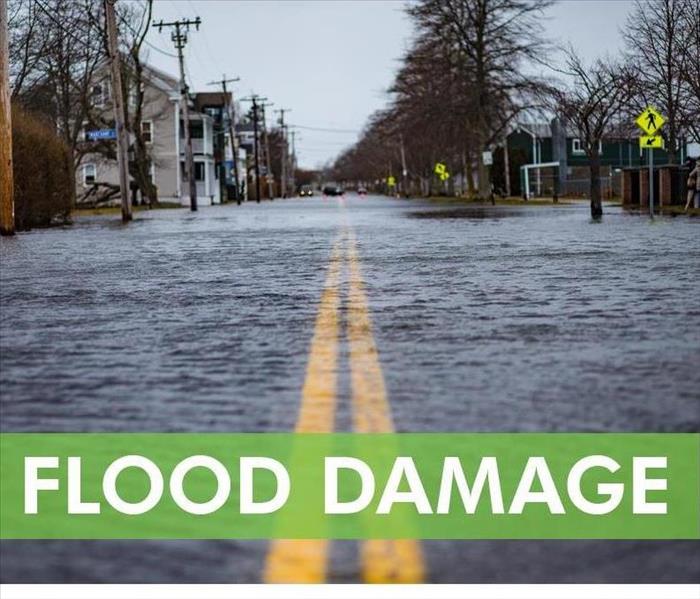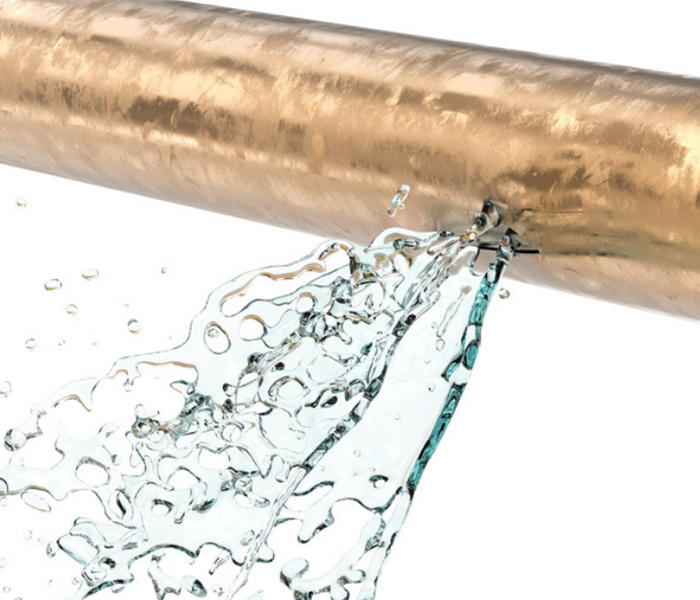Archived Blog Posts
What To Do If You Smell Mold But Don't See It
7/31/2022 (Permalink)
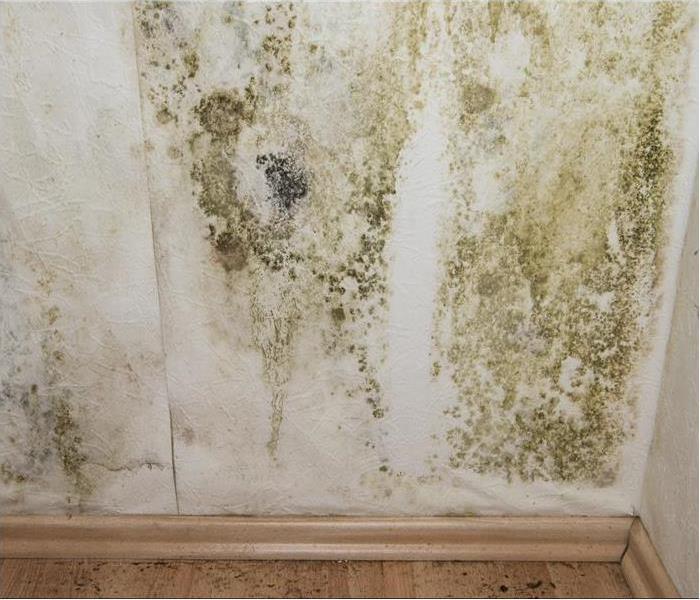 Commercial mold growth
Commercial mold growth
Mold growth is a common problem, so it is no surprise to find the fungus growing in commercial buildings in Oxford, OH. Unfortunately, in some cases, you may have an infestation long before it becomes noticeable. When this happens, the first sign will likely be a mold smell. If your building begins to smell musty, there might already be a significant amount of growth.
Why You Might Smell Mold But Not See It
When you have a mold smell in the building but don’t see anything out of the ordinary, the most likely reason is that the mold is growing in a hidden area. This can include the following:
- Inside walls
- Beneath flooring or carpeting
- Inside drains and other plumbing fixtures
- Inside upholstered furniture or other fabric items
Although mold will sometimes appear as discoloration on surfaces, if it grows in areas such as these, you may only become aware of the growth because of the fungus smell. For this reason, you should not ignore any unpleasant odors that you notice in your commercial building.
How You Should Handle It
If you notice a mold or mildew smell, particularly if there are no visible signs of growth, one of the first steps you should take is to hire a mold remediation company to perform an inspection. Because these professionals have the necessary experience and equipment, they will be able to locate any growth much more quickly and easily than if you were to take on the task yourself. If mold is found, they can then perform removal and cleanup to remove the odor from the building. Once the growth has been removed, you will need to take certain precautions, such as cleaning regularly and reducing moisture, to prevent the mold from returning.
Even if you cannot see any problems, a mold smell in your building will more than likely indicate some kind of fungal growth. It is best not to ignore any musty odors, as mold can spread quickly when not removed right away. Maintaining your building once the mold is removed will help prevent future infestations.
5 Ways To Lower Your Company's Water Consumption
7/20/2022 (Permalink)
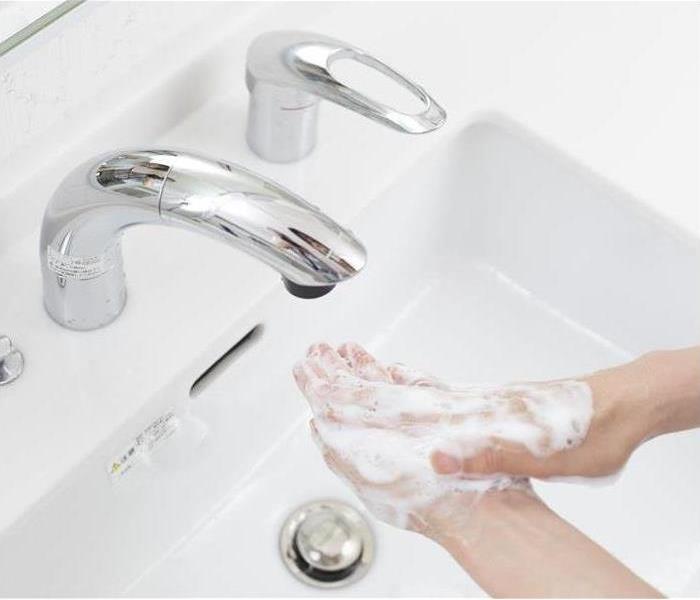 Install touch-free faucets
Install touch-free faucets
Of all the water issues worth discussing, one of the most relevant is conservation. In addition to being good for the environment, lowering your building’s consumption also reduces your water bill.Here Are Five Measures You Can Take To Enhance Your Status As A Responsible Corporate Citizen
1. Install Touch-Free Faucets
Because executives carry their phones everywhere, they often become distracted before leaving the restroom. This sometimes results in running faucets. Touch-free sensors eliminate this trouble entirely. As an added bonus, the spread of germs is greatly limited. While they can be expensive, these water upgrades come highly recommended and are extremely popular.
2. Submeter Irrigation
Faulty irrigation systems have the potential to create seriously destructive water issues. If your business floods, the resulting water damage may necessitate a commercial restoration service provider to repair. Submetering irrigation alerts building managers and landscapers when too much water is being used, possibly indicating a faulty system. The ability to address issues early on could prevent an inconvenient disaster.
3. Add Flush Valves
Toilets installed before 1992 use between three and five gallons per flush. Introducing flush valves dwindles this by up to 40%. Unlike replacing old toilets with low-flush alternatives, you can keep your original commodes and the cost will be minimal.
4. Trade Plants
Interior designers sometimes attempt to counteract the industrial feel of office buildings with trees and other leafy offerings. Some vegetation needs to be watered more than others. Try less thirsty options, such as sago palms, spider plants, or orchids.
5. Change Urinals
Although they require different cleaning methods than traditional urinals, consider ones that are water-free. With one training session, your cleaning crews will have no trouble understanding how to handle them.
Addressing these common water issues will work wonders in lessening the amount your office in Hamilton, OH, uses. For the sake of the future, implement as many solutions as possible.
How To Avoid Musty Smells In Your Home
7/15/2022 (Permalink)
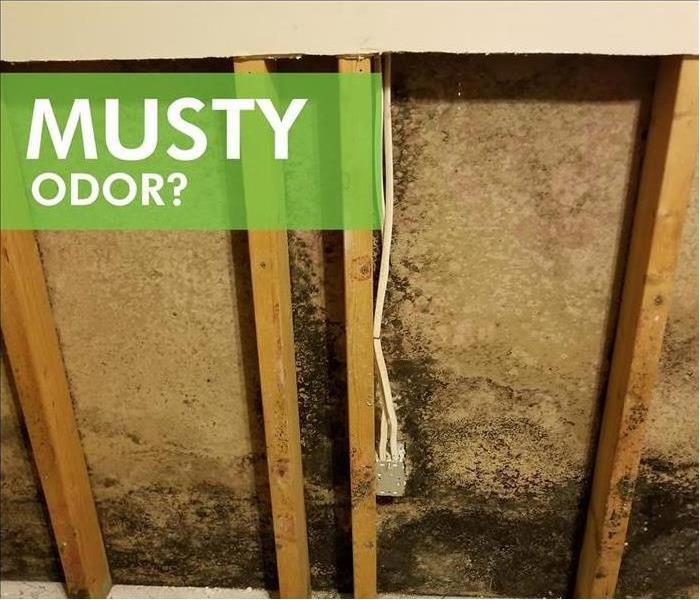 Serious flooding can affect your home and cause foul smells from mold growth.
Serious flooding can affect your home and cause foul smells from mold growth.
How To Avoid Musty Smells In Your Home
When storms cause serious flooding and affect your Morgan Township, OH, home, you may notice several different types of foul odors in the aftermath, even when the waters recede. From mold growth to sewage chemicals, the flooding may leave your home smelling less than pleasant. Learning to identify these odors can be the first step to finding and eliminating their cause.
Musty Smells
If you detect an odor like wet dirty laundry after a flood, then you may be dealing with mold. There are many different types of fungi that can take hold after a flood, and many can develop as soon as 24 hours after the event. Mold does not require sunlight to grow and may grow unchecked in a variety of locations:
- Behind drywall
- Around insulation
- Under carpeting
Having your home inspected after a serious flood can help to uncover hidden mold.
Sewer Odor
The strong, bitter smell of a sewer is hard to mistake for anything else. The odor may also smell like rotten eggs, especially if a nearby sewer has malfunctioned and sewage loss caused a flood in your home’s basement. Because any standing water in your home may contain contaminants and bacteria, you may want to seal off the area until you can call a water damage and mitigation service to come to drain it away and deodorize your home so the offensive smell from the flood water does not linger.
Dirt or Mud Smells
Serious flooding can bring silt, dirt and debris into your home. The moisture it contains can also encourage increased mold growth. You may detect an earthy, fishy or wormy odor from dirt or mud left behind in the wake of a flood. Your flood technicians can remove this debris and offer you options for odor removal as well, such as using ozone machines to clear the air.
Serious flooding in Morgan Township, OH, can affect your home and cause foul smells from mold growth and dirty standing water. Learning how to identify different odors can give you a head start on cleanup efforts, especially once help arrives.
4 Tips for Maintaining Your Smoke Alarms
6/27/2022 (Permalink)
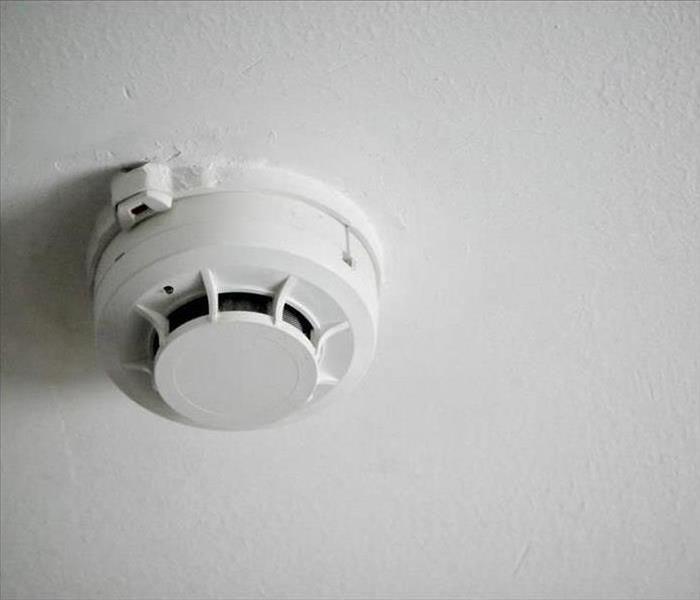 A properly working fire alarm is key for keeping you safe from flames.
A properly working fire alarm is key for keeping you safe from flames.
Fire Alarm Tips
Millions rely on smoke detectors to alert them of a fire in their home, but are you aware of how many you'll need or how to maintain them? Here are four important fire alarm tips for preventing a disaster in your Reilly, OH, home.
1. Determine How Many You Need
First and foremost, you should determine how many smoke alarms you currently have and if you require more. Ideally, each home should be equipped with an alarm inside each bedroom and outside every sleeping area. There should be at least one on every level of a house, including basements. Do a walkthrough of your home to pinpoint alarm locations and determine if you require more.
2. Understand Which Fire Alarm Sensor You Have
There are two types of alarm sensors: photoelectric and ionization alarms. The former is geared toward detecting smoke damage and slow-smoldering fires, while the latter better detects fast-moving flames. It's advised to have both types of sensors within your house as you cannot predict which type of fire danger will occur.
3. Rotate Batteries Regularly
For optimal performance, change the batteries in every detector in your house roughly every six months. This ensures your alarm will not fail you in an emergency. If you don't follow this timeline, most models will let you know when it's time for a replacement by sounding off high-pitched beeps.
4. Keep Records of Alarm Installation
Just like their batteries, fire detectors don't last forever. It's advised to replace your alarms about every ten years, so keep a record of when they were installed to determine when it's time to replace them. Insufficient alarms can leave a fire not only endangering your family but destroying your home to the point where only fire damage restoration professionals can repair it.
A properly working fire alarm is key for keeping you safe from flames. Make sure your home has enough sensors and keep up with routine maintenance for maximum safety.
Tips for Troubleshooting Your Commercial Underground Sprinkler System
6/19/2022 (Permalink)
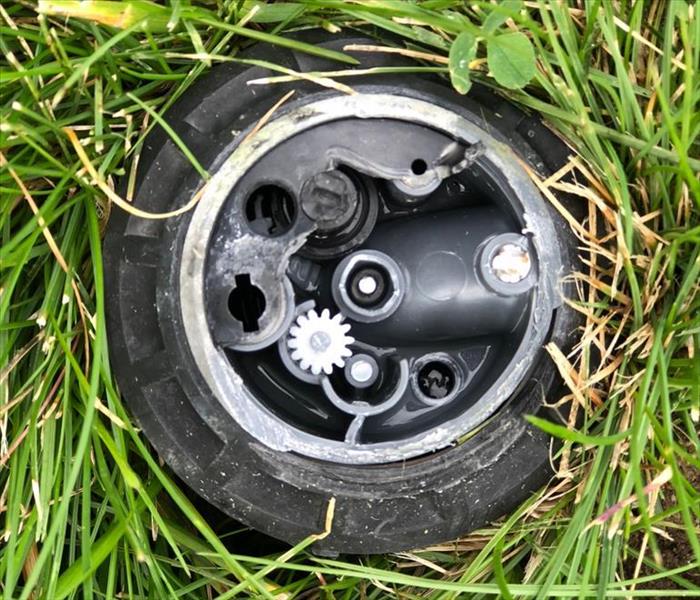 Check the sprinkler heads.
Check the sprinkler heads.
Troubleshooting Techniques for Commercial Underground Sprinkler Systems
Installing an underground sprinkler system at your commercial property in Lemon Township, OH, makes your property more appealing to potential customers and clients. If the system is working properly, it can save you a lot of time watering and maintaining your lawn. If the system fails, however, it can cause a huge headache for your maintenance staff. Thankfully, there are some easy troubleshooting tips to try.
1. Look for Cracks in the Pipes
Cracks in the supply line of an irrigation system are quite common. As trees grow, their root systems can damage and crack the plastic pipes. This allows the pipe to fill with tree roots. Low water pressure is one of the most common results.
Property that sees excessive foot and bike traffic may also be susceptible to sprinkler damage. The added pressure can force the soil to crack the pipes.
If you spot pooling water in a specific area, turn off the water and dig down to the pipe. Cut the pipe down to the leak, grind the ends and install a repair fitting.
Broken pipes and other irrigation problems can cause significant flooding and damage to your property. If you see signs of water damage, contact a water damage cleanup professional right away.
2. Check the Sprinkler Heads
It is a wise idea to conduct routine maintenance on your irrigation system. Sprinkler heads should be inspected quite frequently for cracks and damage. Debris and dirt should be removed periodically as well. Replacing a broken head is quite simple and can prevent a small issue from becoming a huge problem.
3. Inspect the Sprinkler Zones
If a zone is not turning on, there may be an electrical problem. If your maintenance staff employs an electrician they may be able to remedy the situation. However, it may be necessary to call a licensed electrician to inspect the irrigation system.
Keep your underground sprinkler system working well using some smart troubleshooting tips.
Benefits of an Electronic Claims Service for Commercial Disasters
6/6/2022 (Permalink)
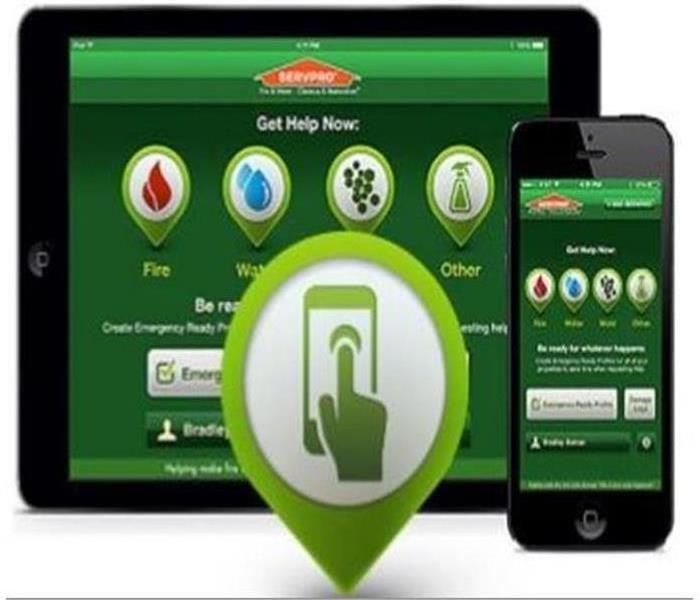 SERVPRO offers an electronic claims service.
SERVPRO offers an electronic claims service.
Benefits of a Commercial Disaster Electronic Claims Service
An insurance claim for a commercial disaster can be an unwieldy document, running multiple pages and containing a long list of details, estimates, and costs. When the information is compiled in a confusing manner or consists of handwritten notes, the insurance process is likely to take longer and it will probably contain inaccuracies. Your company in Layhigh, OH, likely depends upon insurance money after a disaster, to help pay for repairs and replacement equipment and inventory. An organized electronic claims process using the latest in digital technology saves your company time and money.
Working With An Established Restoration Company
The SERVPRO name is worth seeking out in the aftermath of a disaster. The franchise has been a commercial damage mitigation leader in the restoration industry since 1967 and it is also a preferred vendor for many insurance providers in the U.S. The company will also help you manage your insurance claim with a digital process that confers many valuable benefits:
- Maximizes the satisfaction of insurance companies and the insured
- Values transparent communication among all parties
- Provides digital job files for completed work
- Names a single point of contact to answer all questions
These steps make sure an insurance claim will be a priority. It will never be an afterthought that takes a backseat to other aspects of recovery.
Coordinating With the Insurance Agent
Your company will need to speak with insurance professionals and restoration managers throughout the restoration. This is made easier and more efficient with the use of digital files and an orderly, established process. The agent will get the necessary information to move the claim forward, and you will benefit by being part of a system that measures and values customer satisfaction at each step.
Without a proven process, an insurance claim can go awry in several ways. An electronic claims service makes sure this does not happen.
Where To Safely Put Your Space Heater
5/25/2022 (Permalink)
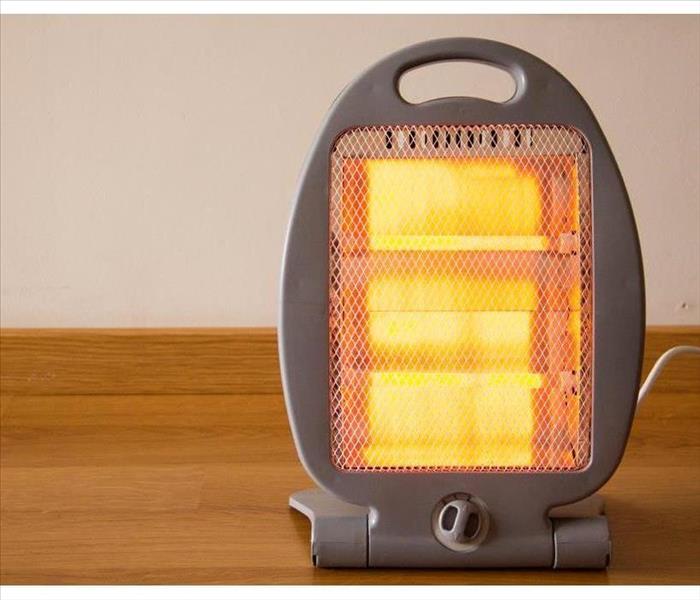 Place your space heater in a safe place.
Place your space heater in a safe place.
Place Your Space Heater Safely
If you are like many people, then you probably use a space heater to stay comfortable when the temperatures drop in Millville, OH. As convenient as these little heat blasters may be, though, a burned space heater can also be deadly. Every year, approximately, 25,000 residential fires start because of them.
While there are several ways you can reduce the risk of this kind of fire damage, one of the top things to consider is where you put the heater. To lower the chances of needing a smoke cleanup team the next time you try to warm up your house in the morning, try one of these locations instead of the bed or the carpet.
In the Bathroom
While bathrooms often do not have carpeting, you still need to consider flammable furnishings such as:
- Rugs
- Window curtains
- Shower curtains
- Towels
When you are using your heater in the bathroom, make sure it stays on the tile and away from any cloth or paper that may be nearby.
In the Bedroom
When it comes to the bedroom, there are probably more opportunities for a burned space heater to occur. If you have carpet, you should reconsider putting your heater in a bedroom at all. Not only does this device need to stay on the floor, but it should only be placed on a hard surface like wood, tile or laminate. Because it is unsafe to sleep while a space heater is on anyway, keeping it away from your resting place is probably a good idea.
In the Living Room
The living room is another location where you can find a lot of potential fire starters, yet it is also a common space for families to gather. If you want to heat up this area of your home, look for a suitable place to set the heater. If you have a fireplace area or another part of the room with solid flooring, that should be the spot.
There are many ways to avoid a burned space heater. Knowing where to put it is one of the simplest and most effective.
3 Steps To Take After Roof Damage
5/18/2022 (Permalink)
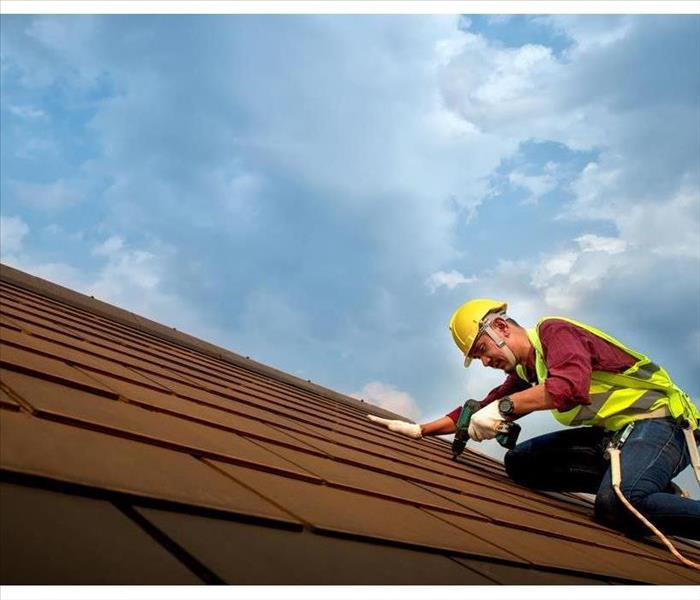 Roof repair in Ross, OH.
Roof repair in Ross, OH.
Three Steps For Repairing Your Roof
When a storm rolls through Ross, OH, it can leave an array of destruction and debris in its wake. If recent weather events find you in need of roof repair, here are the three steps to take first.
1. Contact a Roof Damage Mitigation Company
Before you can remedy any rain, hail or wind damage, you need to put a stop to the damage. Just because a storm subsides doesn't mean the issue is under control. Prompt mitigation of storm damage is the best way to prevent larger and more expensive problems from developing the next time it rains.
Given the location of the damage and the scope of the mitigation effort itself, it's a job best left to professionals. Before you do anything else, contact your local storm damage restoration company to schedule a prompt inspection of your roof and any other affected areas.
2. Remove Wet Belongings
If water entered your home during the storm, remove any wet items and take them outside to dry. Proceed with caution, though: Storms that require roof repair can also cause structural damage that may lead to falling debris or collapse. When in doubt, wait it out.
3. Begin Airing Out the Affected Area
A wet attic needs to be dried promptly — not only the items stored inside but also your home's building materials. If your attic or crawl space has windows you can open, open them. Do you have central air? Turn on the fan so it runs constantly. Dust off any box fans or other portable blowers and enlist their help, too. If the area is difficult to reach or you suspect structural damage, don't be a hero: Sit tight and stay dry until the professionals arrive.
No one's weekend plans ever include roof repair. If your roof suffers damage, acting quickly and intelligently can expedite the process and minimize your stress.
Keep These 4 Things in Mind When Your Toilet Overflows
5/10/2022 (Permalink)
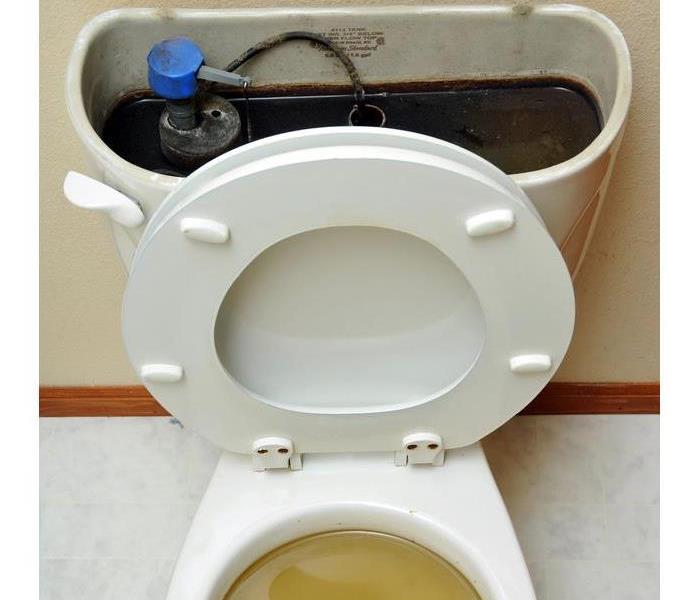 Sewer damage in a home in Trenton, OH.
Sewer damage in a home in Trenton, OH.
Toilet Overflow
When you have sewer damage in your Trenton, OH, residence from a tree root or a blockage, the water in your toilet backs up. You have a stinky mess that turns your house into a miserable sewage dump. Fortunately, with a little knowledge and help, you can restore your dwelling. Keep these things in mind when your toilet overflows.
1. Use a Sewage Company for Clean Up
When sewage overflows from a flooded toilet, that mess can soak into the walls and flooring leaving a smell that can't be masked by deodorizers. Seek the services of odor removal specialists who don't mask the stench, but completely remove its source, restoring your home to its preflood condition.
In the meantime, you need to stop the flood from that sewer damage.
2. Close the Toilet's Flapper
Inside every toilet at its base is a flapper that stops the flow of water from the tank into the bowl. Push the flapper down to stop the flooding.
3. Raise the Toilet's Float
A bulb attached to a rod, also known as the float, controls the amount of water coming into the tank. When it raises to a certain level, the water will stop, so raise the float to shut off the flood and prevent further sewer damage.
4. Cut Off the Toilet's Water
At the base of your toilet is a valve that you can use to either turn the water on or off. Once you've stopped water from going from the tank into the bowl, make sure no more water goes into the tank by turning off the valve. Do this last, as the valve is sometimes hard to turn.
Plunge your toilet to force some of the water down and keep it from splashing out of the bowl. With help from professionals, your bathroom will be good as new.
What Is Category 3 Water Damage?
4/25/2022 (Permalink)
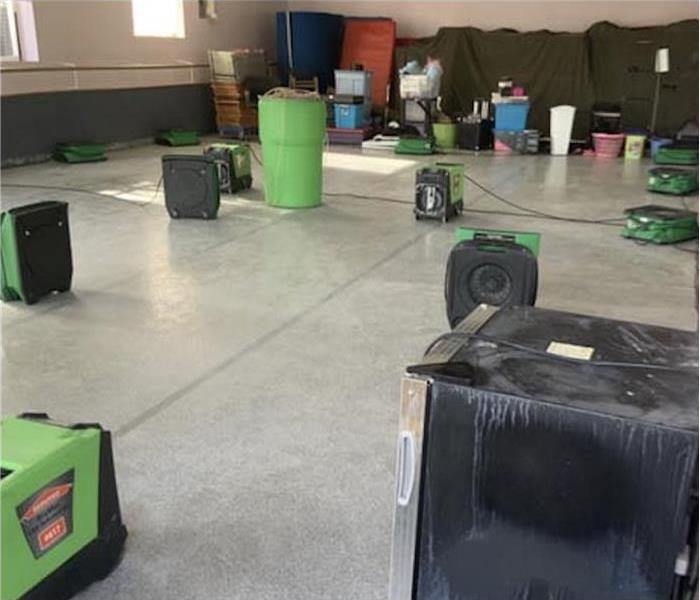 Commercial water damage clean-up in Hanover Township, OH.
Commercial water damage clean-up in Hanover Township, OH.
If your commercial property in Hanover Township, OH, has been affected by a flood or other water issue, chances are you are dealing with some level of water damage to your building. Depending on the type of water issue you have had, you may be dealing with category 1, 2 or 3 water damage. If you have category 3, the most severe type, there are a few things to know to help you clear it out quickly and safely.
What Is Category 3 Water?
Category 3, or black water, is the most contaminated level of water damage. lt is highly contaminated with bacteria and microorganisms and can come from many places, such as:
- A sewage problem, such as a backed-up toilet, sink or shower drains
- Burst pipes
- Standing water from a natural disaster, such as a flood
What To Do If You Find Black Water
If you have a sewage problem or water damage from a flood, you should call in a professional water restoration company to help you deal with the aftermath, as there is a chance you have black water. Although it is safe to try to remove water if it is clean water, black water should only be cleaned by professionals who are wearing the proper personal protective equipment. Keep yourself and any building residents away from the source of the water damage until help arrives.
How To Restore Your Building
A restoration company will help you begin the restoration process for your commercial building. Any items inside your building that have been affected by the water damage or may have absorbed the water may have to be replaced. Ensure that everything has been sanitized and cleaned before building residents return.
If your commercial building has been affected by water damage, it's important to identify the category of water damage your building has been impacted by. Calling in a restoration company. quickly can help you get back to normal as soon as possible.
Mold Removal Expectations
4/16/2022 (Permalink)
 Mold removal
Mold removal
Expectations for Mold Removal
Finding mold in your Oxford, OH, business is frustrating. As a savvy business owner, you know how vital it is to get the problem taken care of as soon as possible. On the flip side, time is money for continued business success. Understanding the mold removal process and getting the right help are keys to a faster recovery.
The Remediation Process
When it comes to mold growth, every situation is different. In most cases, the remediation process takes three to seven days. Depending on the location and extent of damage, it may require moving operations off-site during the cleanup. Once an inspection and assessment are completed, you can have the following expectations for mold removal:
- Technicians will be outfitted with safety gear, including a face mask, goggles, gloves and protective suit.
- The affected area will be sealed off with a containment barrier, ensuring spores don’t spread to unaffected areas.
- Unsalvageable materials will be removed, such as portions of drywall, insulation and baseboards.
- Surface areas are treated to kill the mold.
- After physical removal, high-tech air scrubbers or other tools are used to clean the air of any potential spores.
- A sealer or encapsulant may be used to increase resistance to black mold and water damage, as well as control odors.
Expertise Matters
Knowing that mold may easily return if not properly taken care of, finding the right help is essential. If the damage is extensive, it's best to find a certified remediation and restoration company. That ensures they are up to date on the latest standards and processes. It is also important to verify that their technicians are also certified. Along with having the tools and techniques needed for cleanup, they will also be able to make any structural repairs.
While mold removal may mean some downtime, not getting it properly taken care of may mean much more downtime in the future.
How Are Odors Removed After Flooding?
4/11/2022 (Permalink)
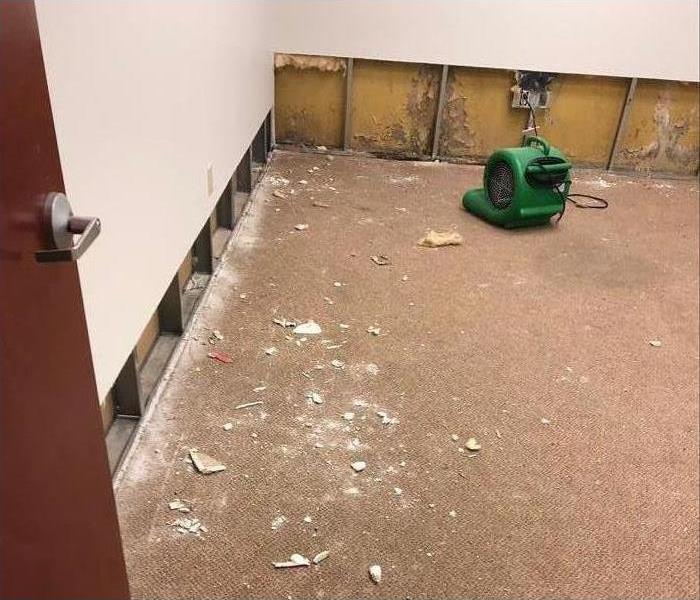 Mold damage behind walls in Hamilton, OH.
Mold damage behind walls in Hamilton, OH.
After a Flood, How Are Odors Removed?
After a flood strikes a business or your commercial building, it leaves a disaster in its wake. Not only does the moisture encourage explosive black mold growth, but a toxic residue is also often left coating everything the floodwaters touch. It’s why buildings smell so awful afterward.
Usually, you’ll need a top restoration expert to inspect and remediate the damage caused by floodwater. They have access to custom sanitizers and equipment to remove toxins, mold and odors. They use a range of methods to get the best results, including
Abrasive cleaning
Dry cleaning
Foam cleaning
Immersion cleaning
What Causes the Odors?
Probably the most noticeable smell is the strong musty odor. This is from mold growth, which loves the inside of buildings. Drywall and wood provide food for the mold, while the mold spores are always all around us. All it needs to grow is excessive humidity.
Floods also frequently leave a toxic sludge covering everything. Items such as ceramic tile and other non-porous surfaces can often be cleaned with a spray and wipe using ordinary sanitizers, but porous items will absorb the water and residue. During a flood, it’s normal to have sewage loss mix in with the flood water which gets everywhere. It’s also responsible for some of the worst odors.
Can Odors Be Removed or Do You Have to Replace Everything?
Using proprietary cleaning agents, restoration experts often can save items instead of replacing them. This not only saves money, it often can save irreplaceable items. SERVPRO leaves your commercial building “Like it never even happened.”
To facilitate the odor removal process, they’ll bring in large-volume air movers and clean everything that was touched by the flood. they can often save essential paperwork and documents, too, using very advanced methods such as freeze-drying and vacuum thermal drying. Future mold growth will also be inhibited by the moisture removal process.
The key is to get reopened as quickly as possible for your business to survive. Your Hamilton, OH, restoration technicians are trained to expedite service for commercial customers.
Odor removal is usually easy and quick for professional restorers. The sooner they start, the more effective it’ll be.
How To Choose a Fire Restoration Company for Your Business
3/28/2022 (Permalink)
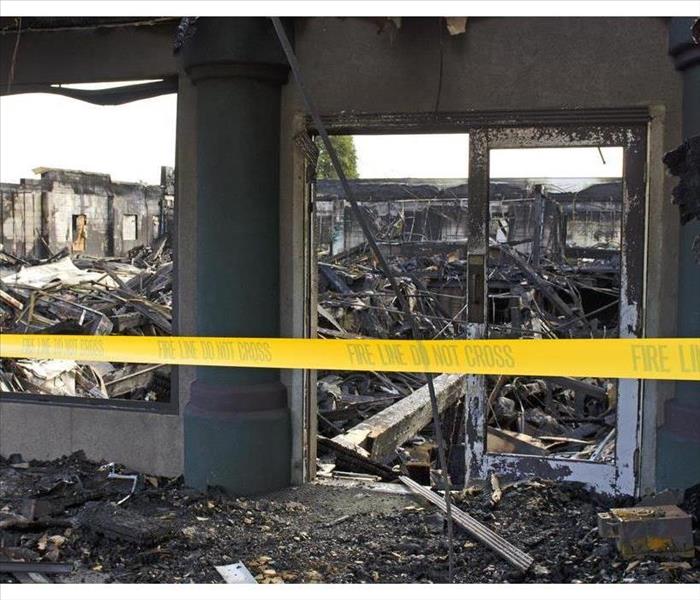 Commercial fire damage in Morgan Township, OH.
Commercial fire damage in Morgan Township, OH.
What to Look for When Choosing a Fire Restoration Company for Your Company
When fire ravages your business in Morgan Township, OH, the damage can seem daunting. A fire damage restoration company assesses the damage done and works to restore the business sooner than you think. Each company should use specific steps to restore the business after a commercial fire. Knowing what to expect can help you choose the right company for your business.
1. Availability
The fire restoration company should be available immediately. A commercial fire is an emergency and the restoration company should be ready to act. Your business needs immediate relief to prevent further damage.
2. Assessment
Once the fire is out, the restoration company assesses the damage left behind by fire, smoke and soot. Without assessing the extent of the damage, the restoration company cannot come up with a good plan for smoke cleanup. The estimated costs depend on how well the company can assess the damage.
3. Prevention
One of the benefits of hiring a professional fire damage restoration services company is preventing additional damage to your property. The company should work to address immediate concerns first. Burst water pipes and roof holes should be a top priority to start mitigating the damage.
4. Clean
Once the immediate concerns are handled, the company can start the clean-up efforts. Soot, dust and smoke cleanup is part of the process. Water from the sprinkler system or burst pipes will be removed. The building will slowly get looking back to normal.
5. Repair
The final step in the fire restoration process is repair. The business may need to replace furniture or flooring if it was too damaged by the commercial fire. Use this as an opportunity to rethink the décor of your building.
Choose a fire damage restoration company that follows these steps. Some companies offer a debriefing after the cleanup is finished. In addition to helping you come up with ways to prevent future fires, the company may recommend new smoke detectors or fire prevention methods.
Tips for Pipe Protection
3/24/2022 (Permalink)
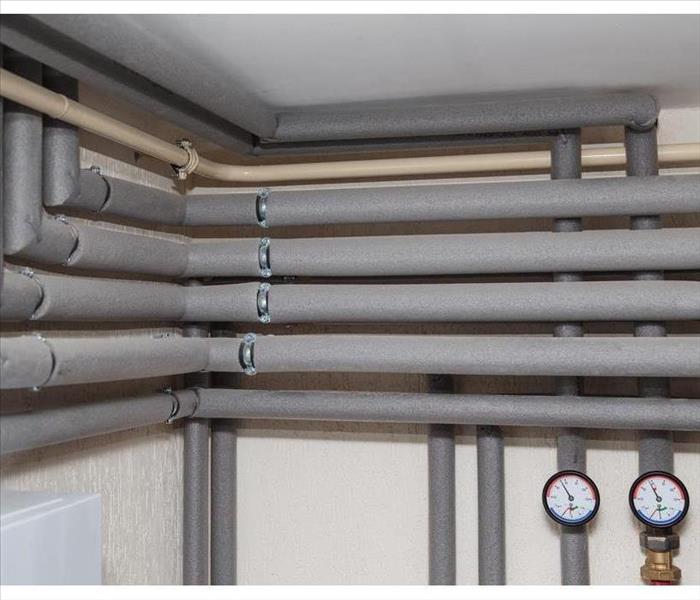 Add insulation to your pipes.
Add insulation to your pipes.
Avoid Bursted Pipes In Your Home
Frozen pipes are often the culprit when homes flood in the winter. Fortunately, prevention of this problem is pretty easy. To keep your home in Reilly, OH, safe from flooding due to busted pipes, try the following methods.
1. Insulate Pipes
The most long-term solution for avoiding pipe freeze and thus the need for water restoration services is adding insulation. You can either add it to the pipes themselves by sliding a fiberglass sleeve over them or you can add extra insulation to the walls. The latter option may even save you money on heating bills!
2. Heat Air
Always keep the heater in your home on if there is a chance that outside temperatures will dip below freezing. Then, you can warm up the air around the pipes by venting the heat from your home into the walls. For pipes that are under your sink, you can keep the cabinet doors open so that the area under the sink heats along with the rest of the house.
3. Open Faucets
Allowing a slow drip from select faucets throughout your home is an easy way to prevent frozen pipes. Moving water is less likely to freeze than standing water, so the constant flow through the pipes works in your favor.
4. Seal Cracks
Another way to increase your home's energy efficiency while also protecting your plumbing is to maintain proper seals in walls, floors, ceilings and windows. Gaps allow wind to get in from outside. By caulking those gaps, you can keep warm air in and cold air out.
5. Apply Heat
Sometimes, the direct approach is helpful. You can use heating tape directly on pipes to heat them up. Whether you choose tape that switches on when it sense the need to do so or tape you can turn on and off manually, pipes that are most vulnerable to freezing are protected.
You can avoid frozen pipes and the mess they can make with these simple methods. Following these five tips can keep your plumbing warm all winter.
3 Proactive Ways To Prevent Plumbing Problems
3/16/2022 (Permalink)
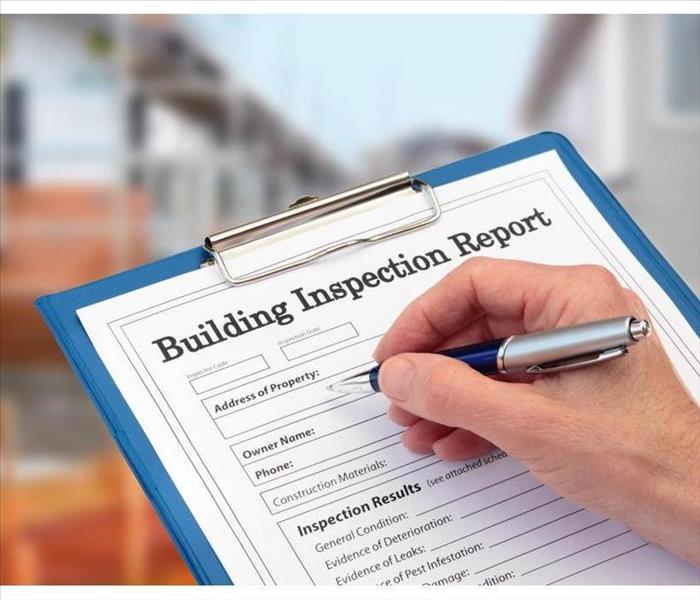 Annual plumbing inspections are sufficient for many commercial buildings.
Annual plumbing inspections are sufficient for many commercial buildings.
Prevent Plumbing Problems
There are several measures a commercial property owner can take to maintain water systems and keep plumbing problems such as pipe breaks and leaks at bay. Proactive maintenance is much more affordable than arranging for emergency repairs at a building in Lemon Township, OH. Here are three ways to keep costs down and ensure a structure has a reliable supply of water and functional drainage.
1. Schedule Annual Inspections
A business or building owner should have a commercial property inspected at least once every 12 months. These checks should include checking the condition of supply lines, the water main and making sure that sewer lines are not becoming clogged. It can also be helpful to confirm the quality of pipe installation and adherence to the most current plumbing codes.
2. Monitor Pipe Condition
During a plumbing inspection, the owner of a commercial property should consult with a plumber about the condition of pipes, including levels of corrosion to avoid a broken pipe or other plumbing problems. If pipes are making loud noises such as knocking, it may be possible to add insulation or support to prevent damage. Property owners should be aware of the material and age of pipes in a building.
3. Maintain Drain Lines
A commercial property owner should post guidelines in bathrooms specifying that only toilet paper is safe to flush. Buildings with commercial kitchens should take measures to reduce the amount of grease that goes down the drain. It may be necessary to have drain lines cleaned by professionals every 18 to 22 months to prevent sewer damage.
Inspections and awareness of the age and condition of pipes such as supply and sewer lines can prevent most plumbing problems. Annual plumbing inspections are sufficient for many commercial buildings in Lemon Township, OH. Restaurants and other businesses with unique drainage demands may need to schedule more frequent plumbing service.
Mitigation Companies vs. Restoration Companies What’s the Difference?
1/28/2022 (Permalink)
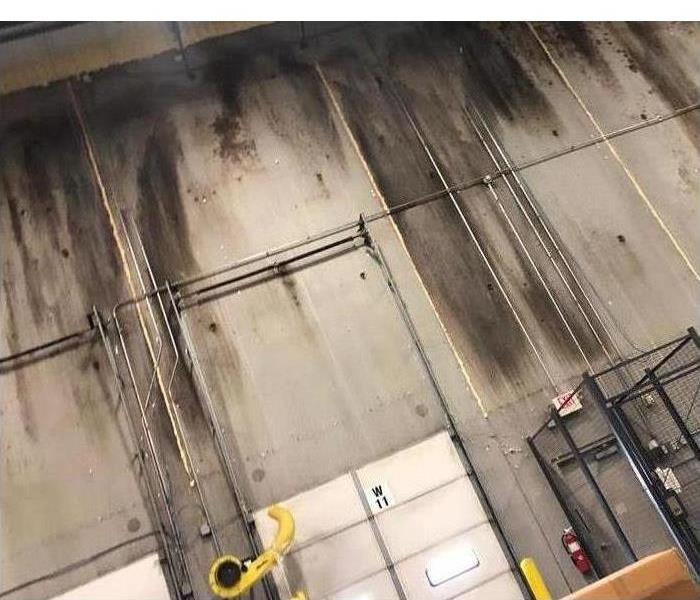 Fire damage in Layhigh, OH.
Fire damage in Layhigh, OH.
Mitigation or Restoration
Mitigation or restoration - these are common terms to come across when handling fire damage cleanup, and for the novice, it may not seem like there’s much of a difference. But the fact is, there are significant differences that can have major financial impacts: Some insurance plans cover mitigation services after a disaster and others only cover restoration services. Not knowing the difference can cost you big. Learn more about the difference between these two services and how they can help your Layhigh, OH, business in the wake of fire damage.
What’s Mitigation?
Many companies advertise themselves as fire mitigation specialists. Mitigation generally refers to reducing the severity of something, in this case, the impact of fire damage. Mitigation companies try to limit ongoing damage and stave off continued losses using tools and methods like:
- Boarding up windows
- Adding roof tarps
- Removing water from firefighting efforts
- Securing the structure against collapse
It’s important to understand that they do not repair or replace, but rather, ensure the disaster doesn’t continue to have consequences.
What’s Fire Restoration?
After mitigation, it’s time for restoration. Restoration experts aim to rebuild and repair your property. They may replace walls damaged by fire or floors and carpets damaged by standing water. They can combat mold, odors and infestations, while making your property livable again. The key difference between restoration and mitigation is how it enables you to move forward. Mitigation sets the stage for fire cleanup. Restoration allows your business to get back to normal.
Fire restoration efforts pair naturally with mitigation and it’s not a question of one being better than the other, rather, which one you need at the time. The fact is, you’ll probably need both, but you may need to figure out which one insurance covers and which one you’ll need to finance. Talk to your insurance adjuster to learn about your options.
How To Keep a Frozen Pipe From Breaking
1/22/2022 (Permalink)
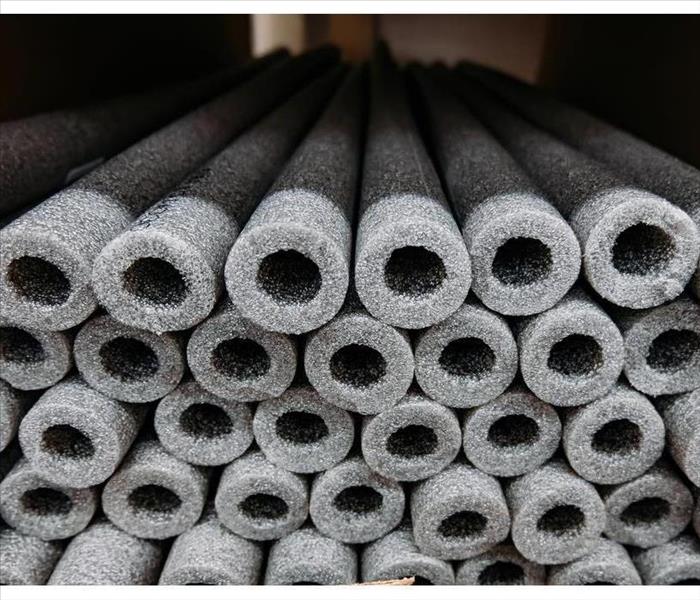 More long-term solutions include pipe insulation.
More long-term solutions include pipe insulation.
Steps To Prevent a Flood
Water damage can be expensive to repair and can lead to secondary damage if it’s not fixed promptly. Frozen pipes are one of the leading causes of water damage in homes in Millville, OH, but if you identify and unfreeze the pipe before it ruptures, you can often save yourself the hassle of having to fix the pipe and clean up its aftermath. Follow these steps to prevent a flood.
1. Finding the Pipe
You may find that one faucet is working and another is not. This could be a sign of a pipe freeze between the two fixtures. You are more likely to find a frozen pipe near certain areas:
- Crawlspaces
- Attics
- Basements
- Outdoors
- Air vents
2. Inspecting the Pipe
To make sure you don’t already have a leak, you need to inspect your frozen pipes closely. Make sure that the surface doesn’t show any signs of cracks. If you find a crack, it is important to patch it before warming the pipe up. Turn off the water main to minimize leaking while the pipe is repaired.
3. Running the Faucets
If you don’t see any cracks, you can turn on the faucets. This gets water running and helps the faucet warm up gradually, as moving water does not freeze as readily as still water.
4. Warming the Pipes
There are several ways to warm up a pipe that holds frozen water. You can use a hair dryer for immediate warmth. More long-term solutions include heat tape and pipe insulation. If you can redirect warm air from your heater during the winter or from outside during warmer months inside your walls, this can keep pipes from freezing by warming the space around them.
If your frozen pipes do cause water damage, water restoration specialists are here to help. The best solution, however, is to prevent flooding in the first place by keeping pipes warm.
Your Flood Preparation Guide: What To Do When a Major Storm Is On the Way
1/11/2022 (Permalink)
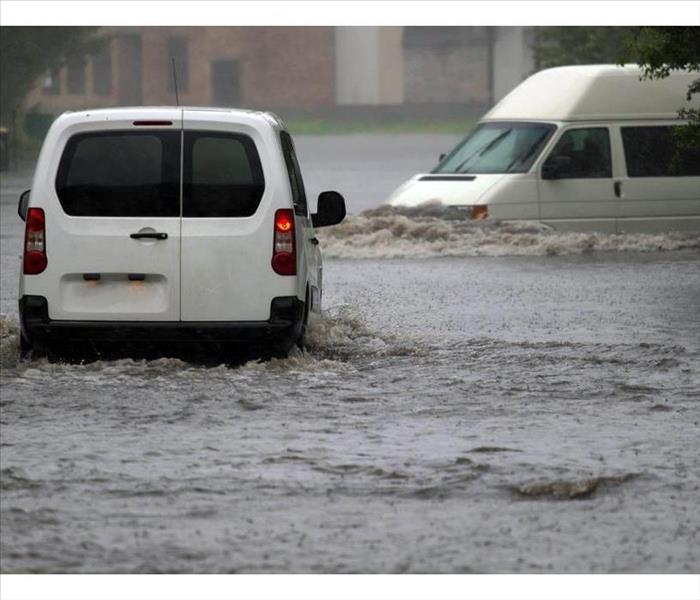 Do not drive on a flooded street.
Do not drive on a flooded street.
Storm Preparation Plan
If you live in a flood zone, it is imperative that you have a storm preparation plan in place that will keep both you and your home safe from flood water and the damage it can cause. If you don't currently have a plan in place, now is the time to create one, as storm season is well under way in most parts of the country, and floods can come out of nowhere and may do the following:
- Result from excessive rain or snow, coastal storms, overflows, or storm surges
- Develop slowly or quickly, such as a flash flood
- Cause power outages, resulting in costly water damage, disrupt transportation and create landslides
Because floods are often the result of common natural events, such as rain, and because they can come on suddenly, the best thing you can do for your safety is prepare.
What To Do When You Are Under a Flood Warning
If your area is currently at risk of being inundated by flood water, there are certain measures you should take to stay safe. Some such measures include the following:
- Do not attempt to navigate the flood waters via any means, whether by walking, driving, swimming, or boating.
- Steer clear of bridges that go over fast-moving water.
- Evacuate your home if ordered to do so.
What To Do During a Flood
If your home is at risk of becoming flooded, move to higher ground immediately, but only if there is a clear path out of the flooded area. Otherwise, stay where you're at. If you're trapped in a flooded building, turn on your radio and tune into NOOAA Weather Radio, EAS or the local alerting system for instructions on how to proceed. DO NOT go into the attic, as you may become trapped by rising water. If necessary, climb out onto the roof and flag for help.
What To Do After a Flood
If flood water has caused excessive water damage to your home, contact your Ross, OH, flood remediation team as soon as the waters have begun to recede. The right team can help dry out your home and restore it to pre-flood condition.
What Every Business Owner Should Know About Polybutylene Pipes
12/29/2021 (Permalink)
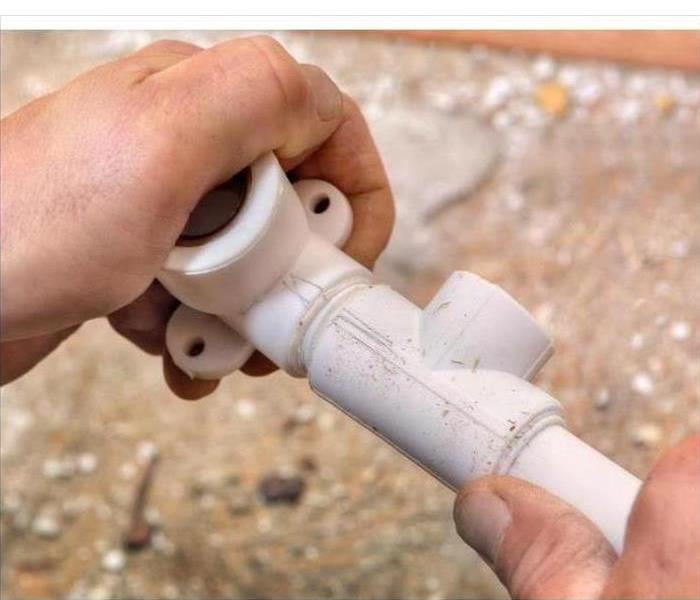 Owning a building with polybutylene pipes can be extremely costly.
Owning a building with polybutylene pipes can be extremely costly.
Polybutylene Pipes
When you purchased your commercial building, you likely completed an extensive inspection to verify that the structure was a reasonable investment. Unfortunately, any building in Trenton, OH, built between 1978 and 1995 may have a potentially serious problem lurking within its walls: polybutylene pipes.
Once considered an innovative advancement, these plumbing lines are no longer considered a viable, long-term option. In fact, any building containing these supply lines may be extremely vulnerable to water damage.
Benefits of Polybutylene
These pipes were a popular choice among builders for several reasons:
- Enhanced flexibility
- Resistant to corrosion and calcification
- Resilient under high water pressure
- Less noisy than traditional components
This form of plastic tubing was also cheaper than other alternatives.
A Serious Problem
Unfortunately, after approximately two decades of use, the plumbing community discovered that polybutylene may not be an ideal choice after all. After 10-15 years of exposure to chlorine and other water-soluble oxidants, the plastic tubing is susceptible to internal deterioration and flaking. Over time, a compromised interior makes these pipes increasingly vulnerable to cracks and potentially destructive leaks.
Devising an Action Plan
Because these tubes deteriorate from the inside, it can be difficult to detect a problem in advance. If you own an older building and are concerned about the integrity of your plumbing system, you should contact a licensed plumber and request an evaluation.
If your system utilizes potentially compromised pipes, it’s important to carefully evaluate your options. Because considerable deterioration can occur within 15 years, delaying a remedy may result in extensive water damage. Although it may be costly, your best option may be to install new plumbing lines.
A Costly Situation
Owning a building with polybutylene pipes can be extremely costly. Although replacing plumbing lines can be expensive, this type of plastic tubing is likely to fail and leak. To help safeguard your business investment, it’s important to understand your risks and devise a strategy to resolve the issue.
How Many Days Does Water Damage Cleanup Take?
12/22/2021 (Permalink)
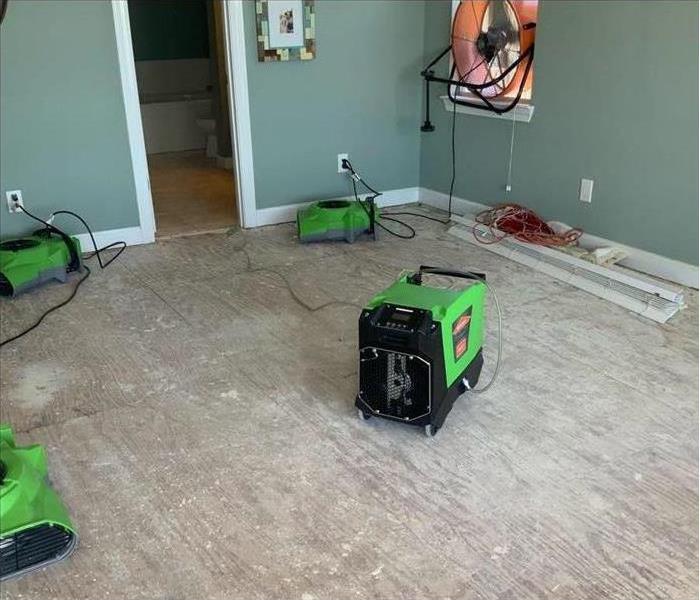 Drying Equipment is crucial in the water damage restoration process.
Drying Equipment is crucial in the water damage restoration process.
Water Damage Cleanup
If unexpected bursting pipes in your home created a flood recently, you may be wondering how long it will take to clean up the water damage. It is easy to understand why a proud homeowner wants to know if and when things will be back to normal. Keep reading for the answers you are looking for.
Typical Cleanup Timeframe
A good Hanover Township, OH, water damage restoration company should be able to take care of the cleanup process in about three to five days. Many technicians are able to come to your home on an emergency basis to quickly survey the situation and develop a thorough remediation plan for your bursting pipes disaster. Although the steps may vary according to circumstances, they often include these interventions.
- Remove soaked carpeting, curling floor tiles or ruined wood floors.
- Drill holes and use instruments to check moisture in the subflooring and drywall.
- Use commercial fans and dehumidifiers to remove dampness.
In some cases, these professionals will be able to restore valued photographs, important papers and other hard-to-salvage items. Keep in mind that you should also find a way to fix the broken pipe or pipes during this time to prevent further damage. If you are not able to repair the problem yourself, contact a qualified professional to take care of the matter to protect your home and belongings to the best of your ability.
Exceptions in Special Circumstances
Sometimes, your home will require more thorough cleanup that could take extra time beyond what is normally required by a restoration team. For example, a soaked wood floor may require between seven and ten days for proper renewal. Talking to the on-site team about their cleanup plan and expected timeframes are your best bet if you want to know what the process will involve.
Bursting pipes and moisture destruction can be tough for anyone to face, but having the help of knowledgeable professionals can make a difference in most situations. A damage remediation team that knows the unique challenges of emergency flood circumstances can help the restoration process go as smoothly as possible for you, your family and your Hanover Township, OH, home.
When To Schedule Furnace Maintenance
12/10/2021 (Permalink)
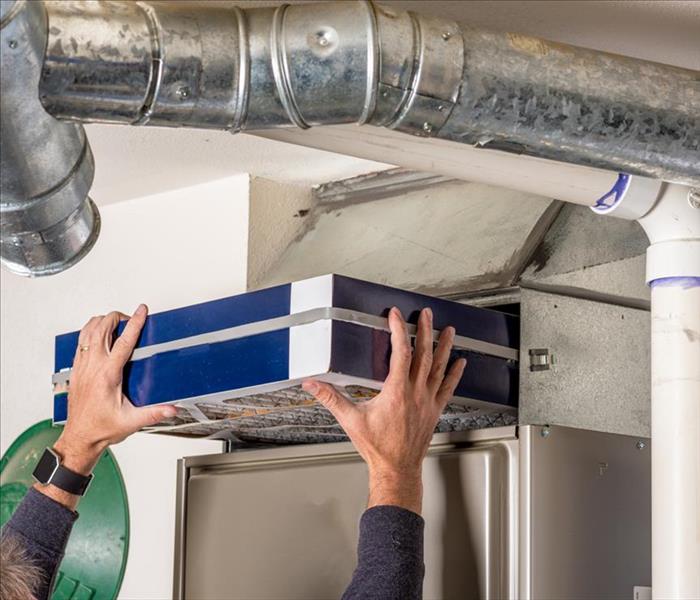 A furnace requires regularly scheduled maintenance to operate safely.
A furnace requires regularly scheduled maintenance to operate safely.
When Should Furnace Maintenance Be Scheduled?
Regular furnace maintenance can promote safety and keep heating costs low. Experts recommend scheduling a professional inspection at least once a year and performing regular checks and maintenance on a furnace in a home in Oxford, OH. Follow these guidelines to prevent a heating fire and the need for fire cleaning.
Once a Year
Schedule an appointment with a furnace service every year before the weather gets cold. An appliance specialist should test the factors that impact the operation of a furnace, such as the static air pressure, gas pressure, combustion gases and temperature rise. Furnace components that should be inspected on an annual basis include:
- Blower motor and wheel
- Condensate drain and trap
- Drainage system
- Electrical wiring or gas lines
- Heat exchanger
An inspection may cost anywhere from $80 up to $150. This preventative investment is less expensive than cleaning up after a fire. Make sure that the furnace service technician checks and cleans every component that is necessary to keep the furnace functioning safely.
Several Times a Year
A homeowner should also regularly check the condition of a furnace and clean any components that have accumulated dust or debris. Every few months, particularly during the winter, it is a good idea to take a look at:
- Burner flame and ignition
- Blower door seal
- Filters
- Air intake
- Ventilation system
Use a vacuum to remove buildup from furnace components. A clean furnace will function at maximum efficiency with less risk of fire.
A furnace requires regularly scheduled maintenance to operate safely. In addition to a professional inspection every fall, homeowners should also perform periodic checks when the furnace is being used daily or frequently. If a heating fire breaks out, it will be necessary to replace the furnace. A fire cleaning restoration and smoke cleaning service can also restore damage caused by a furnace fire at a residence in Oxford, OH.
Why Basements Flood
11/22/2021 (Permalink)
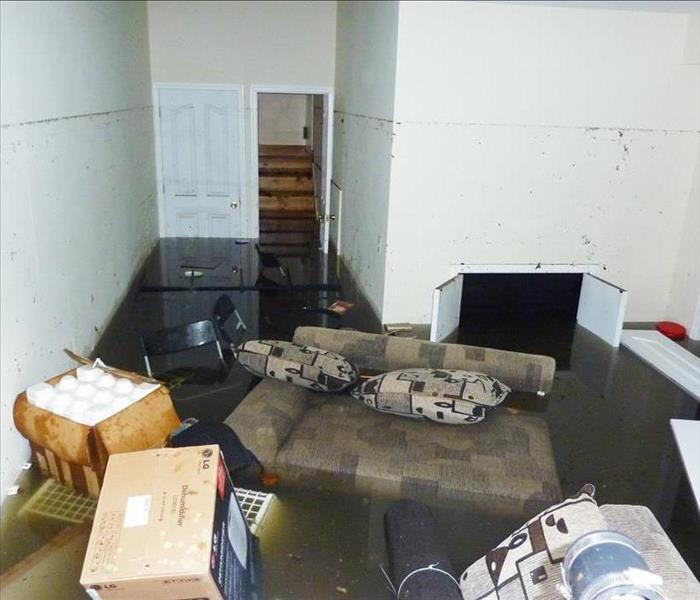 If your basement is flooded contact a professional as soon as possible.
If your basement is flooded contact a professional as soon as possible.
Storms and flooding in Hamilton, OH, can lead to water buildup in the basement. As a homeowner, it’s important to understand what to do in these situations, how water gets down there in the first place, and ways to help prevent lasting damage.
How Water Gets Into the Basement
The first reaction for many when looking at a basement flood is to wonder how the water got there in the first place. There are several factors that may come into play.
- An improperly functioning sump pump
- Poor drainage around basement walls
- Cracks or holes in the walls water can leak through
- Issues with basement plumbing, such as a water heater
- Heavy storm rains
Water buildup in the basement can cause further problems for your home. As water tends to flow in the least resistant path, it will find holes and cracks to flow through and continue to puddle at the lowest point unless otherwise prevented.
How To Take Care of Water in the Basement
If you find flooding in your basement, it’s best to contact a professional as soon as possible. He can assist with pipe repair, if needed, take care of the water removal, and assess your basement for the source of the problem. Many services also offer help with the drying and sanitation of the affected areas, as well as repair and mold remediation.
How To Prevent Floods
In some cases, there may be ways you can help prevent damage from a basement flood. These can include installing a sump pump if you do not currently have one, regularly checking to make sure plumbing is intact, and sloping your yard and landscaping away from your home. A professional may have further ideas on ways to help prevent water damage.
Understanding the how and why of basement flooding can help you contact the team you need for repairs and restoration. Knowing these things can also help you take the steps necessary to help protect your home.
3 Steps To Clean Up a Commercial Fire
11/22/2021 (Permalink)
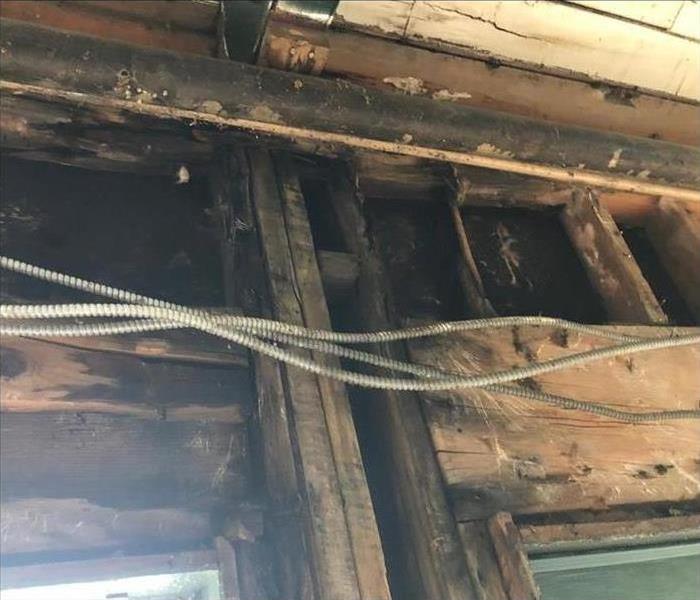 Structure experienced fire damage in Oxford, OH.
Structure experienced fire damage in Oxford, OH.
Three Steps to Clean and Restore a Building
A fire can destroy the contents and structure of a commercial property in Oxford, OH. Owners should hire restoration professionals who have extensive experience cleaning and restoring fire and smoke damage. These specialists will follow three general steps to clean and restore a building.
1. Remove Damaged Items
It is necessary to remove contents from a structure that has suffered fire and soot damage. Start by sorting these items based on whether cleaning is practical or possible. Structural mitigation can only start after contents have been disposed of or moved off-site to be cleaned and stored until restoration is complete.
2. Clean Up Ash and Soot
Fire damage mitigation experts rely on a variety of specialized methods during the cleaning process. Surfaces and contents may undergo dry-cleaning, wet cleaning, foam treatment, immersion, ultrasonic waves, or abrasion.
Smoke damage calls for eliminating residues on walls and ceilings and allowing these surfaces to dry prior to repainting. Depending on the amount of damage caused by the fire suppression method, it may also be necessary to tear out and replace porous building materials, such as drywall.
3. Repair and Restore
During the final phase of restoration, cleanup experts may rely on professional air filtration equipment such as an HVAC air scrubber or clean ducts and vents. Odor elimination equipment such as an ozone or hydroxyl generator, a vapor modification system, or a thermal fogger may also be used. This step involves rebuilding, repainting, and restoring contents that have been cleaned or replaced.
A fire restoration and smoke cleaning service will proceed through these three broad steps to clean and restore a damaged building in Oxford, OH. The length of this process may vary depending on the severity of the fire and smoke damage. Property owners should request a schedule during the initial consultation and check in to see when the work will be finished.
3 Tips for Roof Preservation
11/9/2021 (Permalink)
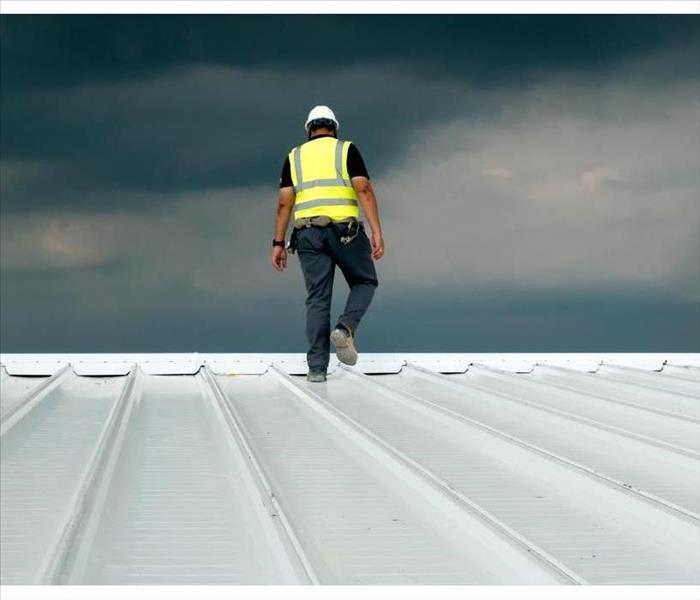 If you find a problem with your roof it's a good idea to promptly perform any repairs.
If you find a problem with your roof it's a good idea to promptly perform any repairs.
Roof Preservation For Your Building
When your business is located in Deer Park, OH, you probably know that a roof leak is no laughing matter. A roof is designed to protect your company from numerous types of inclement weather, including snow, ice and the blazing hot sun. However, a roof can do its job only if it’s kept in good repair. Here are a few tips you can use to help preserve your roof’s integrity.
1. Perform Regular Maintenance Checks
Many professionals recommend doing roof maintenance check twice a year. However, if your business has an older roof or is located in an area where you experience frequent bad weather, you may desire to have a check performed more often. A maintenance check can allow you to find and repair any damage early before larger damage occurs.
2. Look for Signs of a Roof Problem
Maintenance should include looking for signs of rain, snow, or wind damage, as well as cleaning out gutters and drains. You may also want to ensure that vents and other equipment are properly sealed and that previous repairs are still intact. If anything is amiss, then it's best to call a professional to conduct repairs before a major problem occurs. If you do experience a roof leak, then water damage professional can advise you on the proper repair and cleanup procedures.
3. Do Repairs When Damage Occurs
Even wind damage can lead to leaks and other issues with your roof. It's a good idea to have any repairs made as soon as possible after a problem is detected. Having repairs made in a timely manner may save your business from a more costly roof replacement.
When you live and work in Deer Park, OH, you know roof preservation is important. Performing regular maintenance checks and knowing what signs can indicate a problem may allow you to catch a roof leak before major damage occurs. If you do find a problem with your business's roof, it's a good idea to promptly contact a professional to perform any needed repairs.
What Can Be Included on a Fire Claim?
10/30/2021 (Permalink)
 Smoke damage in a factory in Trenton, OH.
Smoke damage in a factory in Trenton, OH.
What Information Can Be Included in a Fire Claim?
If a fire breaks out in your Trenton, OH, commercial building, the come back process can be difficult. Assessing the fire damage may overwhelm and confuse you. Some of the damage you found in your building couldn't possibly have been caused by the fire, so you may not know whether it can be included on your claim. Can your water-logged carpets be included on your insurance claim? As you try to figure out what counts as damage done by the fire, you need to remember the following:
- Flames affect structure, furnishings and equipment.
- Fire suppression causes water damage.
- Fire produces smoke and soot, which cause their own damage.
When you make your claim, you don't have to limit it to the damage done directly by the flames. Your fire restoration team may be able to help you better understand what you can include on your insurance claim.
Fire Damage
One of the main things your insurance adjuster will look for as he or she goes through your property is damage caused directly by the fire. This can include charred furniture, burnt walls and melted roof materials.
Fire Suppression Damage
Putting out a fire can cause damage too. Firefighters may have to add ventilation to your building to dampen and control the flames. This could mean breaking windows or cutting a hole in the roof. Suppression also requires lots of water, which means some of your building could be flooded or water logged.
Smoke Damage
Part of fire mitigation is taking care of the smoke stains and odor left after the flames are put out. Smoke often affects electronic devices, clothing, carpets, walls and ceilings. You may be able to include the cleaning and restoration costs on your claim.
Fire damage is not solely caused by the flames that rip through your commercial building. Instead, this damage can also be done by the byproducts of the flames and the tools used to stop the spreading of the fire.
Protecting Your Pets During a Fire Emergency
10/25/2021 (Permalink)
 Include your pet in your fire escape plan.
Include your pet in your fire escape plan.
Pet Safety Tips
Any fire emergency in an Oxford, OH, home can be devastating, but losing a pet during a fire can make the situation even more tragic. To prevent this from happening, there are several pet safety tips you should put in place to protect your furry friends from potential harm:
Include Pets in Your Evacuation Plans
• Put someone in charge of making sure your animals are with you during an evacuation.
• Make sure your pets will respond when they are called. Practice calling them when there are distractions so you are confident they will respond appropriately in a fire emergency.
• Have a firebox in your home that contains any important pet information (ownership documents, vaccination records, veterinarian information, etc.) that you can easily take with you during an evacuation.
• Put a pet first aid kit with your family’s first aid supplies so you can grab it without wasting additional time during an evacuation.
• Stick a “pet alert” window cling on a front window or door that indicates how many pets you have and where they are in the house. This helps firefighters locate your pets during a fire.
• Do not try to find a pet if they don’t respond. The most important thing to do is make sure you and your family get out of the house safely.
Have Pet Plans in Place for After a Fire
Most residential fires result in serious damage that may mean you have to stay someplace else until your house is cleaned, repaired and restored. This can take several days or longer; during this time, you may need to board your pets or temporarily house them with friends or family. As part of your pet preparation, consider boarding your pets or having them visit your friends before there is a fire so they can adjust more easily when there is an emergency.
Surviving a fire emergency can be traumatic for you and your pets. Restoring your home to a livable condition is crucial to getting your life back to normal. Restoration specialists in Oxford, OH, can make the transition smoother and get you and your pets back home sooner.
What Does It Mean for a Company To Be Certified in Mold Cleanup?
10/25/2021 (Permalink)
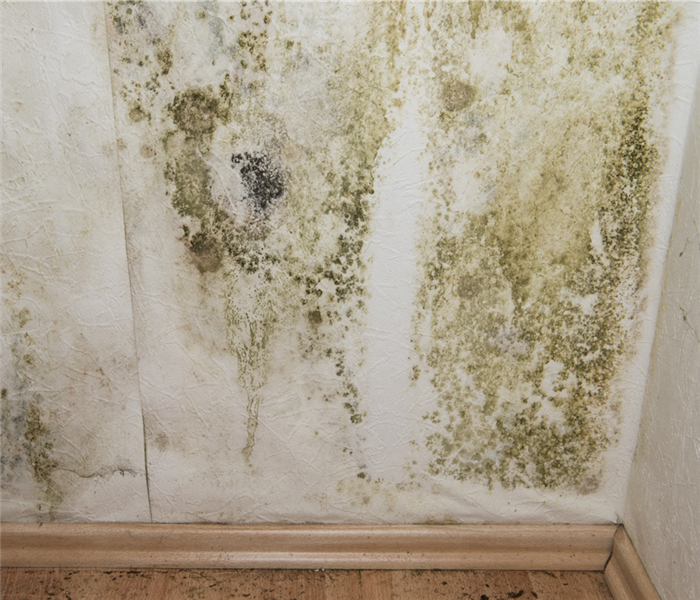 Mold growth in a Hanover Township, OH home.
Mold growth in a Hanover Township, OH home.
What Does It Mean for a Company to Be Mold Cleanup Certified?
When you have a mold problem in your Hanover Township, OH, home, you need to act quickly. If you don't already have a residential mold remediation team, you need to find a reliable company. As you search for a professional, you may find that some companies are certified mold cleaners while others aren't. Is this certification simply a justification for a company to charge you more money? Actually, working with a certified mold remediation crew can be a big benefit for you.
Expert Knowledge
A mold certification from the Institute of Inspection Cleaning and Restoration Cleaning means the professionals have proven knowledge of mold remediation and cleanup. The crew would have passed a test proving they understand mold cleanup, which encompasses the following:
- How to contain a colony
- How to meet legal requirements
- How to use safety gear to reduce contamination
- How to find hidden mold growth
When you work with a certified team, you can feel confident that they will know how to get the job done correctly.
Insurance-Provider Approved
Not only can you feel confident working with a company that has certified mold knowledge, but your insurance provider may also feel better about the situation. Depending on your policy, some of the mold damage remediation may be covered by your insurance. This means you need to follow the stringent guidelines set up by the provider to ensure the work can be reimbursed. Insurance providers prefer working with companies that are certified in mold cleanup because they know the right steps are being taken to address the fungus growth.
State Approved
Some companies in this industry may work without a proper state license. This may allow them to charge less money for the remediation, but it also means you may be legally and financially liable should anything go wrong. In order to become certified, a company has to be properly licensed.
Going through the cleanup process after discovering fungus growth can be hard. When you work with a certified mold expert, however, you can feel confident that you're getting sound advice and service.
Business Interruption Insurance: Understanding Your Coverage and Your Needs
9/27/2021 (Permalink)
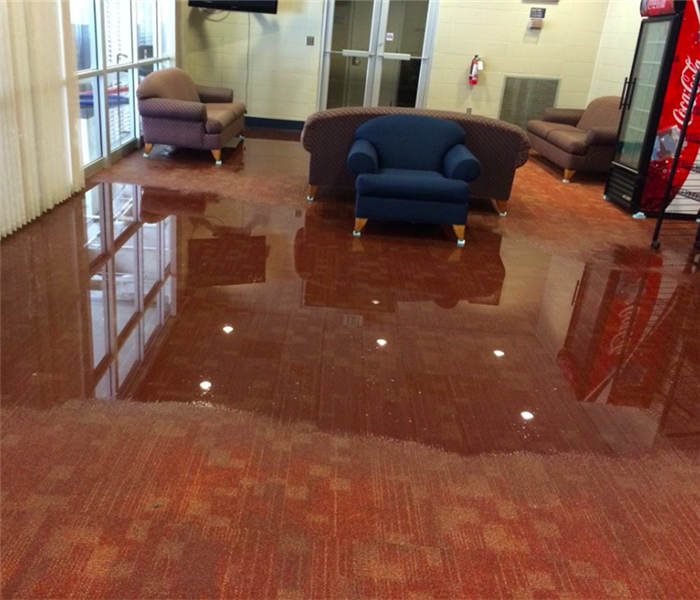 The cost associated with business interruption insurance should not worry you as a business owner.
The cost associated with business interruption insurance should not worry you as a business owner.
As a business owner, you have many day-to-day concerns, but most likely a broken pipe and flooding are lower on that list; however, large water damage can shut your operation down for possibly weeks. This type of disaster, the temporary loss of business, may be covered under your current policy under the heading of business interruption. If you’ve never heard of this coverage, and there’s no shame in that, you want to read through the questions below to learn the basics.
1. What Is Business Interruption Insurance?
Business interruption insurance is just what it sounds like, a policy to protect your business in case of any significant interruptions due to unforeseen damage or disaster. Primarily, these policies aim to minimize your loss when your business is forced to shut down due to restoration efforts. These policies can float your business by instituting what they call policy limits.
2. What Are Policy Limits?
Policy limits refer to the amount of money that your insurance policy will provide the business after experiencing a shutdown due to a disaster, like flooding. It is important to ensure that the policy limits offered will be enough to cover your typical operation needs; however, policy limits can vary based on location and type of business.
3. Why Do Costs and Policy Limits Relate to Business and Location?
Most of the business interruption insurance plans, while typically a part of your overall coverage, can vary in price and policy limits depending on the type of business and the location. This variance is due to the overall risk to the insurance company. For instance, living in Hamilton, OH, the risk of weather damage is high, and if you couple that with a restaurant, with an increased chance of fire, then insurance coverage will likely be more expensive with lower policy limits because of the increased likelihood of a payout.
The cost associated with business interruption insurance should not worry you as a business owner, as they are likely already figured into any commercial coverage. What should concern you is operating a business unprotected with low policy limits, leaving yourself and your property vulnerable to disasters, like flooding.
4 Ways to Prevent Mold After Your Home Floods
9/18/2021 (Permalink)
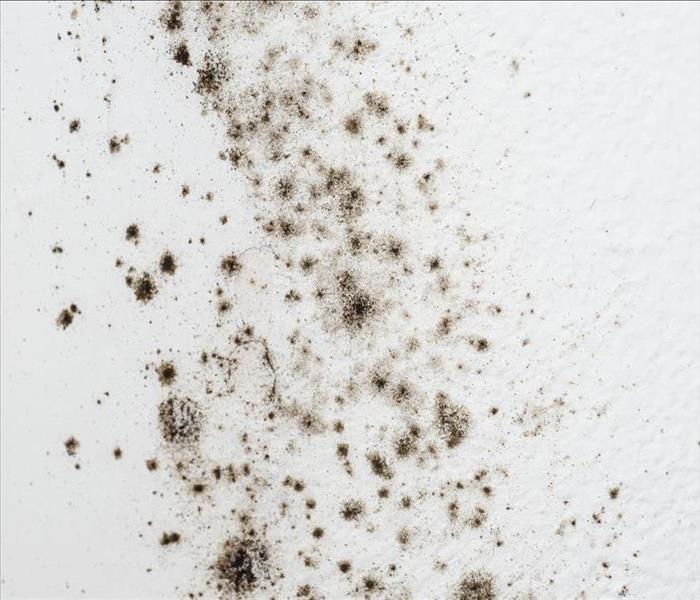 Mold growth can start within 24 hours of flooding.
Mold growth can start within 24 hours of flooding.
You should act immediately to prevent mold from starting to grow in your home after a flood in Hamilton, OH. Document the damage for insurance purposes and then take steps to dry out your home. Mold growth can start within 24 hours of flooding, but you can limit the likelihood that it will become a serious problem. Here are four ways to prevent mold after a flood.
1. Get Rid of Moisture
The most important mold prevention method is eliminating the presence of standing water and residual moisture. Depending on the severity of the flood, you may want to hire a professional water damage restoration service to pump water out of your house.
2. Clean the Affected Area
Water from a flood is considered Category Three or black water, meaning that it may contain chemical contaminants or sewage overflow. Areas of your home exposed to flood water should be cleaned before being dried and restored.
3. Thoroughly Dry the Affected Area
In addition to air movers or fans, you may also want to use dehumidifiers to dry out porous or semi-porous building materials and contents. You may need to get rid of carpet, which tends to trap moisture and contaminants that can lead to mold growth.
4. Clean or Replace Damaged Contents
Once the affected area is dry, you can determine which building materials must be torn out and replaced and deal with damaged contents. Most non-porous contents can be cleaned. Porous items of significant monetary or sentimental value may be worth restoring with specialized methods.
By following these tips, you may not experience mold growth after flooding, or the problem will be less severe than it would have been otherwise. If mold does form in your home in Hamilton, OH, you may be able to retain the services of the same residential damage restoration company to provide mold removal.
Why You Should Choose a Certified Mold Remediation Expert
9/13/2021 (Permalink)
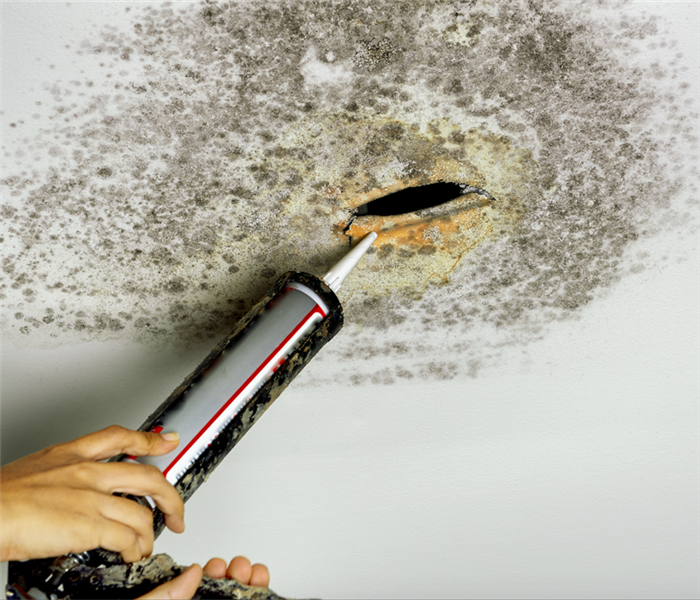 Mold remediation can be a costly expense.
Mold remediation can be a costly expense.
Cleaning extensive mold growth can be a nightmare for any homeowner in Hamilton, OH. A professional cleanup and restoration crew can help you address mold damage and restore your home. If you live in an area with multiple service providers, deciding which one to hire can be a challenge. However, at the end of the day, your goal is to ensure that your home is thoroughly cleansed and eliminated from mold. For this reason, a certified mold remediation expert is your best option.
What Certification Means
Widespread mold can significantly damage your home. A certified mold specialist will know how to efficiently address the problem, offering peace of mind to affected homeowners. To receive a mold certification, specialists must accomplish the following:
• Commit to a code of ethics
• Abide by standards of practice
• Complete testing and on-the-job training
• Renew certification regularly to verify accuracy of knowledge and techniques
Because of extensive training, certified mold experts possess the technical proficiency to thoroughly eliminate mold inside your home. This includes efficiently removing mold that has infiltrated building materials as well as preventing recontamination. Completing mandatory recertification also ensures that the contractor is up-to-date on the latest methods and technologies that benefit remediation efforts.
Insurance Company’s Preference
The Institute of Inspection, Cleaning, and Restoration conducts research and sets industry standards. In addition, it’s one of the leading certification authorities. Like homeowners, insurance companies want assurance that mold remediation will be thoroughly and professionally completed. For this reason, insurance companies typically prefer experts possessing mold certification.
A Wise Choice
Mold remediation can be a costly expense. However, attempting to reduce costs by choosing an uncertified technician can create extra expenses in the long run. A certified mold technician is a worthwhile investment because their technical proficiency and dedication to best practices will ensure that the problem is adequately addressed from the beginning, helping to preserve your home’s internal integrity and reduce the likelihood of future mold growth.
Toilet Overflow and Prevention
8/10/2021 (Permalink)
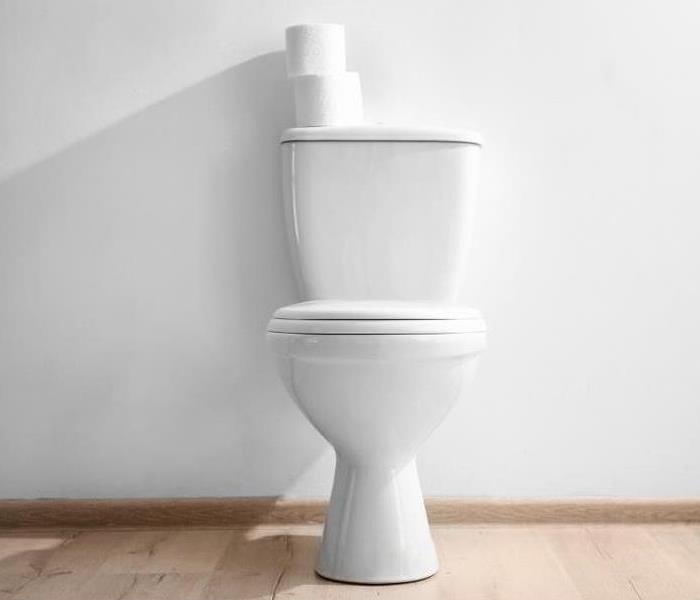 If the overflowing toilet takes out of control, you can count on SERVPRO.
If the overflowing toilet takes out of control, you can count on SERVPRO.
Overflowing Toilets and Their Prevention
Dealing with a flooded toilet is a challenging and unpleasant task. For residents of Hamilton, OH, there are options available that can make cleanup and prevention a much easier and more infrequent process. Here is what you need to know.
First Steps
When toilet overflow happens, there are a few things you can do right away to prevent water damage and bacteria from spreading in your home.
• Turn the water shut off valve at the base of your toilet to stop additional water flow.
• Try to remove any objects that may be blocking the toilet and preventing it from flushing. It is best to use rubber gloves for this task so that you are protected from bacteria that may be lingering in your toilet.
• Clean up spilled water from the surrounding area with towels or other highly absorbent materials as soon as possible.
• Contact a sewage company to assess the damage.
Common Causes
Sometimes it is difficult to find the cause of your clogged toilet. The most common cause for toilet overflow is a blockage in the drain line. The drain line is the pipe that connects the outside line to your toilet line inside the house.
Sewer damage is another common culprit for an overflowing toilet. Sometimes the main sewer line can get clogged by something, and it can back up the pipe lines all the way into your home.
Septic systems can also cause toilet overflow if they are not functioning properly. This can happen if the ground surrounding the tank isn't absorbing the incoming water.
Prevention
To prevent toilet overflow, put only flushable items in the toilet. Never flush plastic, hair, paper towels or anything that will not disintegrate.
Sewer damage is no joke, and when a toilet overflows, the cleanup and damage can be daunting. Residents of Hamilton, OH, are encouraged to call a professional sewage company to check their homes for any kind of sewer damage that may cause future problems.
5 Steps to Prevent Mold Growth After a Flood
8/4/2021 (Permalink)
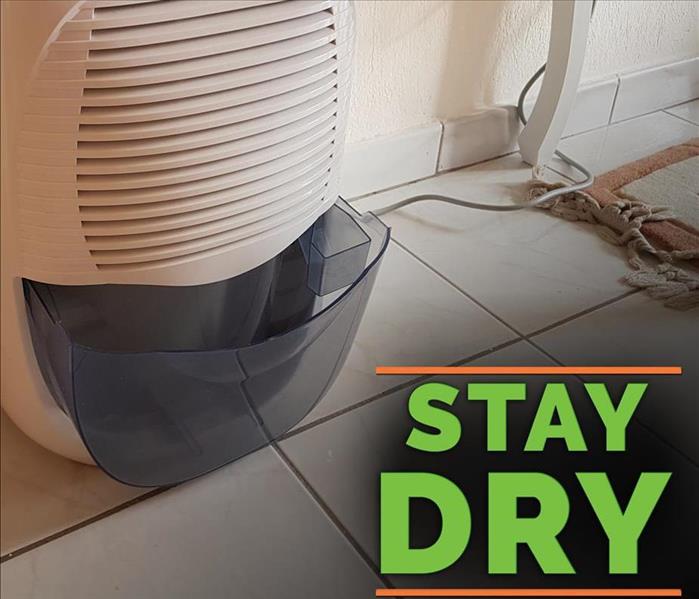 A dehumidifier will remove the moisture from the area.
A dehumidifier will remove the moisture from the area.
Prevent Mold Growth In Your Home
If your Hamilton, OH, home has experienced a flood following a storm, you might be considered about mold growth, as you should be. After flooding, homeowners only have about 36 hours to act before mildew and mold can start to grow. Fortunately, there are steps you can take to prevent mold from growing in your home.
1. Remove Wet Items
The first thing to remove from the home is big, wet items like furniture, curtains and pillows. They can hold a lot of moisture, so move them to the driveway or garage until they dry out completely.
2. Use a Wet Vac
Shop vacs or web vacs can remove water from wet carpets. If you don’t own a shop vac, you can rent one from a hardware store. You can also hire a professional to come in and take care of your carpets for you.
3. Air Out the Area
It might be a good time to invest in a dehumidifier, which will remove the moisture from the area. Fans can also help. If rain has stopped, open doors and windows to give the water somewhere to escape.
4. Remove Molding and Baseboards
Baseboards and crown molding look beautiful but can prevent the walls from completely drying. Removing all molding from the walls exposes them to air so that they can better dry.
5. Cut Small Holes In the Wall
Walls made out of sheet rock are especially vulnerable to mold growth. Allow them to dry out by cutting small openings along the bottom of the walls. This lets air reach the covering on the inside of the walls in addition to the outside.
These steps will help prevent mold growth in your Hamilton, OH, home. Still, after a few days without power, mold can start to grow. Contacting an expert can help you determine the best route for mold removal.
Tips To Prepare Kids for a House Fire
7/22/2021 (Permalink)
 By teaching and practicing safety fire tips with your children your family is prepared for a home fire.
By teaching and practicing safety fire tips with your children your family is prepared for a home fire.
Your kids’ safety is of utmost importance. You teach your children to look both ways before crossing the street and to stay away from strangers. But, as a parent and homeowner in Morgan Township, OH do you educate your children on what to do in a home fire? When a fire emergency occurs, every second counts. Have a fire escape plan and practice it with your children. Review the tips below to educate your family.
Practice a Fire Escape Plan
Teach and practice the following techniques with your children during a non-emergency, so your family knows what to do in the case of a home fire:
- If the smoke alarm sounds at night, roll to the edge of the bed face down, place the closest hand to the floor and slide off the bed.
- Crawl to avoid smoke in the air on knees and forearms with head down, or crawl like a snake.
- Check doors before opening by feeling for heat. If hot, find another way out of the room. If warm or cool, open slowly and check for fire. Close doors as you go.
- Create and practice an escape route and agree on an outdoor meeting place. If trapped, go to the window, open it, climb out if possible or yell for help. Once out of the house, do not return inside for any reason.
Preventative Measures for Kids
Aside from teaching and practicing the above techniques, follow these kids’ safety tips:
- Maintain at least one functioning smoke detector at each level of your home. Teach your children that the alarm sound means there is fire and smoke in the house.
- Keep lighters and matches out of the reach of young children. Instruct older children not to play with these or other flammable objects, such as candles.
By teaching and practicing the above tips with your children in Morgan Township,OH your family is prepared for a home fire. Once your kids’ safety is secured and the fire is out, contact a fire restoration specialist and your homeowner’s insurance agent to begin the process of returning your home to preloss condition.
How To Combat Mold and Mildew in Businesses
7/22/2021 (Permalink)
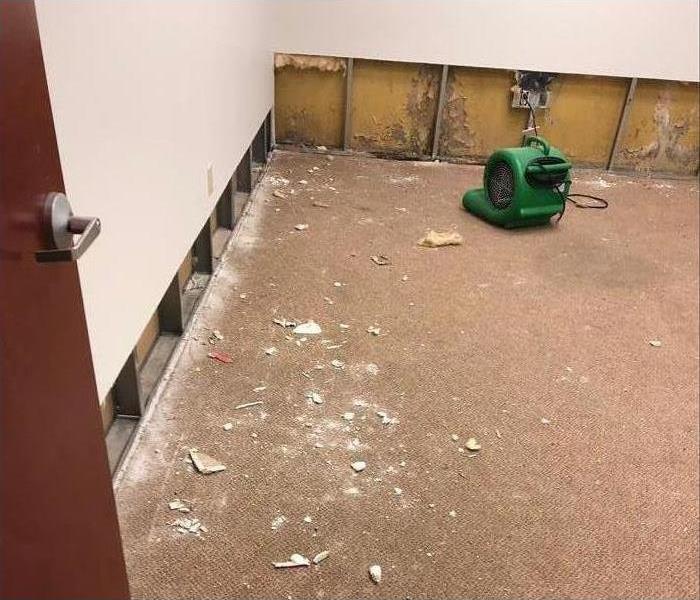 Mold damaged behind walls.
Mold damaged behind walls.
How to Get Rid of Mold and Mildew in Your Business
With large groups of people comes a large influx of bacteria. For many commercial businesses, this means a challenge in maintaining a healthy environment for customers. One location, in particular, provides a larger challenge. Because of the constant moisture and potential for bacterial growth, bathrooms are hubs for mildew and mold. Here are a few tips and tricks to keep mildew off clean surfaces.
1. Maintain a Level of Cleanliness
Mold can spread quickly if it is left to its own devices. However, in order to grow, mildew must have some source of food and water. Wiping down counters, daily trash disposal and frequent spot cleaning can stop it from feeding and advancing.
2. Prevent Leaks
Mildew thrives in high-moisture environments. Identifying even the smallest faucet or toilet leaks early is essential in fighting fungal growths. Keeping floors and walls free from spills can also help to keep mildew off clean surfaces.
3. Allow for Ventilation
As any commercial owner may know, planning is essential in preventing unforeseen expenses. One important aspect to consider when maintaining your business is allowing for reasonable airflow in restrooms. Consider setting up ceiling fans or small windows that can be opened.
4. Inspect Grout and Caulk
Although both of these details can seem small, building grout and caulk can house large amounts of bacteria and mold. If not properly applied, they allow for water to accumulate and for mildew to multiply. Cleaning and reapplying new grout and caulk is vital in preventing fungal growth.
5. Inspect Ceiling Tiles
Another frequently overlooked source of mildew is the bathroom ceiling tiles. Their porous material can house millions of mold particles. Cleaning tiles with appropriate cleaning supplies can eliminate one of the common feeding grounds for fungal spores. In some cases, replacing old tiles will be necessary to keep mildew off clean surfaces.
If bathroom mold has already spread beyond control, calling qualified mold removal experts in Millville, OH, is important in preventing a larger problem. With these tips, anyone can help their business maintain a high level of safety.
How To Make Your Meeting With the Adjuster Go Smoothly
7/12/2021 (Permalink)
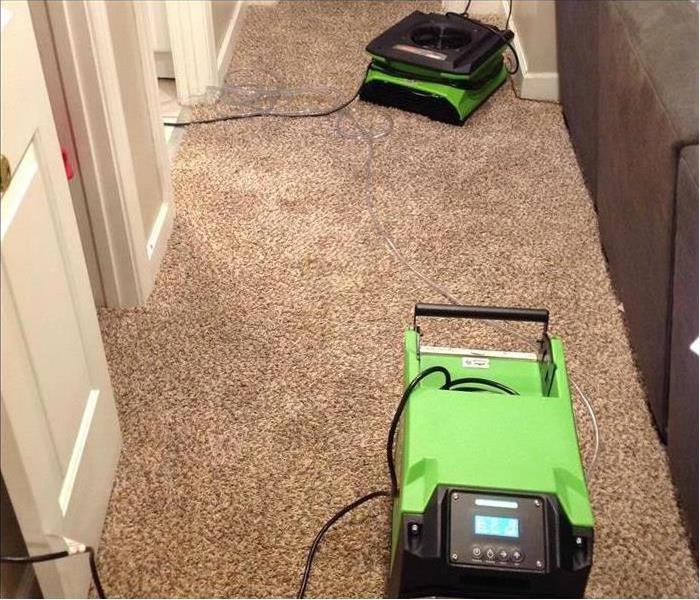 Drying carpet in a home that suffered from water damage.
Drying carpet in a home that suffered from water damage.
Making a claim after a flood in your Trenton, OH, home can leave you feeling overwhelmed. Your provider may want you to take pictures of the damage, meet with a home adjuster and hire a professional cleanup team.
Use this quick guide to help prepare for your meeting with the adjuster.
- Make a list. Chances are the adjuster is going to want to go over the details of your loss. You should make a list of any belongings damaged in the flood. Try to remember when you purchased each item and how much it might cost to repair or replace it. You should also include structural damages in your list. If possible, include pictures to give the adjuster a visual idea of what happened to your home.
- Keep the damaged items. Even though you made a list and took pictures, you should still keep any furnishings, building materials or belongings you plan on throwing out. The home adjuster may want to see the destroyed items to better understand the extent of the flood.
- Get a quote. If you already know who you want to tackle your restoration, you should get a quote. The adjuster may set a specific budget for your insurance claim.
- Keep receipts. Sometimes it may take a while for an adjuster to make it out to your home. If you have to start the repairs before your home is inspected, you should be sure to keep all receipts of the work done. Remember to also keep before and after pictures of your house to help the insurance investigator better understand what happened.
A home adjuster is sent out by your insurance provider to figure out the extent of your loss after a flood. Because this person may decide how much money you get from your policy to do the repairs, you want to make sure the meeting goes well.
3 Ways To Prep Your Business For a Winter Storm
7/12/2021 (Permalink)
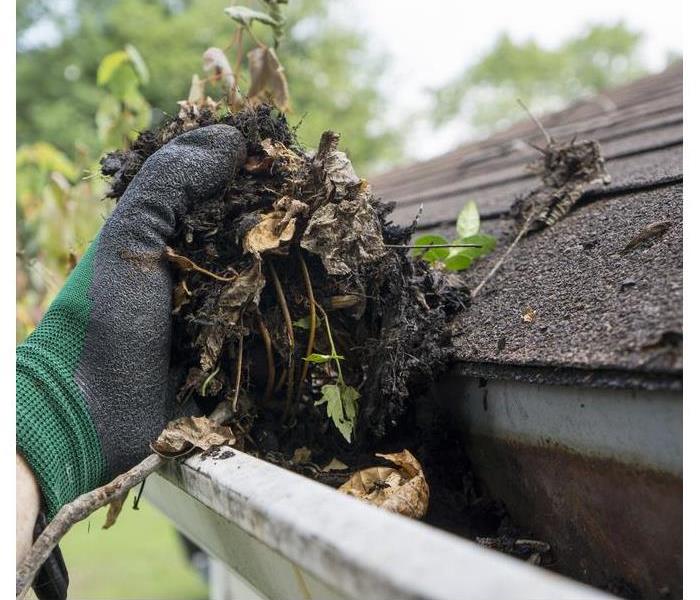 Keep your gutters clean.
Keep your gutters clean.
Ways To Prepare For a Winter Storm
If you own a business in Ross, OH, you are probably familiar with the damage that a winter storm can bring. In addition to physical damage, they can also cause business owners to lose time and money due to business closures. Below are a few ways you can prepare for when the inevitable storm comes through your city.
1. Inspect Your Building
Don’t wait until the news shows a winter storm heading your way. As you approach the winter season, start inspecting your building and its grounds. Here are some typical problem areas to look for before the storm hits.
- Pipes – Make sure there aren’t any leaks and clear out water before freezing temps arrive. This will help avoid a pipe break.
- Gutters – Remove any clogged debris and check for leaks.
- Landscaping – Keep trees trimmed and free of dead branches, which can fly through high winds.
- Windows, roofs and doors – Check for leaks around sealants and siding, which can let in water.
2. Be Aware
Once your building is in good shape, pay close attention to the weather reports so that you have as much time to prepare as possible. You should have an emergency plan in place for your business, which might include the number of a trusted restoration expert. If inclement weather hits hard, having a contact readily available will get your business back up faster.
3. Know Your Coverage
Review your insurance policy annually and ensure you are aware of what is and isn’t covered when it comes to storm coverage. Take some time to review the storm damage assessment and the claims filing process.
A winter storm can wreak havoc on your business, but there are plenty of ways to prepare for it. By keeping your building and property in order, paying attention to weather reports and reviewing your insurance policy, you’ll be ready for whatever winter throws your way.
Smart Smoke Detector: To Buy or Not to Buy
7/6/2021 (Permalink)
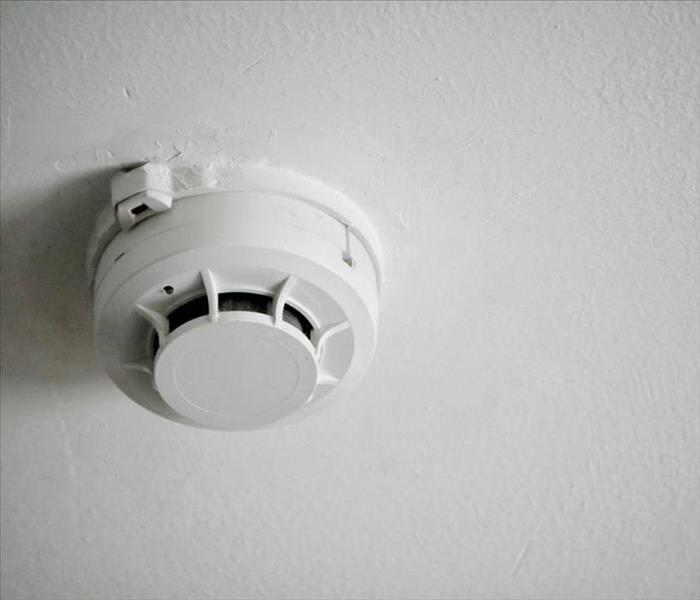 A smoke alarm can be one of the wisest decisions you ever make.
A smoke alarm can be one of the wisest decisions you ever make.
Should a Smoke Alarm Cost Over a Hundred Dollars?
Companies developing new smart detectors think they should, but are the improvements a luxury or a necessity? You be the judge.
1. Expense Versus Performance
When comparing performance against the expense, you can be blinded by the technological gadgetry of smart detectors. True, most smart detectors can connect and communicate with your other smart devices, but does this bonus contribute to its effectiveness? Most reviewers don’t think so, claiming that a regular smoke detector functions and performs the same as a smart detector, without the bells and whistles.
2. Convenience Versus Luxury
The argument to buy or not to buy comes down to convenience versus luxury. A regular smoke alarm is a bargain find, costing around $20, but a smart detector can cost upward of $100. The inter-connectedness and advanced notifications equate to the increased price tag.
3. Technology Versus Necessity
Fire safety may be a necessity but is it necessary to shut off a detector from your phone or to be notified of a fire when you’re not home? These tools may be beneficial, but that does not mean they are necessary. Regular detectors have worked well for decades with simple batteries and buttons.
4. Preparation Versus Spontaneity
No matter your decision, you may want to invest in fire preparations because spontaneity puts both you and your property at risk. Many fire departments recommend having an evacuation plan in case of a fire and practicing that plan with your family monthly. Additionally, you may want to work with a company in Hanover Township, OH, that specializes in emergency planning as preparation for a crisis, like a fire.
A smoke alarm can be one of the wisest decisions you ever make, but do you need a smart alarm? All smoke detectors work the same way and, by many accounts, perform equally. The most significant differences between smart alarms and regular alarms are in the advanced notifications and ease of use, but does that make them worth the price tag? What do you think?
3 Benefits of Working With Certified Mold Services
6/17/2021 (Permalink)
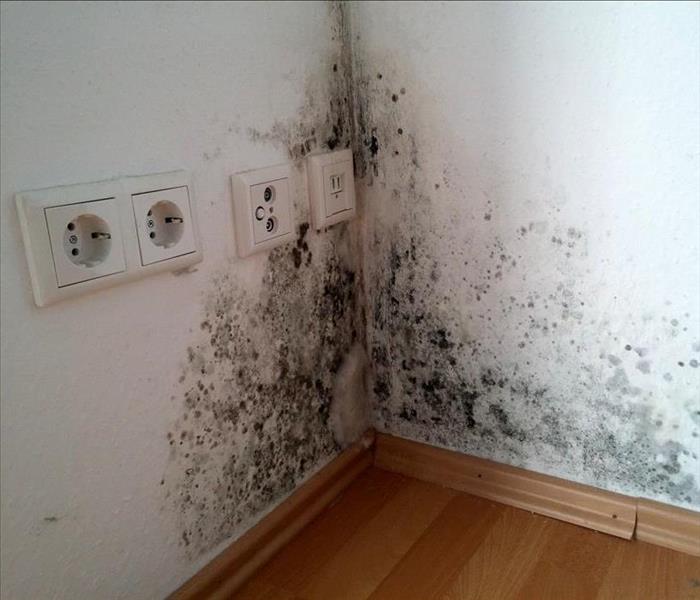 If you have mold damage in your home, it's time to call the professionals.
If you have mold damage in your home, it's time to call the professionals.
Three Benefits Of Choosing Services That Are Certified
If you have mold in your home, it's time to call the professionals. Dealing with mold can be troublesome, but working with mold remediation services can make the process easier. How do you know which company to choose? There are many benefits of choosing certified mold professionals.
1. Insurance Companies Prefer Mold Certification
According to IICRC standards, companies must do a lot to become certified. Insurance companies may prefer certified mold remediation companies to ensure better quality. If you are working with insurance to fix your mold problems, this may be a requirement.
2. Services Are Ready and Prepared To Fix Mold Problems
Services that become certified have all the qualifications to ensure a job well done. They also have all the tools necessary to fix any kind of mold issue in the home. If you choose a company that is not certified, they may not remove mold in the best possible way due to a lack of tools or resources. Certification ensures a level of trust that other companies may not be able to give without proof of mold remediation expertise.
3. Results Are Expected To Be High-Quality
As mentioned above, certified mold services must meet certain standards and therefore can do a great job at helping you fix your mold growth problem. By choosing a certified company, you ensure the best quality of remediation. This is necessary to prevent future mold problems from occurring, and you can be reassured that they will use the best practices and methods to remove mold for good.
Mold growth is never wanted inside the home. A certified mold service may be the best professional option. Your insurance company may prefer certification anyway, as it proves the expertise of the services you work with. When choosing a service, be sure to find out if they are certified.
Q2 2021 Franchise Teammate One Team MVP Finalist Dylan Riddle
6/11/2021 (Permalink)
 We are beyond proud to have Dylan as part of our SERVPRO family.
We are beyond proud to have Dylan as part of our SERVPRO family.
Dylan Riddle has been the job file coordinator with SERVPRO of East Central Cincinnati and West Hamilton/Oxford for more than three years. There he has taken his work ethic, knowledge, and positive attitude to help improve his franchise's job cycle times and audit scores. While he rarely works in the field, customers often compliment the customer service when working with Dylan. His help was even on display during the recent Winter Storm in Texas and Oklahoma as he provided help managing the influx of work during the event.
Dylan has been absolutely critical in the turnaround of our franchise. Approx. three years ago we realized we were one of the worst franchises in regard to upload scores and job cycle times. After spending the majority of the year in a "red light" status, we had to take action to correct these deficiencies. We made a significant amount of internal changes, however, we still struggled with our audit scores. Despite our efforts, we could not seem to grasp the process. Fortunately, Dylan came along and was able to quickly help us turn things around and surpass the very lofty goals I had set.
In June of 2019, he informed me we had reduced our office cycle time from 8+ days to 1.5 days, which surpassed our previously set goal of 2 days, all while raising our average audit score into the 90% range. On that same phone call, I had informed Dylan that our new goal was to get our office cycle times down to a point where it started with a decimal point (example .75 days). Without reservation he accepted this challenge and simply replied with, "yes sir, I will have some ideas emailed to you by tomorrow morning with some ways we can make it happen." He followed through with his commitment, and for 2020 our current office cycle times are .12 days with a 100% job audit score. I could honestly go on and on and name scenario after scenario where Dylan has met/exceeded established goals time after time. Dylan is a true team player and I could not think of anyone more deserving of the MVP award.
Do the right thing: Dylan seems to be intolerant of shortcuts or anything short of his best effort. It is reflected in his audit scores, as well as the positive feedback we receive from customers on a regular basis, which is impressive considering he rarely steps foot on many of our mitigation projects.
Serve others: I have personally made some pretty insane requests at all hours and I have never heard any hesitation on his behalf. He is a true team player who is all about providing the best experience for the customer and taking actions to improve those around him.
Stay positive: Anyone who spends five minutes on the phone with Dylan would immediately identify how incredibly positive he is. When Dylan first started with us, I reviewed all of his job files to ensure they were to our franchise's new standard. This is something we do with all employees, and usually after a week, each requested revision is usually met with some form of hesitation/frustration. However, I never experienced that with Dylan. This is very atypical, so when I asked him about it he responded with, "Boss I figured you were just trying to push me out of my comfort zone, so I have just turned it into a game to see if I can write an Xactimate where you can't find anything to add, and if I can't do that, I will at least make you work really hard to find something."
Hustle/Grind: Since Dylan is part of the administrative team, he is not expected to regularly perform his duties after hours or on the weekends, but that has not stopped him from working countless hours outside of his "normal hours." When we really started gaining traction and seeing the fruits of our focus on cycle times, we challenged Dylan to get our office time down to a metric that started with a decimal point, and that the goal was to get the number so low that when people read our numbers, they were equal parts confused and suspicious. Dylan took that request to heart, and to this day, if the production staff pulls equipment on a Saturday, he is in the office placing the finishing touches on the job file and submitting for billing.
Collaborate: Dylan is a true believer of the ONE TEAM mentality and has helped or provided pointers to quite a few other franchises. During the most recent freeze event in Texas and Oklahoma, Dylan became a resource for Storm Team Wilson during the weekly admin webinars. He noticed the high volume of questions that seemed to be heading towards the unmanageable levels and quickly jumped to action and started fielding questions so that the members of Storm Team Wilson could address the more complex or dynamic questions.
– Brandon Johnson, general manager, SERVPRO of East Central Cincinnati
4 Critical Components of Fire Preparation for a Business
5/4/2021 (Permalink)
 Board up services to a building in Hamilton, OH.
Board up services to a building in Hamilton, OH.
Fire Preparation Should Cover These 4 Critical Areas
A business fire happens hundreds of times each day in the U.S. Many of the blazes are caused by cooking incidents, even in office buildings. Electrical malfunctions cause many other fires. Every company should have a sound fire preparation plan to either prevent a fire or to mitigate its impact. A solid plan could save lives, reduce injuries and minimize property damage.
1. Emergency Response. Everyone in the company should know the number to call for the fire department. The faster the crews arrive, the better they can minimize fire damage to a building in Hamilton, OH.
2. First Aid. While a business fire is capable of causing many serious injuries that are beyond the scope of most people, it can be beneficial to have some first aid supplies on hand, as well as provide some education to employees. Good fire management calls for the ability and the supplies to treat minor burns and other small injuries.
3. Fire Mitigation Equipment. Once a fire starts, there are numerous ways to contain the spread. Fire alarms and smoke detectors create a fast alert system that promotes a swift response. The quick use of a fire extinguisher can stop a small fire from turning into a larger one. Fire sprinklers in the facility can suppress a fire, making it easier for fire crews when they arrive.
4. Fire Restoration. A quality fire remediation company can minimize property damage in numerous ways. Certified technicians will restore valuable items through the use of advanced cleaning techniques. They will prevent additional and secondary damage by following the standards recommended by the Institute of Inspection Cleaning and Restoration Certification organization, an industry leader in the restoration field.
A business fire whether large or small presents many challenges to a company. A solid groundwork of preparation before a fire strikes can result in significant benefits.
3 Steps To Protect Your Pipes From Winter Storms
4/19/2021 (Permalink)
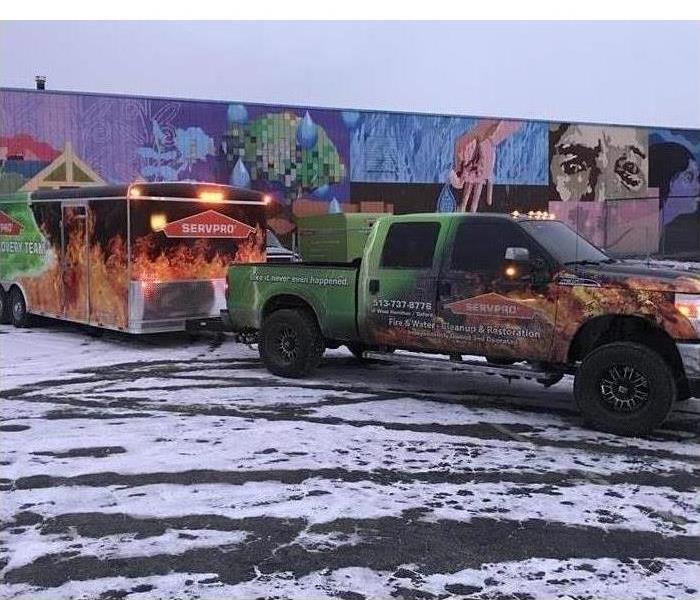 Be sure to contact professional water damage specialists as soon as possible.
Be sure to contact professional water damage specialists as soon as possible.
Steps To Prepare Your Pipes For A Cold Season
Winter can be a tough time for businesses in Morgan Township, OH. When you are already worrying about snow and ice removal and keeping your customers and employees safe, you don't want to also be forced to deal with a burst pipe. Here are three steps to getting your pipes ready for a cold season.
Remove Water From Outside Lines
Draining water from any water lines that have direct exposure to extreme cold is imperative to keeping your system in good working order. Disconnect garden hoses and sprinkler supply lines. Close off your outdoor hose bibs:
- Locate the shut-off valve and turn off the water supply.
- Place a bucket under the spigot and turn the water on, allowing it to run until the water in the line is removed.
- Leave the spigot open so that any water that may leak into the line is able to drip out instead of freezing in the line.
Insulate
A frozen pipe can end in disaster, with standing water that wreaks havoc on your building. Help prevent this by properly insulating your building and your plumbing. Be sure to pay special attention to areas where water supply lines are located in unheated areas such as garages. Install pipe sleeves or heat tape as needed to help in these areas.
Keep Them Warm
Take additional precautions when you know extreme cold is coming. Keep garage and service doors closed and open kitchen and bathroom cabinets to allow warmer air to circulate around pipes. Turn the water on to a trickle on any faucets served by exposed pipes. This will allow some water to move through the system to prevent freezing. If your efforts fail and a burst pipe results in a mess, be sure to contact professional water damage specialists as soon as possible to get a headstart on proper cleanup.
Don't let a burst pipe throw a wrench into your business plan. Follow these steps to get your plumbing ready for the cold winter weather.
3 Common Causes of a Lint Fire in Your Dryer
3/22/2021 (Permalink)
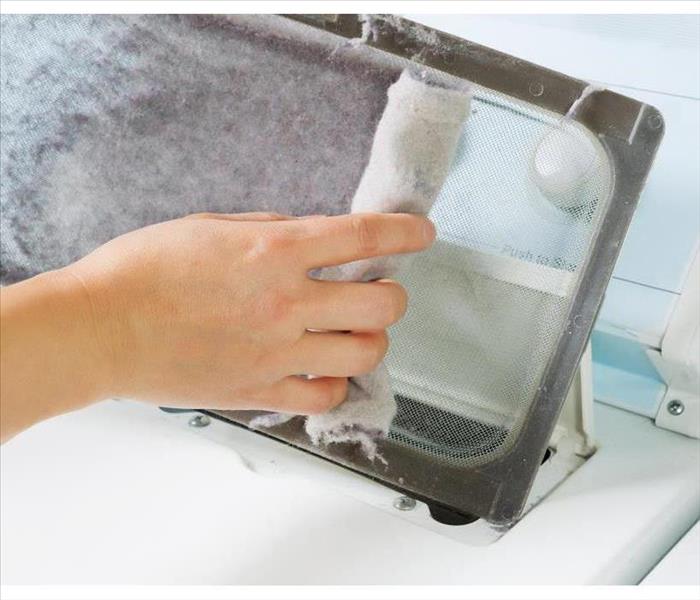 Clean your lint filter before and after each use of your dryer.
Clean your lint filter before and after each use of your dryer.
Three Common Causes Of Lint Fire In Your Dryer
Homeowners in Reilly, OH, whose dryers are no longer functioning, should think twice before purchasing a new appliance. Lint buildup is a common cause of a malfunctioning dryer. It is also a lint fire hazard that may go unnoticed for years. Lint can accumulate in places where it is hard to spot, such as:
- Dryer vents
- Inside the dryer
- Behind the dryer
Lint is made up of small thread particles, such as wool or cotton, that easily combust. These three common causes of a dryer fire should be prevented.
1. Failure to Maintain the Dryer Vent
Experts recommend that you service your dryer at least once a year to prevent a lint fire. Fluff and fuzz can fill the exhaust hose and dryer vent. An appliance that no longer dries your clothes is a sign that the vent is clogged. When the lint has no exit, it will eventually fill the vent until it has no other escape except into your home.
2. Lint Inside the Dryer
You should clean your lint filter before and after each use of your dryer. Lint is visible on the filter but can hide inside of the dryer as well. When you remove the filter, peer inside of the housing to make sure no fluff is left behind. If you see buildup inside of the filter housing, clean it thoroughly with a vacuum cleaner to prevent a dryer fire.
3. Lint Behind the Dryer
Lint hidden behind the dryer is a sign that the vent needs to be cleaned. Any spark near the lint can cause a house fire. To prevent this, clean behind your dryer regularly to keep lint buildup at a minimum. Then, contact a professional to service your dryer annually.
Contact your local fire damage restoration service if there has been a fire in your home due to lint. Taking preventative measures, such as yearly dryer maintenance, will keep your house safe from a lint fire.
How You Can Prepare for a Home Adjuster's Visit
3/16/2021 (Permalink)
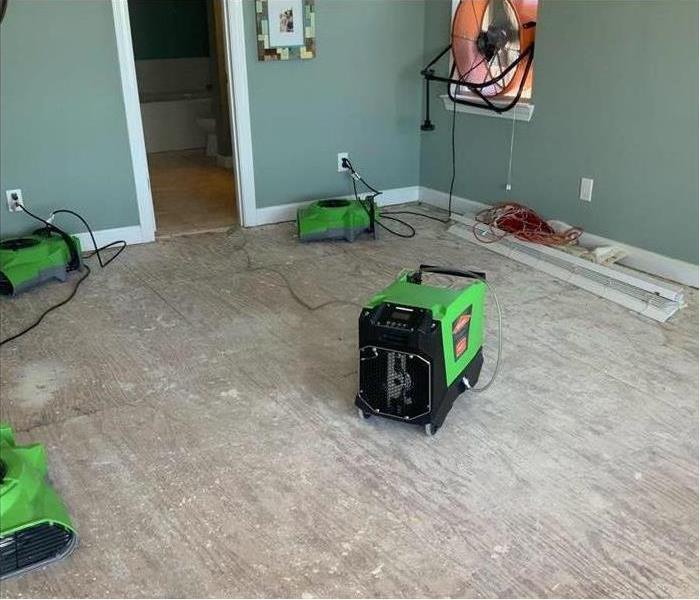 Contact a water damage remediation service to begin drying your home.
Contact a water damage remediation service to begin drying your home.
How To Prepare Ahead Of Time
If you've just sustained water damage to your property, make sure to call your insurance company right away so you can begin the claims process as soon as possible. Soon after the initial call, they'll send out a home adjuster to assess the damage and file a report. Though he or she will be the one to make the official report, there are things you can do that will help move the process along faster. Here's how you can prepare ahead of time to make that happen.
Document the Damage
You know your home better than anyone, so you are not likely to miss anything that's been damaged, no matter how small. Take a detailed inventory of what's been damaged and lost — in writing, in photos and on video, if possible. You can ask the adjuster to include them in the report alongside his or her findings.
Clear a Path
Clear the way for the home adjuster to move freely around your property, so nothing will be missed. If you have to move the debris to do that, make sure you don't remove it entirely. The insurance claim needs as much evidence as possible included so that you receive the proper coverage and reimbursement.
Prevent Further Damage
Contact a water damage remediation service in Lemon Township, OH, to begin drying everything out and keep further damage at bay. The team will also help you itemize and categorize the damages and losses you incurred.
Know Your Policy
Before the adjuster arrives, review your policy with your agent. You should know what is and isn't covered, the limits of your policy and when to expect reimbursement so you can start making arrangements for repairs and replacements.
When the worst happens and your home sustains serious water damage, it's nice to know you have qualified professionals in your corner. Your insurance company and the home adjuster will work with you to make sure you get the help you need and get back on your feet as soon as possible.
FAQs About Business Inventory Lists
2/25/2021 (Permalink)
 To protect your business, you need to create an inventory list.
To protect your business, you need to create an inventory list.
Creating an inventory list of everything in your business may seem daunting, but it is crucial. Every business owner should have an inventory to give to their insurance company or remediation professionals, such as SERVPRO, in the event of a disaster.
What Is an Inventory?
An inventory is documentation of everything in your business in Layhigh, OH. It is often organized by room or type of item. These lists should include the following information:
- Descriptions
- Make, model, and serial numbers
- Costs
- Purchase locations
- Purchase dates
- Receipts
- Replacement estimates
When Should You Make One?
Make an inventory now. Even the most basic list will help you deal with the insurance company and a disaster remediation team. This is also a helpful tool for when you are reviewing your insurance coverage.
Why Should You Make One?
Create an inventory to serve as proof of loss during an insurance claim. Without a thorough list, you can miss items and not receive enough compensation. This is because it is difficult to remember what is in your business when faced with a disaster. Having an inventory is one less thing you need to worry about.
How Do You Start One?
An easy way to get started on your list is to walk through your business and video everything you see. While a video alone is not enough to serve as proper documentation for an insurance claim, it is enough to get you started figuring out what you need more details on.
How Do You Calculate Value?
Besides providing a list of items, you will also need to have cost estimates for your insurance claim. When calculating these, consider the replacement cost. Check with your insurance company and see that you will receive full compensation for replacement costs. If you don't get these, you may want to upgrade your policy.
To protect your business, you need to create an inventory list. This will serve as proof of loss and help you provide your insurance agent with a complete list of items that were damaged.
3 Safe Alternatives To Traditional Candles
1/28/2021 (Permalink)
 Candles can be pleasant to look at, but they also present a risk of fire to your Hamilton, OH, home.
Candles can be pleasant to look at, but they also present a risk of fire to your Hamilton, OH, home.
3 Safe Alternatives To Traditional Candles
Traditional candles can make your Hamilton, OH, home look beautiful and add a touch of elegance to any room. However, they also come with a high risk of fire danger. If you love candles but worry about them causing a fire, there are several candle alternatives you can use to retain their scent and stylish appearance while keeping your home and family safe.
1. Wax Melts
Wax melts come in a huge variety of scents and colors so you can collect them to melt for almost any mood or season. They are also inexpensive, which means you can splurge on your favorites. These cubes melt in an electric ceramic warmer that uses a light bulb for its heat source. The warmer and the flameless heat source lowers the risk of fire considerably.
2. Electric Candles
If a fire damage and restoration company has deemed your home at risk for candle fires, you might want to consider buying electric candles instead of traditional ones. These battery-powered candles mimic the light and pleasing flicker of flame, but they stay cool to the touch. This makes them one of the safest candle alternatives available today.
3. Oil Warmers
If you enjoy the scent of candles but not the risk of a candle fire, then you might want to invest in a few oil warmers for your home. These warmers run on electricity and can be plugged in almost anywhere. There are dozens of different scented oils available, and many of them can now be found in large retail and grocery stores. Although the heat source of the warmer makes the oil give off a pleasant fragrance, the risk of fire is low because there is no open flame.
Candles can be pleasant to look at, but they also present a risk of fire to your Hamilton, OH, home. Using candle alternatives can lower this risk considerably while making your house look and smell beautiful.
Important Facts About Mold Growth
1/26/2021 (Permalink)
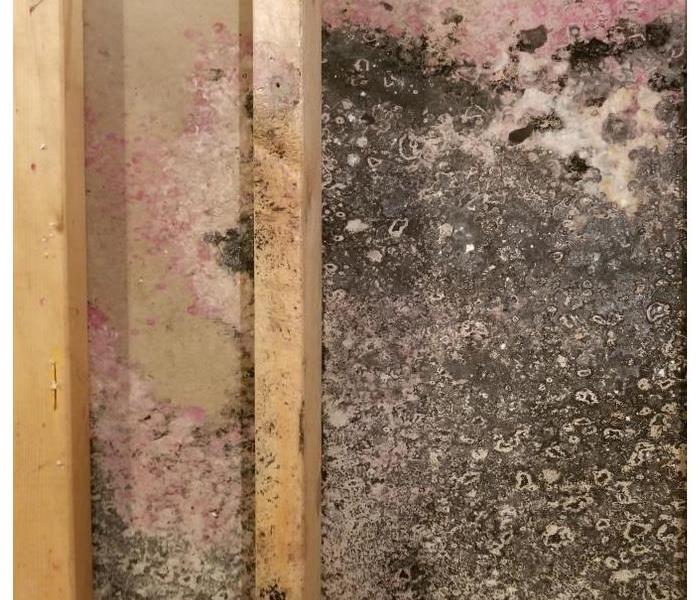 Mold can lead to structural damage if not taken care of soon enough.
Mold can lead to structural damage if not taken care of soon enough.
The Following Five Facts Help Prevent Fungus Growth
Could your business in Ross, OH, be vulnerable to mold growth? Should owners take precautions to protect the property from undesirable fungus? If so, what can be done, and how should proprietors go about it? The reality is that all property is exposed to mold, and, while you cannot keep spores out, owners do have the ability to try and ward off the growth.
1. They React to Moisture
Spores are in nature everywhere. They are already on the premises, invisible to the eye, They become troublesome when they react with wetness such as floods, high humidity, or dampness. For this reason, owners should be vigilant about plumbing problems such as leaks or overflows, contacting a water remediation company to assist in the cleanup process.
2. They Multiply Quickly
Once water and spores combine, mold growth is swift. Reproduction starts within one to two days, causing an infestation in a short amount of time. As long as the fluid is available, the microbes continue to spread without a problem. Moisture removal demands immediate attention.
3. They Penetrate Porous Objects
The eye cannot detect fungal spores, and they are tiny enough to absorb into porous objects. Materials such as drywall, ceiling tile, and carpeting soak them up, providing a welcome home with plenty of moisture to feast on. Be cautious around these substances, removing them from the area as soon as possible.
4. They Move Easily
The spores transport on shoes and in the air. Don't walk around the zone, and avoid running the air conditioner until you're sure it's not contaminated.
5. They Decompose Substances
When your building is affected by water damage, the spores begin to feast, eating away at the organic matter. Long-term exposure could cause harm to the building's structure.
Mold growth happens under the right conditions. Owners should understand that they cannot stop spores, but by monitoring dampness, they can prevent the development and spread.
The Best Cleaning Methods for Flood-Damaged Contents
1/13/2021 (Permalink)
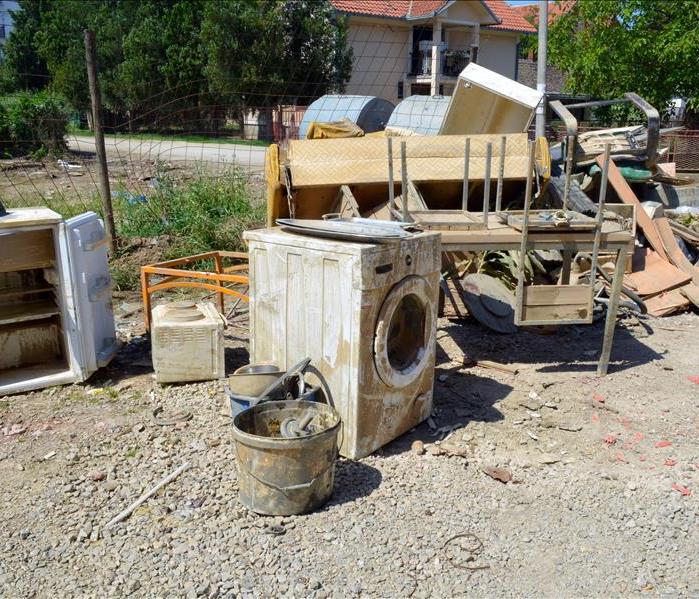 Flood-damaged contents in Trenton, OH
Flood-damaged contents in Trenton, OH
The Best Cleaning Methods for Flood-Damaged Contents
Any contents of a home that are exposed to flood water should be disinfected, cleaned, and deodorized. While homeowners may be able to clean up some limited flooding damage, the risk of mold can be greatly reduced by having content cleaning professionals remove items for off-site treatment and determine whether porous items can be restored to a residence in Trenton, OH.
Disinfection
A wide range of cleaning products are used to clean contents that have been exposed to flooding. Depending on whether items are porous or non-porous and the level of durability, any of the following solutions or systems may be used:
- Foam cleaner
- Liquid disinfectant
- Wet-wash machines
Content cleaning experts may recommend dry cleaning some delicate materials. While standard dry cleaning does not disinfect items, the application of heat during ironing, steaming or pressing processes eliminates some contaminants.
Stain Removal
Beyond disinfection, items may require cleaning to remove stains. Abrasion, immersion, spot, wet or dry cleaning may be effective methods for restoring the appearance of items that have become stained during or after flooding. Items that are severely stained by black water may be replaced prior to cleaning if doing so is more cost-effective than attempting cleaning.
Deodorization
Flood odor may linger in a location even after cleanup of the area and contents is complete. A deodorization treatment such as hydroxyl, ozone, or thermal fogging may be helpful for banishing residual odors in a location that was previously flooded. Pay close attention to musty odors, as these may originate in microbial volatile organic compounds or mVOCs released during the growth cycle of mold.
Some porous items cannot be fully disinfected or are not cost-effective to clean. These contents should be disposed of, reported as losses, and replaced. Expensive or rare objects may be restored through specialized content cleaning methods. Consult with storm damage restoration experts near Hamilton, OH.
What You Should Know About Category 3 Water Damage
1/4/2021 (Permalink)
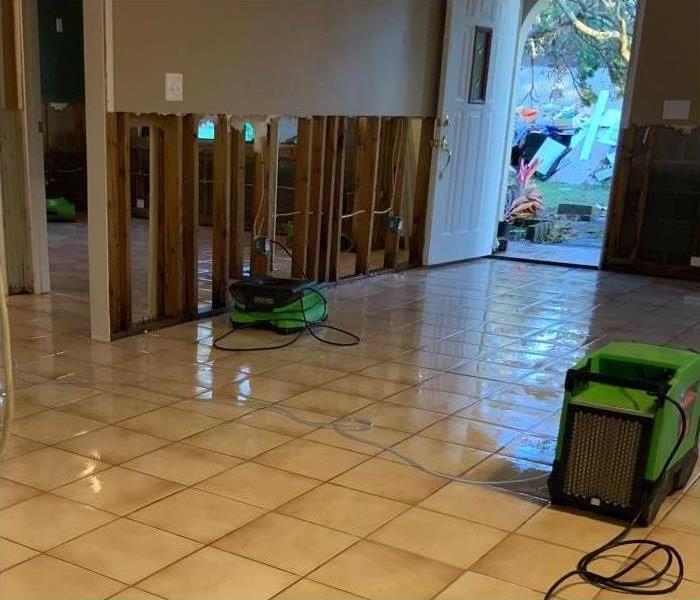 Water damage in an Oxford, OH home
Water damage in an Oxford, OH home
When water damage occurs to your home in Oxford, OH, it is vital to prevent additional issues as quickly as possible. You want to get everything cleaned up right away. However, when Category 3 black water is present, it is not safe to do this yourself.
What Are the Water Damage Categories?
Different water carries varying levels of health risks. The bacteria present depends on the source. Some potential causes of flooding in your home include:
- Weather events
- Clogged gutters
- Broken pipes
- Sewage backup
- Appliance malfunctions
There are three types of restoration categories based on the cleanliness of the floodwater:
Category 1 damage is from clean water resulting from broken pipes, overflowing sinks or bathtubs, and rainwater leaks. This water does not pose a health threat to people and can be cleaned by removing any standing moisture and drying with an air mover.
Category 2 water contains contamination from chemicals, mold, or bacteria stemming from broken dishwashers, overflowing toilets, sump pump failures, or broken aquariums. Cleanup of this type requires personal protection equipment and carpet padding replacement.
Category 3 is the cleanup process for black water, which contains toxins and organisms that cause illness and disease. This type of flood requires professional restoration experts.
What Are the Dangers of Sewage Cleanup?
When sewer backups or rising floodwaters occur, the water is extremely hazardous. Flooding from these sources can contain feces, chemicals, fertilizers, medications, tetanus, and many other risks. Professionals must clean this type of damage to ensure proper drying and sanitation.
What Should You Do to Protect Your Home and Health?
You must call a professional restoration service to address this type of hazardous flooding. The unsanitary water can seep into the structure of your home and cause significant health problems for you and your family. Experts will thoroughly disinfect and restore your home.
Damage from Category 3 black water is an emergency that you must address right away. Enlisting professional help to restore your home to normal is the best way to ensure proper cleanup procedures and precautions.
3 Steps for Filing a Fire Claim
1/4/2021 (Permalink)
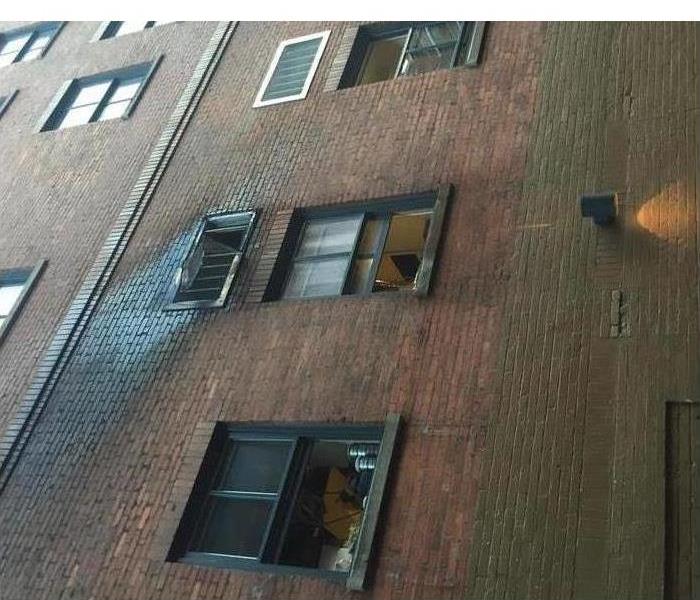 Fire damage in a hotel
Fire damage in a hotel
Steps To File Your Commercial Fire Claim
A fire at your business may seriously impact your ability to conduct business or halt it altogether. To get your business running at full capacity, it is important to take these three steps to file your commercial fire claim.
1. Contact Your Insurance Company
One of the first things you should do after a fire is to contact your insurance company to report your fire damage. Most insurance companies provide customers with multiple ways to begin this process. You may be able to file your claim by calling your insurance agent in Hanover Township, OH, or the claims department of your insurance company. Your insurer may provide a website or mobile app that will allow you to begin the claims process online. Be prepared to provide your policy number, address and a description of what happened and what was damaged.
2. Document Your Losses
When you file a fire claim, your insurance company will probably send someone to inspect your damages. However, it is useful to provide your own documentation, such as photos of the damaged property, receipts or other documentation that proves the value of your damaged property, recent maintenance records and proof of income. If you need to make temporary repairs, photograph the damage before you repair it and retain your receipts for supplies and labor used to make the repairs. Hold off on permanent repairs and fire restoration services until your insurance company gives you the go-ahead to proceed.
3. Keep Everything Organized
Write down your claim number and the names of anyone you talk to at the insurance company. Keep your photographs, damage estimates, receipts and other documentation in an easily accessible place.
Nobody wants to have a fire, but if a fire does occur, properly filing your fire claim can help you restore your business as quickly as possible. These three steps will help you with this process.
Top 4 Commercial Irrigation Troubleshooting Tips
1/1/2021 (Permalink)
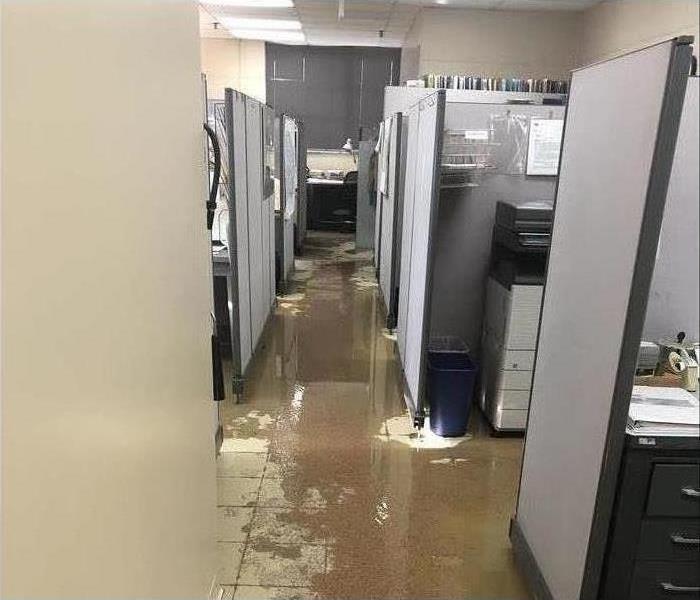 Water loss in a Hanover Township, OH office
Water loss in a Hanover Township, OH office
An efficiently functioning irrigation system is important to many businesses in Hanover Township, OH. Completing routine maintenance each spring can help you identify and address potential issues early, helping to minimize downtime. However, irrigation problems can develop during the growing season. Knowing key areas to troubleshoot can help you quickly restore your sprinkler system.
1. Ensure Adequate Water Flow
If your irrigation system is experiencing lack of water flow, you should check the main water valve and ensure that the water supply is on and then verify there is optimal water pressure. When reinstating water flow to your system, you should slowly increase pressure to minimize the risk of cracking or bursting components.
2. Check Controller and Sensors
If your system does not initiate, and you know there is adequate water pressure, proceed to the controller. You should test stations and valves to ensure they are receiving the appropriate voltage. In addition, review programming information to verify run time and start time settings and reprogram if necessary. You may also want to confirm that rain sensors are functioning properly and not interfering with normal operations.
3. Inspect For Clogs and Debris
Debris can cause valves to malfunction and clog sprinkler heads. You should remove all heads and clear any existing obstructions. You may also need to temporarily shut off the water supply, so you can dissect the valve, inspect its components and clear any clogs.
4. Assess for Damaged Elements
Analyzing the inside of your valves enables you to check the diaphragm and seals for damage and signs of deterioration. In addition to inspecting the internal components of valves, you should also check for broken sprinkler heads or leaks resulting from cracked lines or worn washers.
The Benefits of Routine Maintenance
Your irrigation system contains numerous elements that are essential of its functionality. To address potential irrigation problems and ensure optimal performance, it’s a good idea to complete an annual maintenance review every spring. Completing this evaluation also reduces the risk of potentially destructive sprinkler flooding, which may be costly and require extensive cleanup and restoration efforts.
Getting To Know Fire Extinguishers
12/14/2020 (Permalink)
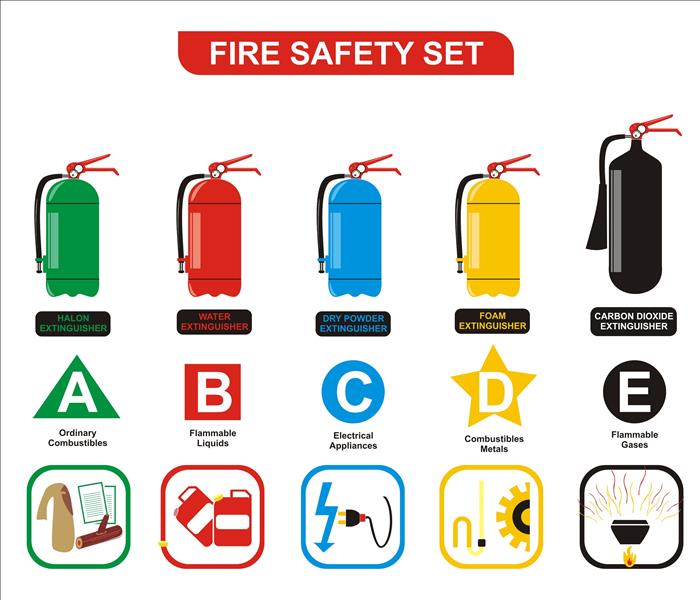 There are three types of household extinguishers
There are three types of household extinguishers
A fire extinguisher is a must-have for your home in Hamilton, OH. It can keep a small fire from getting out of hand or give you time to escape a large one. Choosing the right extinguisher is important, as is understanding how to use one.
Types of Extinguishers
There are three types of household extinguishers:
- Type A: Fires from combustibles like wood, cloth and paper
- Type B: Fires caused by flammable liquids like cooking oil or gasoline
- Type C: Electrical fires
Many household models are classified for all three fire types.
Extinguishers are available in disposable and rechargeable varieties. While rechargeable models are more costly, it is usually cheaper to refill them than purchase another disposable one when the gauge indicates low pressure.
The label shows the extinguisher's classification rating. The higher the number, the greater the effectiveness against each type of home fire.
Extinguisher Weights
The weight of an extinguisher refers to the amount of chemical inside. A 2-pound fire extinguisher is best for the car, a 5-pound model is good for the kitchen or laundry room and a 10-pound extinguisher is appropriate for a work area or garage.
How To Use an Extinguisher
For fire preparedness, it's best to know how to use an extinguisher before an emergency arises. An easy way to remember the steps is to use the acronym PASS:
- P: Pull the extinguisher's pin.
- A: Aim at the base of the fire, not at the flames above.
- S: Squeeze the trigger to release the agent.
- S: Sweep the extinguisher back and forth until the flames are gone.
After a Fire
Don't hesitate to call emergency services if you doubt whether the fire is out. Even a small fire can cause smoke, water and chemical damage in your Hamilton, OH, home. An emergency restoration company can help you clean up and restore your house to its pre-fire condition.
Along with an escape plan, owning a fire extinguisher and knowing how to use it is the best way to be prepared for a fire emergency in your home.
What’s the Real Scoop on Mold?
11/30/2020 (Permalink)
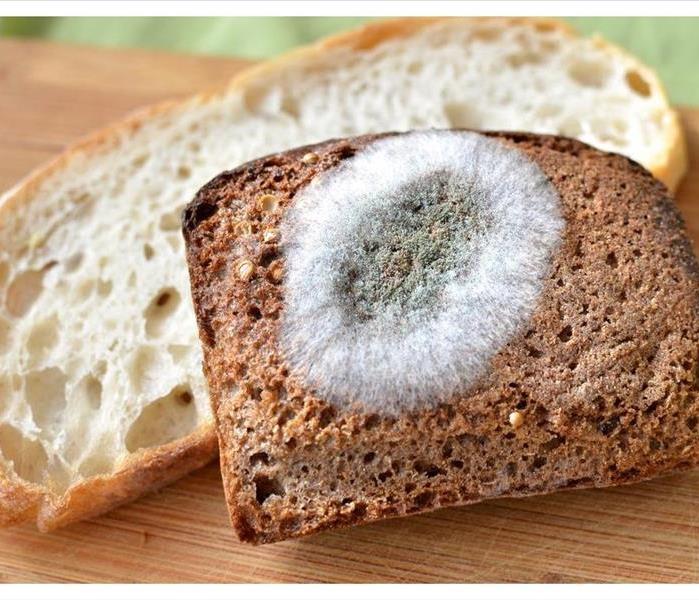 Bread mold is a common form because of the nutrients, warmth and moisture levels
Bread mold is a common form because of the nutrients, warmth and moisture levels
Here's What You Should Know About It With Respect To Your Home
You’ve probably heard of mold in the context of a structure or building that experienced mold damage. You’ve also probably heard of it associated with old food such as bread mold or fridge mold. Have you wondered about a connection between what’s found on food items vs the type that requires professional remediation and cleanup? As a resident in Oxford, OH, the black, blue or green fuzzy growth on your food is often a nuisance when it shows up on things you were planning to eat. It often has an odor and an unappetizing appearance and taste. Here’s what you should know about it with respect to your home.
Understanding Mold
Mold is a type of fungus and like other types of fungi it thrives on plants and animals as food source. It exists in the form of microscopic spores that are found everywhere, including the air. When these spores settle on certain surfaces such as food, mold forms. Fungus growth is impacted by the following factors:
Moisture levels: Mold loves water.
Temperature: Warmer environments spur growth.
Aeration: Sealed packaging inhibits mold formation.
Light levels: Different types of fungi respond differently to available light.
Nutrients: Some fungi thrive on sugars, whereas others feed on salt.
pH levels: Most varieties survive in environments that are more acidic than alkaline.
Bread mold is a common form because of the nutrients, warmth and moisture levels typically associated with its storage. The mold that forms on most food surfaces does not usually pose a threat to a building structure or its contents.
Dealing with Mold
Maintaining a clean environment requires discarding of items that contain bread mold. If you have mold damage in your home, especially as a result of water damage, call a provider of professional mold remediation services who is trained and equipped to safely clean your house, restoring it to pre-damage conditions as quickly as possible.
Why You Need To Protect Pipes During the Winter
11/24/2020 (Permalink)
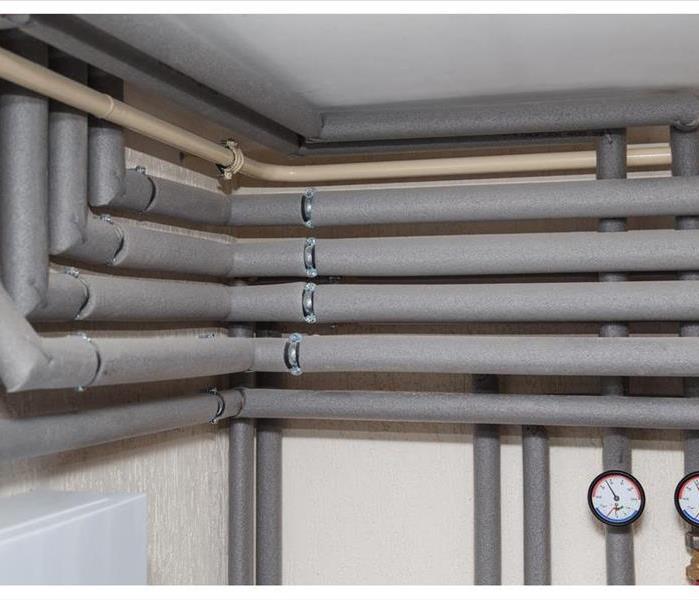 Protect your pipes during the winter
Protect your pipes during the winter
During the winter in Hamilton, OH, it is essential to prepare your home for below-freezing temperatures. Taking pipe freeze prevention measures will keep your home from flooding due to a burst pipe.
What Causes a Pipe To Burst?
Sub-zero temperatures cause the water inside pipes to turn to ice. As ice forms, it expands and creates pressure on the surrounding structure. Eventually, this expansion becomes uncontainable and leads to a burst pipe. Frozen pipes which are susceptible to bursting include ones found in uninsulated spaces, including:
- Kitchen and bathroom cabinets
- Garages and basements
- Attics and crawl spaces
- Exterior walls
A flood cleanup company can help dry out carpets or other furnishings if a burst pipe drenches them.
How To Keep Pipes From Freezing
During the cold months, pipe freeze prevention is achievable by insulating all exposed pipes or maintaining adequate heat circulation around them. These measures can ensure that the water inside does not freeze. Maintaining a consistently warm temperature throughout the day and night, and keeping the heat on while you are away from home will help avoid frozen pipes. Turning on the faucet to allow cold water to drip also ensures that the water traveling through exposed pipes does not freeze.
How To Keep Frozen Pipes From Bursting
If water drips out slowly when you turn on the faucet, this could indicate that your pipe is frozen, and, despite your pipe freeze prevention measures, you need to act quickly. If you determine that a burst pipe has not occurred, cover a portion of the exposed pipe with a heated blanket or use a hand-held hair dryer to warm it gradually. Be careful to avoid extreme heat shock, which could increase the risk of a burst pipe. Keeping the faucet turned on will encourage the existing water flow to dissolve the ice.
If you experience flood damage due to frozen pipes in your Hamilton, OH, home, contact a flood restoration company to handle the cleanup.
5 Ways to Prepare Your Business Before a Storm
11/10/2020 (Permalink)
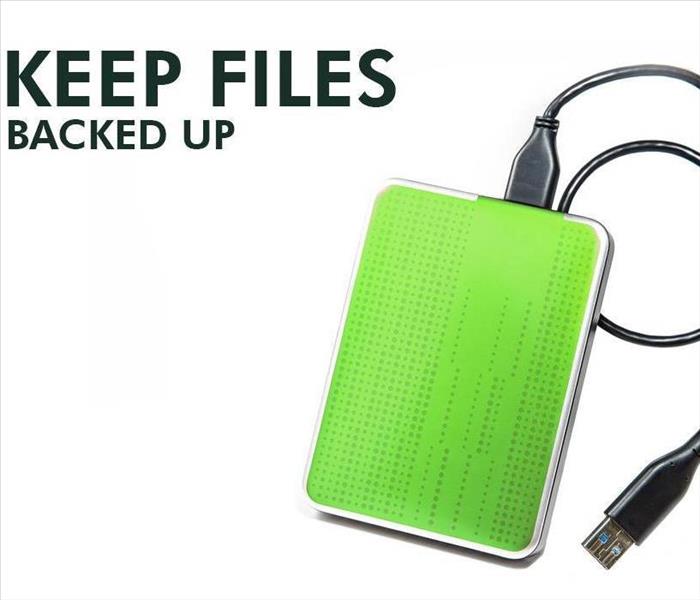 Back up your information to an external drive to keep them safe
Back up your information to an external drive to keep them safe
Disaster Preparedness Tips
Disaster preparedness can help keep your Oxford, OH, business running smoothly after a storm. There are several steps that you can take to get ready when you are expecting severe weather.
1. Back Up Important Documents
Whether flooding from the rain damages your electronics or a power surge ruins a computer hard drive, this can lead to the loss of important files. Back these up onto cloud storage or an external drive to keep them safe.
2. Move Objects to Higher Floors
If you are expecting a flood, move important or expensive items, such as paper documents, upholstered furniture and computers, to a higher floor. This will keep them from absorbing water in case it gets inside the building.
3. Inspect the Building
Your building is more likely to be affected by severe weather if it is already damaged. An essential part of disaster preparedness is inspecting the building and making necessary repairs. You can hire a cleanup and restoration company to do this for you.
4. Create an Emergency Plan
Business preparedness should also include a plan for dealing with emergencies while you are at work. Know what you will do if the power goes out or the weather becomes dangerous. Make sure all of your employees know what to expect during this situation.
5. Prepare to Work From Home
Something else that you can do to keep everyone safe is to make plans to work from home. This will eliminate the need for travel in hazardous conditions while allowing you to remain productive. If you need to, find a way to keep everyone connected during this time, so you can get in touch for any necessary discussions.
Using these tips for disaster preparedness, you can limit the ways in which a storm will affect your business. It is important to keep not only your building safe but your employees as well. Take the time to account for both in any plans that you make.
How To Prepare a Fire Escape Plan for Your Business
10/26/2020 (Permalink)
 Workplace security mandates that every company has a contingency plan at the ready
Workplace security mandates that every company has a contingency plan at the ready
Prepare a Fire Escape Plan For Your Business
When it comes to minimizing harm during a fire, having a contingency plan in place is the most important measure any business can take. Follow the below guidelines to create one for yours.
Check Your Equipment
Before establishing an evacuation plan, make sure you have up-to-date and operable:
- Emergency lights
- Fire doors
- Extinguishers
- Alarms
- Bullhorns, whistles or megaphones
These items are critical to executing effective, organized escapes during emergencies in Morgan Township, OH. If your location needs improvements in relation to any of these elements, consult a fire safety expert who can provide proper guidance.
Create Your Plan
Discuss with your team where fires are likely to break out, why they might start and what should be done during specific scenarios. Your contingency plan will benefit greatly if you first examine the overall picture before getting lost in the details.
Have at least two escape routes for every location. Post maps illustrating these paths in clearly visible, well-trafficked areas. Reinforce this information through mass emails explicitly outlining specific steps to be followed. Remind employees that heavy equipment such as chairs and filing cabinets can be used to break windows if an alternative passage is needed.
Designate outside spots where groups are to gather. The individual tasked with performing a headcount should have everyone’s name and assigned assembly point at the ready. Remember that each post must be spacious enough to comfortably accommodate the expected number of employees.
Running practice drills provides assurance that everyone knows exactly where to go and what to do during a true fire event. Besides extensive damage requiring a commercial fire restoration professional to fix, actual blazes create panic and confusion. Therefore, never warn your staffers ahead of time. The element of surprise is an essential ingredient in revealing any plan’s weaknesses.
Workplace security mandates that every company has a contingency plan at the ready. Put one together as soon as possible if yours is not already protected.
Why Should I Call a Restoration Company After Water Damage?
10/26/2020 (Permalink)
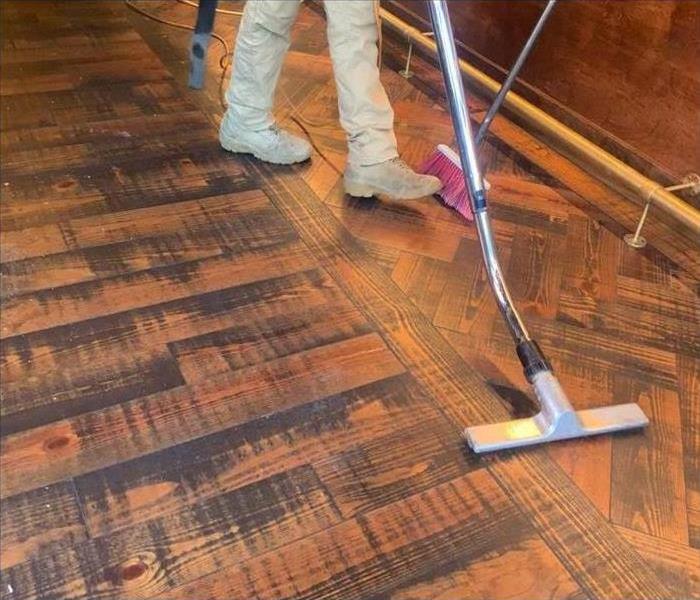 Extracting water in a Hamilton, OH commercial building
Extracting water in a Hamilton, OH commercial building
Why Should I Call a Restoration Company After Water Damage?
In the wake of a water disaster at your commercial property in Hamilton, OH, panic can set in. Whether it’s a broken pipe that requires a pipe burst cleanup or a sewer leak, you must take immediate action. While it may be possible to do the job yourself, hiring restoration professionals will ensure that your building is back up to code as soon as possible. Every second makes a difference when it comes to the amount of damage that could ultimately be incurred.
Restoration experts will:
1. Perform a Thorough Inspection
By hiring a restoration company, you’re ensured that the damage will be thoroughly assessed and resolved. Water and humidity can seep into the tiniest of spaces. The professionals know all the areas to inspect for water damage so that a plan can quickly be made to restore the property and salvage as much as possible.
2. Protect Your Contents
After a water disaster, contents may need to be moved to a safe location. This will give them a better chance of being salvaged.
3. Extract the Water
The best method of extracting standing water, such as a pipe burst cleanup, is with a wet/dry vacuum. It’ll quickly and safely remove the water and small debris. Water damage cleanup experts will use industrial-grade pumps.
4. Dry the Building and Contents
Restoration professionals will use several techniques to dry the affected area and its contents. Industrial dehumidifiers and fans are just a couple of these methods. Some of the contents, including documents and photographs, can be taken to dry and restore off-site.
5. Clean and Sanitize the Building and Contents
Even if the flood is due to a broken pipe, cleaning and sanitizing will be necessary to remove mold and mildew or, ideally, to prevent it altogether. In the case of a sewage leak or toilet overflow, a sewage cleanup company will need to sanitize after completing the initial cleanup.
Whether a pipe burst cleanup or a sewage cleanup is required, a restoration is your best bet. They’ll do a thorough inspection and cleanup, returning your property to its preloss condition as quickly as possible.
Types of Water Contamination
10/12/2020 (Permalink)
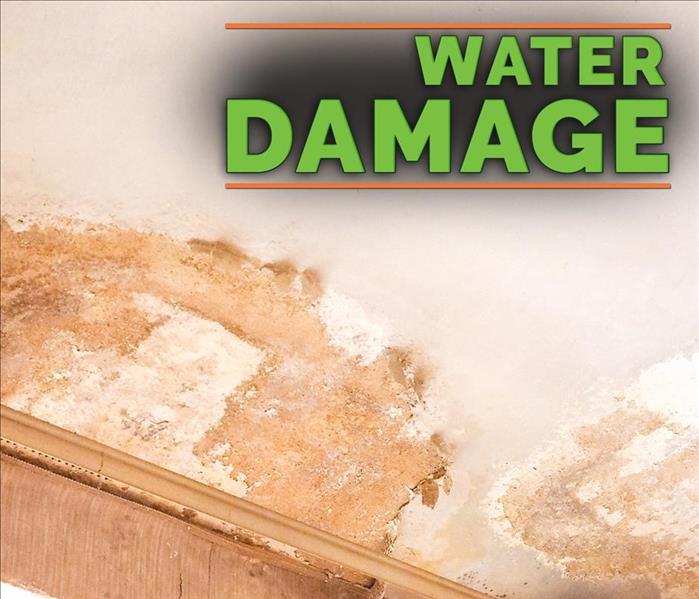 There are three categories of water damage
There are three categories of water damage
Water Damage Categories
Not all floods are the same. There are three different types of floodwater, each categorized by the type of contaminants present in the flood. Among the three categories, black water floods are, by far, the most dangerous. Read on if your residential property in Lemon Township, OH, has recently fallen victim to a flood.
Clean Water Floods
Category 1 floods, also known as clean water floods, are categorized by an absence of contamination. They are typically caused by a supply line burst or overflowing bathtub or shower. They are the least dangerous types of floods, but are still certainly capable of causing massive amounts of water damage if left untreated. In theory, Category 1 flood water is safe for human consumption, but you should still never attempt to drink it.
Gray Water Floods
Category 2 flood water is the next step up from a clean water flood. These floods contain some degree of contamination, although not on a lethal level. They are usually the result of overflowing household appliances, such as dishwashers and washing machines. If left untreated for more than 48 hours, gray water floods can quickly turn into Category 3 floods.
Black Water Floods
Category 3 floods are the most dangerous types of floods. They are categorized by the presence of human/animal fecal matter, raw sewage, dangerous chemical and other types of biohazards. You should never attempt any type of sewage cleanup or flood remediation by yourself when it comes to these types of floods. Instead, you need to contact professional help as soon as you can.
Blackwater floods can cause catastrophic amounts of damage to your residential property if they aren't handled quickly and correctly. Attempting to handle these types of floods by yourself is extremely dangerous due to the biohazards present in the flood itself. Contact flood remediation experts immediately if your home is suffering from any of the floods listed above.
Top 5 Places to Look for Mold
9/28/2020 (Permalink)
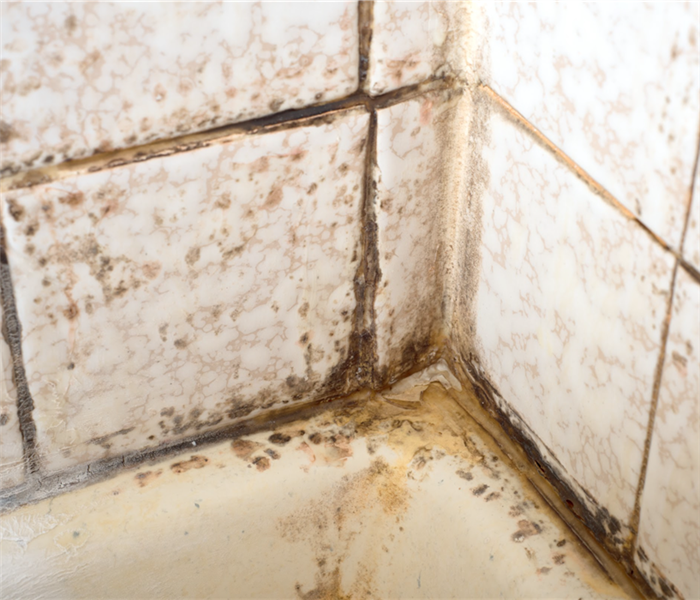 Mold damage in a Layhigh, OH bathroom
Mold damage in a Layhigh, OH bathroom
Common Places That You May Find Mold
Mold growth is an extremely common issue that the majority of homeowners must face at some point. If left unchecked, mold damage can wreck havoc on your home in Layhigh, OH. Because it can be so difficult to deal with, your best bet is to take preventative measures and catch any unwanted fungal growth early. Here are some of the most common places you can find residential mold.
1. Your Bathroom
Mold thrives in damp, dark, moist environments, making your bathroom the perfect fungal breeding ground. Check for mold and mildew growth in your shower, bathtub, sinks, and other fixtures.
2. Your Kitchen
Your kitchen also comes into frequent contact with water, especially while cooking and washing dishes. Check underneath your kitchen sink for mold growing in the cabinets. You also need to make sure that you're cleaning your refrigerator pantry out regularly, as mold often grows on outdated food items.
3. Your Living Room
Any liquid spills that occur in your living room leave your carpeting at risk for mold damage. All spills must be cleaned up immediately and thoroughly in order to protect your carpeting. Mold can also appear in your household plants if you tend to overwater them.
4. Your Basement/Attic/Garage
Any unfinished storage areas in your house are also at risk for mold growth. Check any exposed water piping for signs of mold or mildew, especially after leaks or other types of water damage. Mold can also grow in the insulation in your attic.
5. Your Laundry Room
Thoroughly check your washing machine for signs of mold. It's natural to assume that these machines would be self-cleaning, but the built-up moisture that they leave behind is extremely inviting to fungal growth.
As a general rule of thumb, mold damage can occur in any area of your house that comes into frequent contact with moisture. If you suspect that your home is experiencing unwanted mold growth, you need to contact mold remediation experts as soon as possible.
The Fire Damage Restoration Process
9/15/2020 (Permalink)
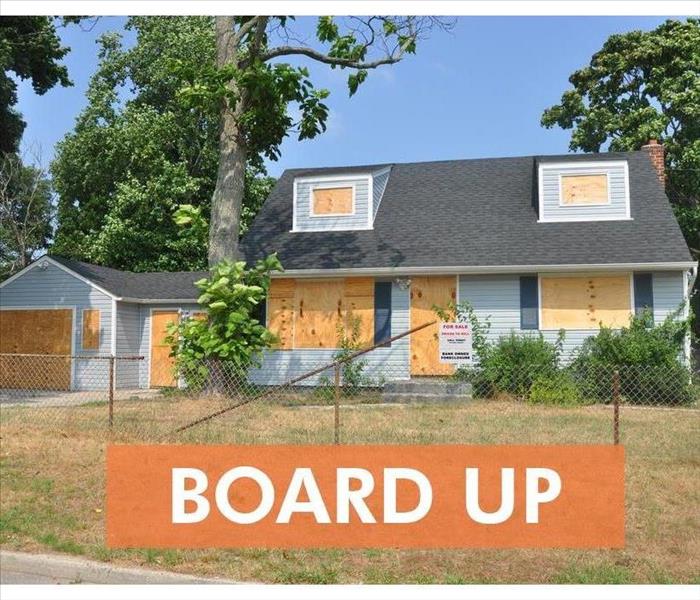 Board up home in Millville, OH after fire damage
Board up home in Millville, OH after fire damage
The Following Steps Outline The Process
Fire and smoke damage to your Millville, OH, home can be a major hassle. Fortunately, understanding the restoration process can help you get your home back to normal more quickly.
1. Assess Damage
After the authorities say it is safe to do so, return to the property and survey the damage. Take photographic or video documentation for the insurance company.
2. Secure Property
Board up or tarp over broken windows and other openings in the structure to keep out wildlife and inclement weather. In some cases, it may be necessary to install a security fence to keep trespassers from entering the property.
3. Dry Property
If water was used to extinguish the fire, dry out the property as soon as possible. Wet/dry vacuums, pumps and dehumidifiers can all help with this process. If the outdoor humidity is low enough, you can also open windows and doors to increase airflow. Remember to act quickly because mold can begin to grow in as few as 24 hours.
4. Clean Affected Areas
Soot and smoke damage can be particularly difficult to deal with. Smoke odor can linger for years if not properly addressed, and soot damage can be compounded if the wrong cleaning products or methods are used. Fortunately, an experienced restoration service can make sure soot and smoke cleaning are both done thoroughly and correctly.
5. Repair and Replace Damaged Items
Depending on the extent of the fire damage, you may be able to salvage some items. Some homeowners can complete simple repairs themselves, but many will need professional assistance, particularly with delicate items like antiques and electronics.
A damaged building is vulnerable to wildlife and vandals. Standing water fosters mold growth, and soot can be corrosive. If your home experiences fire and smoke damage, it is important to begin the restoration process as quickly as possible to prevent further damage.
Three Facts About Mold Survival in Buildings
9/15/2020 (Permalink)
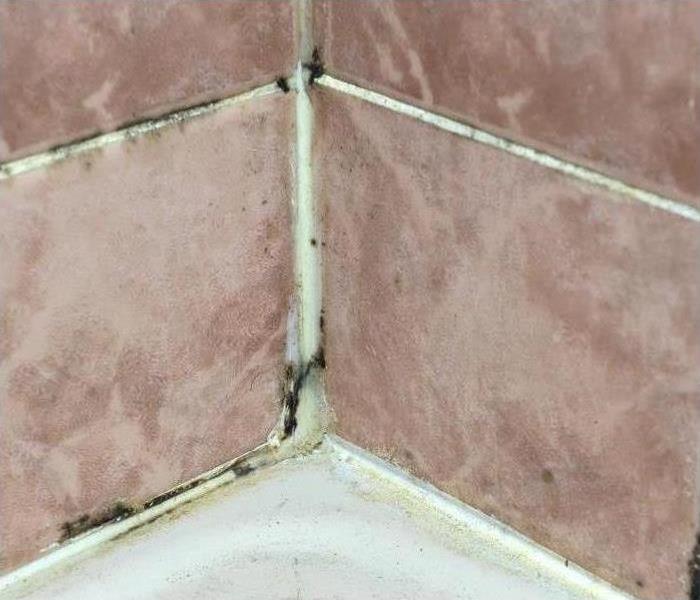 Prevention is the best solution to bathroom mold
Prevention is the best solution to bathroom mold
If you can't see mildew in the bathroom, is it really a problem? After all, if bathroom mold is out of sight, under the carpet, or tucked into the corners of the window, it's contained; right? Actually, seen or unseen, mold growth indicates an underlying problem and that often involves too much moisture. Take a look at three important facts about mold and how it survives on your Hamilton, OH, property before you contact professionals to make your property mildew clean.
1. Its Purpose Is Decomposition
Although there are many, many types of these encroachers, they all have one goal in common; digest and decompose the organic compounds around them. The good news is that mold is responsible for the decomposition of dead trees, animals, and vegetables. The bad news is that the wood used in your building, the paper on your sheetrock, and the people living or working in your buildings are organic.
2. There Are Hidden Sources of Mold Nutrition All Over Your Buildings
Mold can't survive on all surfaces, but many of the materials used to construct buildings do support it. For example, the cellulose in insulation glues used on carpeting, and the moist, hidden areas under the sink all give bathroom mold a place to live and reproduce. Bare earth floors in crawlspaces and freshly cut firewood emit a lot of moisture. However, if you're able to decrease humidity or limit the amount of moisture in your home, you can prevent much of the spread of mildew.
3. Mold Spores Are Airborne
These tiny specks of spore are hard to filter out of the air. They hang suspended in the air for hours at a time, and they travel easily from one area of a building to another. This means that even if get one part of your building mold and mildew clean, you could still have trouble elsewhere.
Prevention is the best solution to bathroom mold. Keep restrooms clean and dry to prevent further growth. If grout or caulking shows signs of contamination, replace them. Achieving a state of mold and mildew clean properties take time and effort, and sometimes the involvement of Hamilton, OH, professionals.
Fortune Favors the Prepared
9/8/2020 (Permalink)
 Prepare yourself and your employees by signing-up for First Aid and CPR training
Prepare yourself and your employees by signing-up for First Aid and CPR training
Are You Prepared?
Every business owner in Ross, OH, should have a plan to stay in business in the event of a natural or man-made disaster. Why? Business preparedness protects your hard-earned investment and improves the chances of uninterrupted operations during a crisis. Effective disaster preparedness comes down to common-sense measures that can help you manage an emergency and ensure your business' recovery from disruption. Here are some ideas:
Plan
Stay informed. Assess your business's risk against different potential disasters.
Determine which employees, resources, and equipment are essential to operations and survival.
Devise nonstandard ways to work with key customers and contractors during and after a disaster.
Develop alternate relationships with "just-in-case" suppliers. Avoid reliance on one vendor.
Formulate options if your workplace is inaccessible.
Plan for post-disaster recovery by collaborating with a local disaster response and restoration company.
People
Write a Crisis Communications Plan outlining fallback communications with employees, local authorities, customers, and suppliers.
Maintain a fully-stocked emergency supply kit, First Aid pack, and sanitation and "seal the room" provisions.
Encourage employees to bring in customized emergency kits.
Prepare yourself and your employees by signing-up for First Aid and CPR training.
Develop an evacuation plan, specifying a chain of command, assembly site, and emergency routes.
Create a shelter-in-place plan, to include protective "seal-the-room" measures.
Coordinate with collocated businesses to conduct joint emergency exercises.
Review business preparedness plans annually with employees.
Protect
Check your business insurance coverage, to include losses from physical damage or destruction.
Prepare for utility disruptions by considering back-up options.
Store extra supplies, materials, and equipment to ensure post-crisis business continuity.
Keep smoke alarms, fire extinguishers, and emergency lights in good working order.
Store copies of business-critical documents and records in a water-proof, fire-proof container.
Disaster preparedness is an investment in your business' future. While no one wants to dwell on potential disaster scenarios, it's good business to remember that fortune favors the prepared.
When Not to Use Bleach for Cleaning Mold
8/14/2020 (Permalink)
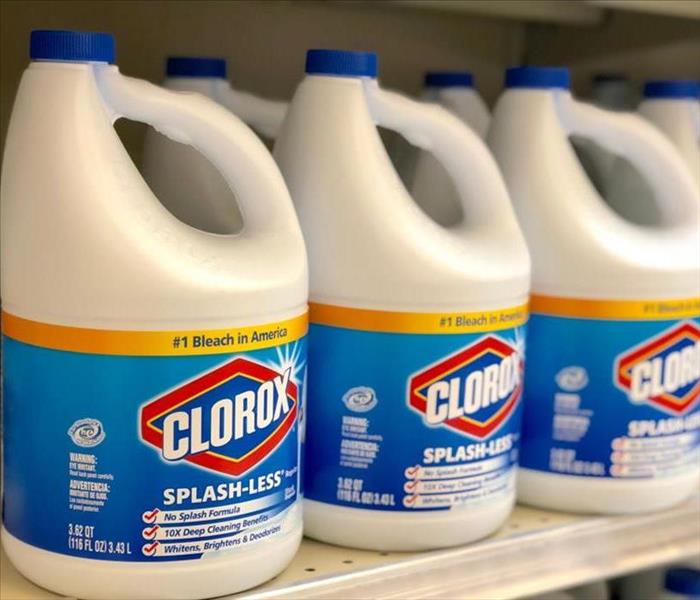 Never use bleach to clean mold from porous elements
Never use bleach to clean mold from porous elements
In the event your office becomes infested with mold, you will want to begin a fungus cleanup right away. When starting, take care with your selection of disinfectant, as the wrong choice may exacerbate the problem.
Porous Materials and Mold
While bleach is a perfect answer for glass, metal, and hard plastic, never use it to clean mold from porous elements. Here’s why:
- Mold’s roots dig into surfaces such as wood, plaster, and drywall. Bleach works only upon the surface and the water may actually help mold grow from underneath.
- Chlorine spreads harmful pollutants called dioxins and washing with chemicals can actually damage what you are cleaning.
- Over time, bleach evaporates, meaning its effectiveness degrades over time. It’s impossible to tell how compromised your fungus cleanup agent has become merely through visual inspection.
Effective alternatives can be concocted using tree seed oil or grapefruit seed extract without any of the above drawbacks.
Cleaning Mold off Porous Materials
The most common homemade solution for removing mold is by spraying white vinegar then hydrogen peroxide onto the desired area. Be sure, however, to use protective gloves and facemasks no matter what solvent you choose and always saturate the affected items in a well-ventilated space. Depending upon what you are purifying, surfaces may be left to dry naturally. Otherwise, wait 10 to 15 minutes then get scrubbing. Fans and dehumidifiers can aid you in speeding up the drying process. Failure to comprehensively clean up mold may result in its return, so make doubly sure all spores have been eradicated with an air-filtered vacuum cleaner. Once you have handled these tasks to the best of your ability, employ a mold removal specialist to be positive everything has been eliminated.
Only use appropriate solvents on porous items during your fungus cleanup in Hanover Township, OH. For confirmation that the mold has completely disappeared, seek assistance from a reputable mold rehabilitation service.
Preventing Water Damage During Construction
8/14/2020 (Permalink)
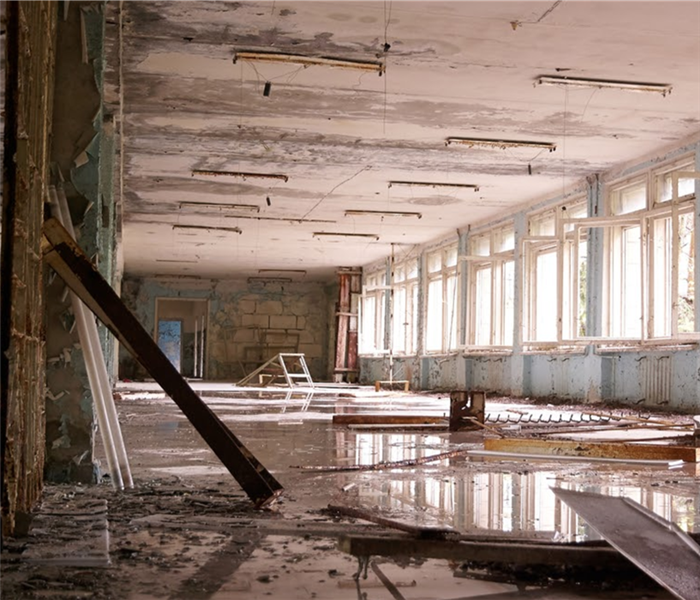 Water damage in a building while in construction
Water damage in a building while in construction
Water damage can be a major problem during a construction project in Trenton, OH. Whether from external or internal sources, water can cause a tremendous amount of physical loss. It can also lengthen the amount of time needed for a project. In the era of accelerated building schedules, a small problem can lead to large losses. For instance, contractors may face water pipe repair fees and the cost of hiring water damage remediation professionals to clean up the flooded area. They may also leave the contractor with an unhappy client and prevent them from getting more jobs. However, prevention can be the key to success.
Have a Plan
Before even starting a construction project, contractors should review the potential for water damage. Then, they should incorporate methods to reduce these risks into their project plan. For example, early in the construction process, groundwater and weather-related events could be dangerous. Preventing loss due to these types of risks will require that the contractor examines the site thoroughly. This will allow them to figure out which dewatering systems are the best for the site. Some potential types of equipment they may use include:
- Special site grading
- Stormwater drains
- Pumps
Once the building is complete and the electric, plumbing, and other systems are being installed, contractors have to worry about a new set of issues. At this point, almost every incidence of water damage has serious consequences. The chances of water damage also become greater. Therefore, this is where contractors will need to have a plan in place to prevent water damage and deal with it when it occurs. For instance, they will likely set aside funds for potential issues that could occur, such as burst plumbing and water pipe repair fees.
Having a plan in place before starting construction can prevent incidences that can lead to water damage, such as a broken pipe. Contactors will also benefit from having preventative measures in place because it plans for issues that could arise from water damage, such as water pipe repair fees.
What Can Be Saved After Your Home Floods?
8/3/2020 (Permalink)
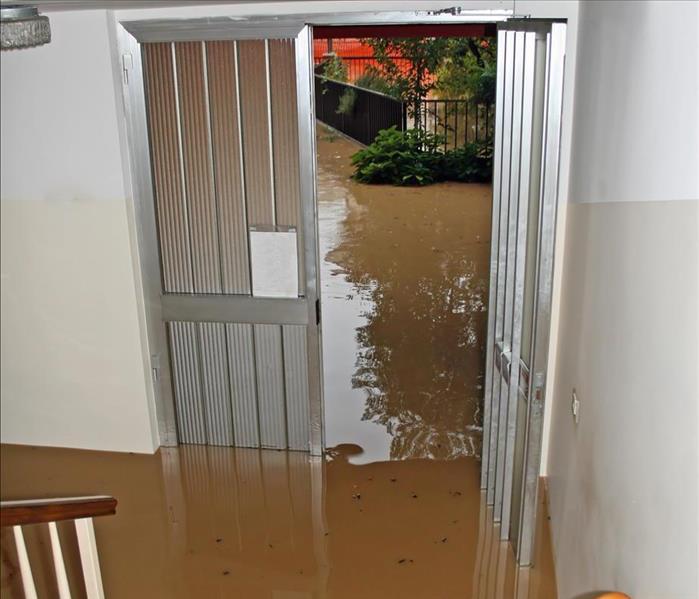 Floodwaters in Oxford, OH
Floodwaters in Oxford, OH
If your home in Oxford, OH, ever fills with floodwater, conduct a thorough content cleaning before your return. While some items may be salvageable, other items will not.
Levels of Contamination
Floodwaters have three danger levels:
1. Clean Water
Clean water comes from a clean source, such as a broken supply line. While not harmful, this water might become dirty over time.
2. Gray Water
This second level contains some contamination. Washing machine and toilet overflow fall into this category.
3. Black Water
The most contaminated grade, black water may include chemicals, microbes or even sewage and must be removed.
Even if you believe your house has only suffered clean water damage, there is a chance gray or black water has intruded without your knowledge. This means comprehensive content cleaning is always required.
What Must Be Thrown Away
Except for canned goods and food inside intact, airtight plastic containers, discard all consumables, including pet food. Your medicine should also be disposed of, so acquire refills for prescriptions. Anything porous that has come in contact with polluted water must be trashed.
What Can Be Recovered
Hardwood and composite cabinets, upholstered furniture and drywall may be reparable. If these areas have sustained damage, hire a flood restoration professional for a comprehensive rebuild. Appliances and electronics may be reused once inspected by a technician, provided they have not been submerged. Non-porous toys can be cleaned with detergent and disinfectant. Damp mattresses may be dried using towels, but bedding that has come in contact with corrupted water needs to be abandoned. To determine if your carpet can be kept, pull on a corner. If you find yourself holding a fistful of fibers, it must be replaced.
After a flood, executing an intensive content cleaning is imperative before moving back into your home. Careful determination of what can and cannot be saved will keep both you and your family safe.
4 Keys To Understanding Residential Fungus Growth
7/20/2020 (Permalink)
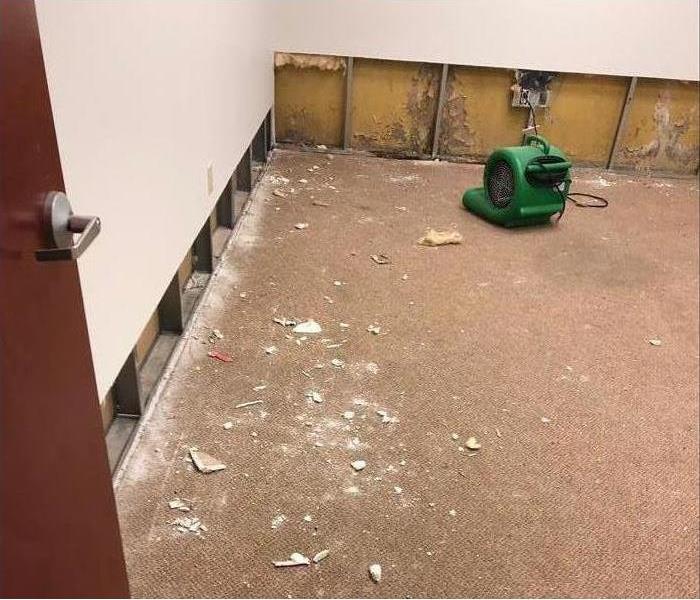 Mold damage behind walls in a Hamilton, OH home
Mold damage behind walls in a Hamilton, OH home
Ways to Deal With Mold Or Mildew
When you find an ugly patch of fuzzy or slimy growth on the walls of your home in Hamilton, OH, it can be a depressing moment. A number of questions are likely to swirl through your mind. More than likely, you have heard frightening stories of mold damage to homes. A better understanding of fungal growth can offer some reassurance. Here are some of the most important things to know about dealing with an infestation of mold or mildew.
1. Pervasiveness. Microscopic mold spores exist nearly everywhere, both inside homes and in the outdoors. In fact, a test of your home even in the best of conditions is likely to reveal the presence of fungal spores. It is only when the spores form into significant colonies that mold damage is apt to occur.
2. Growth. A fungus grows best under certain conditions. It can expand rapidly when your home has humidity above 45 percent or when a water problem such as a plumbing leak or a failing roof is present. A mold remediation company will seek to eliminate the source of excess moisture. Once this issue is addressed, the fungal growth can be removed.
3. Identification. Mold growth is serious because it can be hard to eradicate and can cause damage to a home. It tends to penetrate deeply into porous surfaces such as paper, cellulose, wood, and fabrics. Mildew growth is less invasive and more easily cleaned from a home.
4. Restoration. Any serious infestation of mold in your home requires a professional effort to get the situation under control. Certified technicians use advanced techniques and sophisticated equipment to contain the outbreak. Professional cleaning methods prevent the mold from returning. Structural repairs to walls and ceilings are sometimes needed to fix mold damage, while in other cases a fresh coat of paint is enough to restore your home to good condition again.
Can Office Electronics Still Work After a Fire?
7/1/2020 (Permalink)
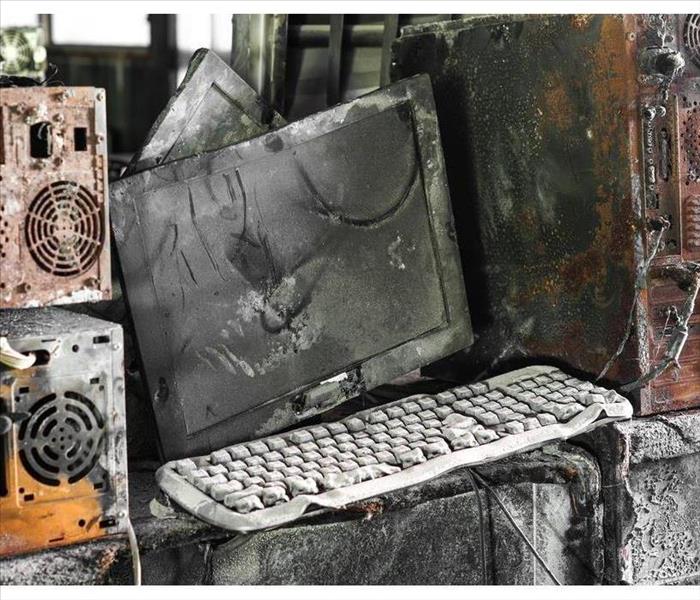 Do not use electrical equipment that has been exposed by heat.
Do not use electrical equipment that has been exposed by heat.
Electronics are very sensitive to heat and smoke. After a fire at a commercial building in Morgan Township, OH, these devices are some of the most costly contents to clean or replace. The condition and electrical fire risk of an appliance, computer, or device depend on the proximity to open flame, the highest temperature reached, and whether the device was powered on during a fire and extinguishing process.
Check the Condition
An external visual inspection may be enough to determine whether electronics have been exposed to open flame, intense heat, smoke, and soot. The following factors often determine the viability of a fire-damaged device:
- Melted exterior or components
- Signs of being burnt or charred
- Indications of water exposure
Damage may be more significant if a device was powered on during a fire. A building or business owner should never attempt to turn on electronics that may have sustained fire damage. These items can cause an electrical fire.
Get an Expert Opinion
Content cleaning specialists have access to clean rooms and precision equipment for assessing the condition of electronics. Since smoke damage can corrode metal, it is important to look beyond surface issues. In a safe environment, trained experts can check the condition of circuits and internal components.
Restore or Replace Electronics
It may be more affordable to replace some electronics than to attempt computer cleanup or repair. Circuits or other components exposed to high heat or water may not be capable of reliable repair to reduce the risk of another fire. In many cases, it is safer to replace electronics affected by the fire and retrieve and transfer any data that can be salvaged from the physical memory of devices.
A building or business owner should never attempt to test electronics by turning an appliance, computer, or device on after a fire. Specialized equipment is necessary to safely determine whether electronics are likely to short-circuit and start an electrical fire.
Proper Fire Extinguisher Use
6/8/2020 (Permalink)
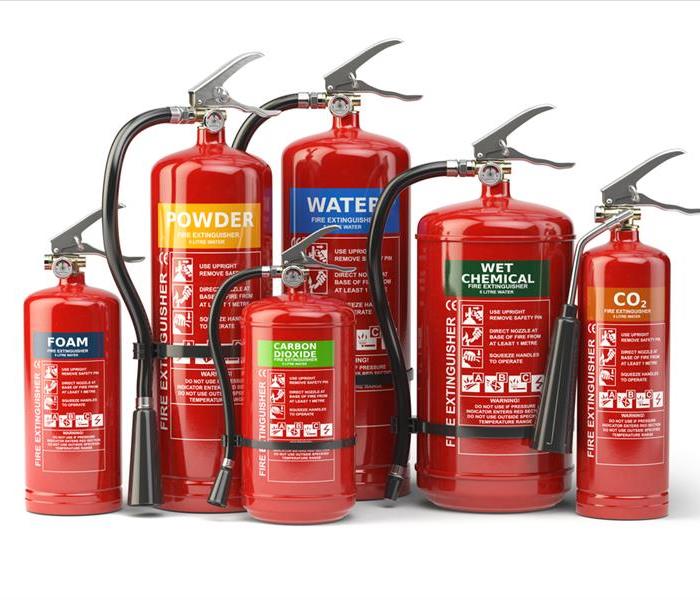 There are four main types of extinguishers
There are four main types of extinguishers
A fire in your Lemon Township, OH, home can easily lead to feeling panicked. If the flames are beyond putting out, get out and call 911. Safety should be the top concern. A smoke and fire damage restoration expert can repair the losses. If you have confidence that is a manageable small fire, the best defense is to grab the fire extinguisher. Before that situation ever happens, it is important to understand the type of extinguishers that are in your home and how to properly use them.
Types of Extinguishers
There are four main types of extinguishers typically found in a home that are used for specific causes of a fire.
Class A: Solid combustibles, such as wood, paper, and fabric
Class B: Flammable liquids, such as oil, petroleum, and gasoline
Class C: Electrical, such as faulty wiring, fuse boxes, and appliances
Class K: Cooking oils and grease, including animal and vegetable fats
Every extinguisher is clearly labeled to ensure it is used in the right situation. There are also some combination extinguishers designed for use on A, B, and C fires. For a kitchen fire caused by grease, a Class B or K should be used.
Proper Use
If the time comes to use a fire extinguisher, below are three important steps to take.
Before using it, determine the safest escape route, as well as a backup route, in case you are unable to put out the fire.
Keep space between you and the fire. A good rule of thumb is a minimum of six feet away.
Face the fire and prepare to follow the PASS method of use. Pull the pin. Aim the nozzle at the base of the fire. Squeeze lever or handle to discharge. Sweep nozzle side to side until the fire is out.
A fire extinguisher is the first line of defense for keeping a small flame from turning into a big fire. Beforehand, knowing the types you have and how they work can help you stay a little calmer in a real emergency.
Committed Teams Speed Up Claims, Restoration Processes
6/8/2020 (Permalink)
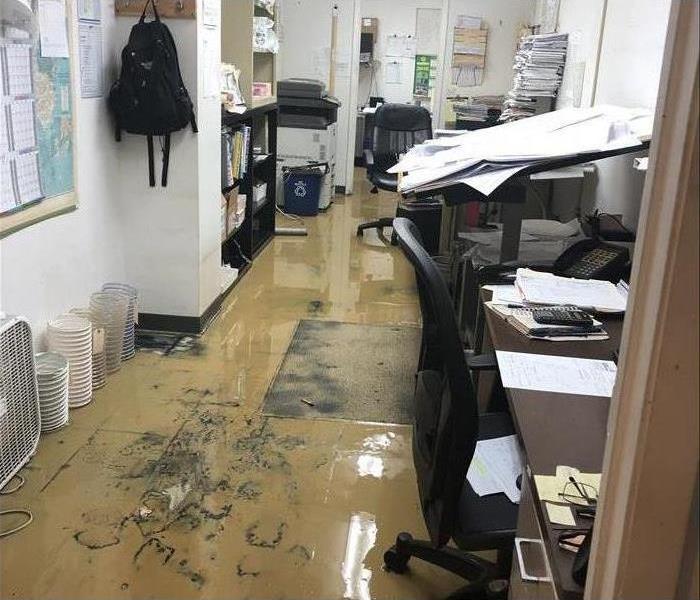 Flooded office in Reilly, OH
Flooded office in Reilly, OH
After a major storm, businesses in Reilly, OH, can’t afford extensive downtime. If there is flood damage or other extensive storm restoration that needs to be completed, businesses rely on their insurance company and a trusted storm damage restoration specialist to quickly get back to business as usual. A quick response by a company that understands the client’s needs and the insurance standards is key to making that happen.
Quick Response
When damage to a structure happens, especially if water is involved, time is of the essence. A fast emergency storm response helps reduce restoration costs and limit the damage from spreading. Counting on experts Faster to Any Size Disaster is essential to avoid the following potentially long-term or costly issues:
Mold: Within 24 hours of any type of water damage, mold can begin to grow. If not immediately addressed, it can spread to other areas of the business and result in extensive mold remediation and extra downtime.
Structural Damage: Less than an inch of water left sitting can begin to affect a structure. From the drywall to the beams and carpeting, it can lead to a compromised structure.
Salvageable Items: Taking immediate action after a storm can help protect vital elements of a business. Whether it is equipment, artwork, furniture, or personal belongings, they have the potential to be saved if action is taken. Letting the water absorb into them may mean irreversible damage and even more costs.
Smooth Process
Knowing that clients need storm restoration to happen now, streamlining the process for adjusters and insurance companies is essential. Communication is a vital component in making that happen. SERVPRO has a network of dedicated professionals and national accounts division dedicated to providing the best service possible. Along with an itemized loss inventory, electronic claims information makes it simple to get real-time information to assist insurers throughout the process, including detailed estimates, photos of loss, and digital paperwork.
Storm restoration isn’t something that can wait. Count a trusted professional to act fast, reduce costs, and get businesses back to “Like it never even happened.”
Clogged Pipe, Snake It Right
5/20/2020 (Permalink)
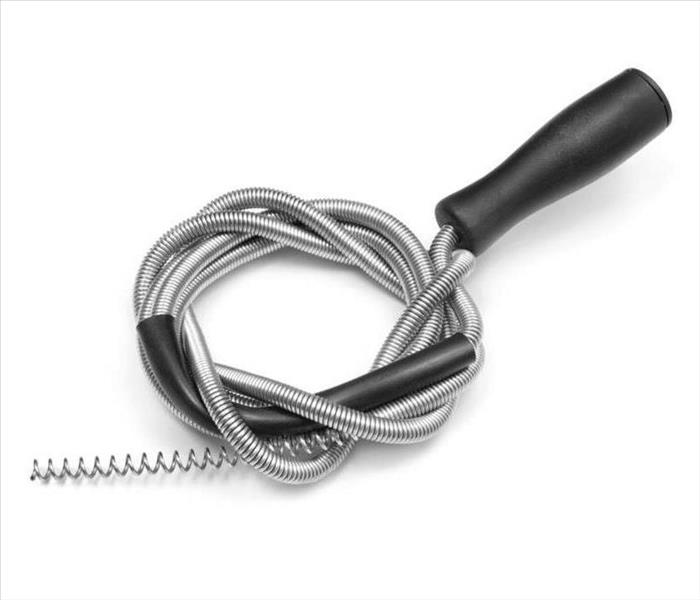 Knowing the best way to use a drain snake can help keep your home flood-free
Knowing the best way to use a drain snake can help keep your home flood-free
How To Snake Your Drains
In an ideal world, your pipes would never need snaking. Unfortunately, no matter how proactive you are about keeping hair and other particles out of the drains of your home in Layhigh, OH, there’s a good chance that, at some point, you’ll have to snake a clogged drain. Here are some tips to help with snaking your drains.
1. Exhaust Other Methods
There are a couple of things you’ll want to attempt before reaching for the snake. Especially if your pipes are draining slowly — as opposed to being entirely stopped — you can try using a plunger or cleaning out the trap. Sometimes the issue is as simple as a buildup of hair around the first couple inches of the drain.
2. Insert the Snake Until You Feel Resistance
Most of the time, the snake will slide easily into your pipes until it hits the clog. As you crank the snake into the pipe, be aware that you might feel some pressure as you meet the turns in the pipes. Once you pass each bend the snake should move easily until it hits the clogged section of pipe.
3. Push Through or Pull Back
If you hit the blockage and can feel the snake breaking up the foreign matter, push through until your snake starts sliding easily. If it feels like you’ve locked onto a solid object that can’t be broken, pull the snake back up and the clog should come with it.
4. Know When To Call for Help
Certain instances are hard to deal with on your own. If you think you might have a pipe break, you can call a local water cleanup and restoration service to assess the issue.
Keeping your pipes clean and free of obstructions can be difficult. If you find yourself with a clogged drain, knowing the best way to use a drain snake can help keep your home flood-free.
Avoid a Leak and Ditch Polybutylene Pipes
5/6/2020 (Permalink)
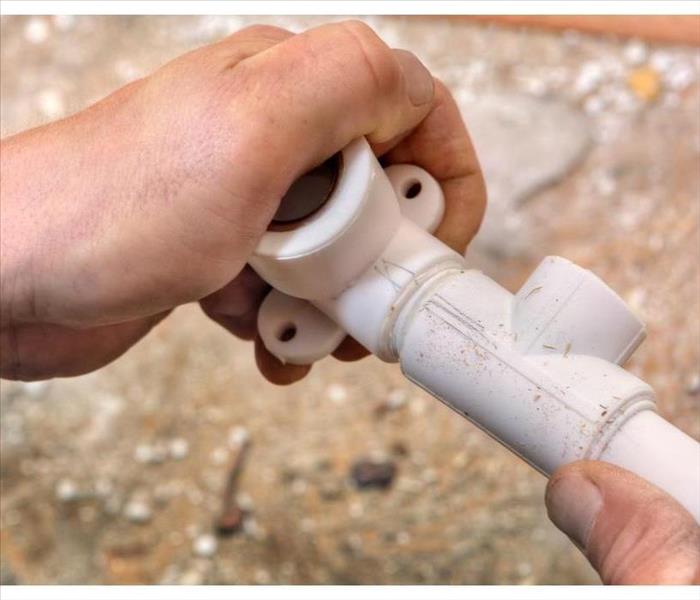 Checking if you have polybutylene pipes can better prepare you for upgrades that may be needed
Checking if you have polybutylene pipes can better prepare you for upgrades that may be needed
Leaking pipes can quickly lead to water damage in your Millville, OH, business. If left unchecked, it may require extensive cleanup by water damage and mold remediation restoration specialists. While any older pipe has the potential to eventually burst or leak, if your plumbing was installed between 1978 and 1995, there is a good chance they are polybutylene pipes, which generally only have a 10-to-15 year lifespan.
Determine Piping Type
During that time frame, this kind of piping became popular because it was cost-efficient, flexible, freeze-resistant, and easy to install. Over time, it became evident that the material wasn’t the best choice. The chemicals used in water treatment caused polybutylene pipes to get brittle, resulting in cracking and breaking. If your building still has them, they are long past due on being replaced. Unfortunately, repair is not an option for this type of plumbing. To determine if your pipes are made of this material, look for the letters PB on a pipe. Locations to check include:
- Around the water heater.
- In the basement entering through a wall.
- At the main shut-off valve or water meter.
- Behind sinks and toilets.
Time for Change
Although the thought of new plumbing may be overwhelming, the potential savings in water damage is worth the consideration. If a pipe bursts, it could lead to extensive downtime, which can be detrimental to a business. Contact a trusted plumbing professional to access the situation. If you are already dealing with leaks, it’s best to just modernize the system. A professional plumber will remove existing pipes and replace them with durable pipes and fittings that adhere to building codes. The replacement process usually takes two days, as well as another few days for the restoration of walls.
At the first signs of a leak, checking if you have polybutylene pipes can better prepare you for upgrades that may be needed. Although seemingly daunting, the long-term benefits are often worth the effort.
Should You Sue Your Landlord for Mold Problems?
5/6/2020 (Permalink)
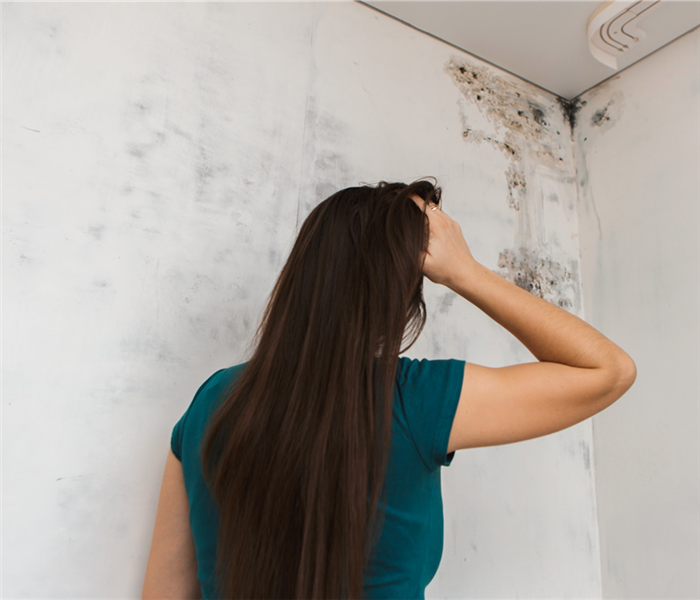 Black mold discovered in a Layhigh, OH building
Black mold discovered in a Layhigh, OH building
If you discover black mold in your building in Layhigh, OH, you will need to get it cleaned up as quickly as possible. Allowing it to sit can make the problem worse. Mold can be toxic, so try limiting your exposure while you wait for it to be removed. Sometimes mold can lurk in places that are not obvious, and your landlord may not be aware that there is a problem. Consequently, suing your landlord should not be your first choice. Instead, you could try informing them of the problem in writing. If your landlord is unresponsive to your request, or if you have experienced personal or property damage, you may need to file a lawsuit.
Why Would You File a Lawsuit?
If you are filing a claim for less than $10,000, you can usually file in small claims court. There are several common claims that are made for mold damage:
- Medical expenses
- Lost wages
- Loss of earning capacity
- Pain and suffering
- Damage to property
Mold can overtake porous materials, leading to damaged items. Mold remediation experts are able to restore many types of items, including documents and photographs.
What Are the Landlord's Responsibilities?
By law, a landlord is required to keep a building in a habitable condition. That means that they must provide a reasonably safe and healthy environment that is free from major defects. Since black mold carries the risk of toxicity, it is something the landlord must remedy when it is due to something faulty within the building. They would likely be responsible for fixing leaky plumbing or ventilation and cleaning the resulting mold. However, if mold has formed due to some mistake of your own, you may be responsible for the cleanup.
Black mold is a serious issue that needs immediate attention to avoid long-term consequences. By working with your landlord and a mold remediation company, you can quickly restore your property and return to normal.
What To Know About Damage You Can Expect from a Storm
4/23/2020 (Permalink)
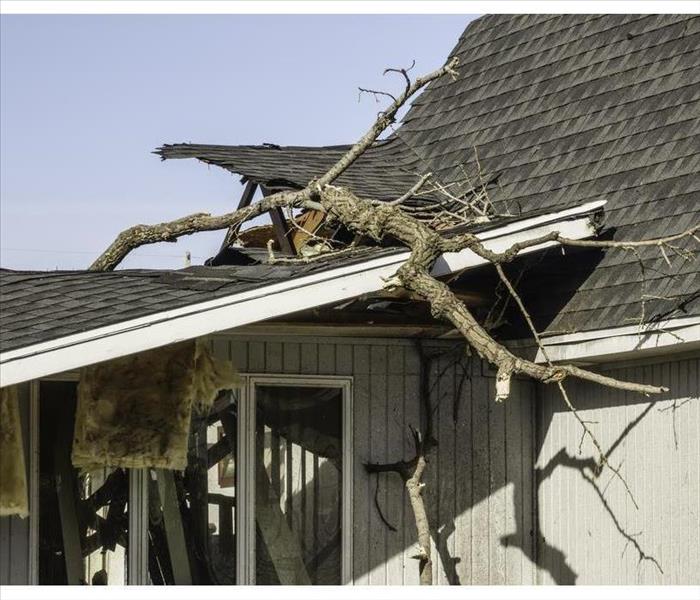 Roof damage in Ross, OH
Roof damage in Ross, OH
Here Are Three Things You Should Know
After a storm at your Ross, OH, home you may find that a storm restoration is needed. There are a few things you can expect to see in that damage that occurs after a storm from flooding that leads to a tear out, to wind that harms the roof. Here are three things you should know.
1. There May Be Multiple Damage Types
It’s important to understand that multiple types of damage can occur after a storm. High winds can lead to roof damage, or pick up debris and blow them into the building. Heavy rains can lead to flooding and water damage, while cold temperatures can cause problems with freezing pipes.
2. There May Be Multiple Damage Locations
Because of the variety of damage types, a storm can bring, it’s important to note that damage can also occur simultaneously in multiple locations. This means that due to flooding you may need a tear out, or removal of damaged wall material, while at the same time the roof has some loose shingles that need to be fixed. This is why many homeowners choose to work with a restoration service when your home sustains storm damage.
3. There May Be a Need For Professional help
If you find your home has sustained storm damage, then it’s recommended that you contact a local restoration service to help with cleanup and repairs. These professionals should be well versed in the different damages that can occur, where to look for them, and how to properly fix each one. With a little time and work they can have your home looking “Like it never even happened.”
There can be a number of damage types after a storm and each may need to be repaired in a different way. But whether you need a flood tear out, or a roof restoration a professional restoration service can help.
How Restoration Companies Estimate the Cost of Fire Damage
4/13/2020 (Permalink)
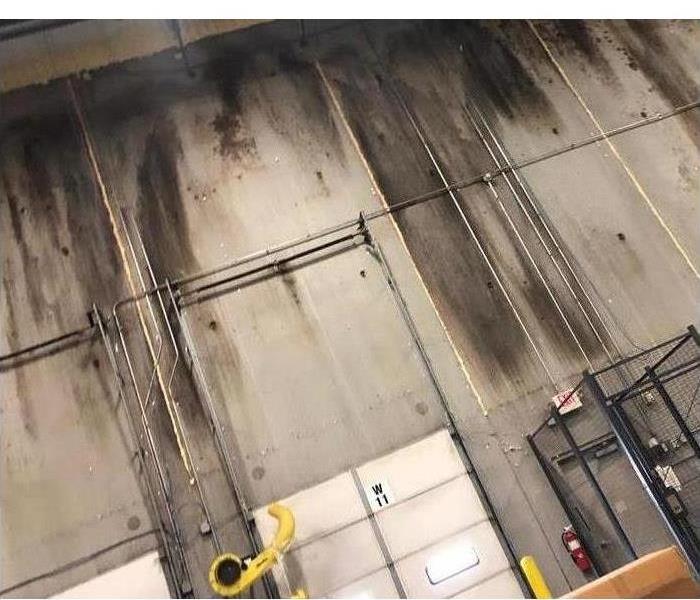 Fire in a Trenton, OH factory
Fire in a Trenton, OH factory
How Restoration Companies Estimate the Cost of Fire Damage
After a commercial fire, the damage can be overwhelming. It is sometimes hard to tell just how much the rebuild will cost.
That is why many restoration companies perform a fire damage assessment. They survey the building and calculate how much money you will need to spend on repairs. Each business will then give you an estimate that includes the cost of board-up services or live security. To keep out looters and prevent additional fire damage, the professionals may board up the exterior of your property. When that is not possible due to weather conditions, the restoration company will instead hire a guard to monitor the premises. Other costs included in estimates are:
- Debris removal
- Odor removal
- Moving services
- Storage
- Content cleaning
- Fire and water damage restoration
- Reconstruction
Picking the Right Company
Different restoration companies may give you a wide range of estimates. However, sometimes these estimates are generic and not indicative of the true cost of the project. In particular, some companies only provide the estimate for their services without specifying that they will need to hire subcontractors to perform some of the work. These subcontractors will add more costs to your bill. Ideally, you should pick a full-service restoration company that does not require subcontractors.
Filing Your Claim
Once the estimation is complete, you can file a claim with your insurance provider. Be sure to pick a restoration company that works with the insurer to ensure the project is completed as quickly as possible. Choose cleanup professionals who understand that a sense of urgency is required.
A commercial fire can cause lots of water and smoke damage to your Trenton, OH, business. The estimation process tells you exactly how much the restoration will cost. The company that offers you the lowest estimate is not necessarily the best choice. Instead, choose a full-service contractor that stays in constant contact with your insurance provider. This will save you money and make the rebuild more efficient.
How You Can You Protect Your Roof From Hail Damage
3/30/2020 (Permalink)
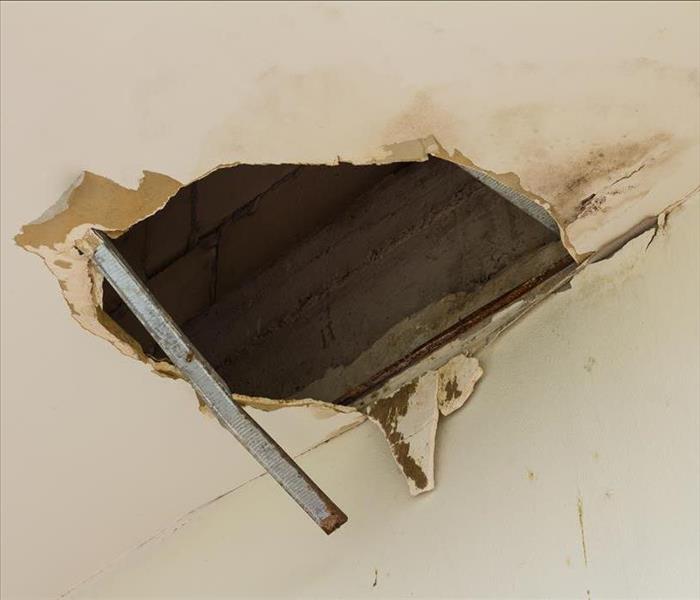 Damaged roof created hole on a ceiling
Damaged roof created hole on a ceiling
How You Can You Protect Your Roof From Hail Damage
When you hear about impending hail, your first instinct is probably to cover any windows. Yet hail can cause other types of storm damage, including:
- Cracked or missing shingles
- Wet insulation
- Water leaks
- Roof damage
This last problem is arguably the most dangerous. After all, holes in your roof can allow water to seep into your Hanover Township, OH, property. You could then be faced with severe flood damage.
That is why you should take steps to protect your roof from hail damage. Below are some tips for securing the top of your property and preventing the need for major storm cleanup.
Use Impact-Rated Equipment
Any skylights on your roof should meet ASTM pressure test standards or have a sufficient missile impact rating. You can also pick lights that are FM-approved. If you choose to install solar panels on your roof, they should also meet the International Electrotechnical Commission's impact-resistance standards.
Protect Your Equipment
Roof damage can also affect any HVAC units on top of your building. Keep them safe with a hail shield or guard.
Inspect Your Roof Regularly
A weaker roof is more likely to get damaged during a storm. You should thus regularly check the area for problems. The drainage system should be inspected at least two times a year. If your building has a roof hatch, you should look out for any loose screws. Any roof-mounted air conditioning units should be secured properly, as well. Fixing any issues in advance should prolong the life of your roof and increase the odds of it surviving a hailstorm.
Hail can destroy your shingles and create water leaks within your property. Hail can also cause major roof damage. You can attempt to mitigate the destruction by protecting your roof in advance. Still, some hailstorms are so powerful that they can harm even well-maintained roofs. If your building does suffer a water emergency due to a damaged roof, flood cleanup specialists can help.
Maintain Your Swamp Cooler to Prevent Mold Growth
3/23/2020 (Permalink)
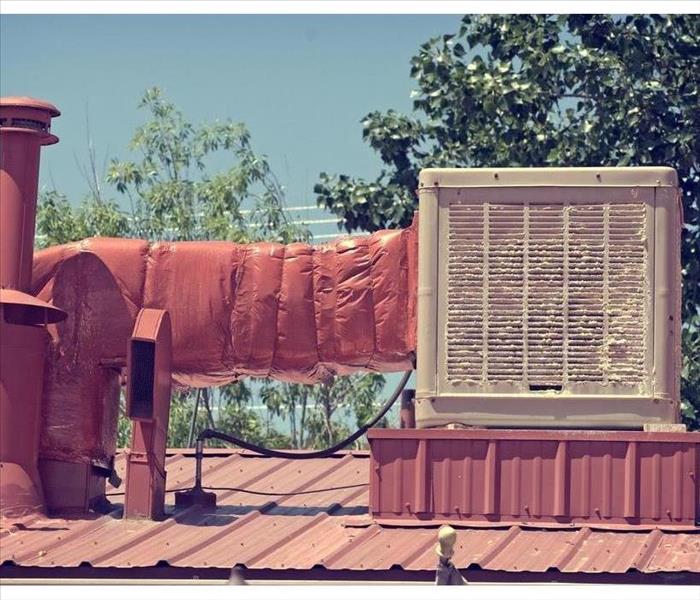 Give your leaking swamp cooler the attention needed
Give your leaking swamp cooler the attention needed
Your family depends on your swamp cooler to keep your home in Oxford, OH, from overheating during warm summer months. A leaking swamp cooler can be worrisome and may not operate as efficiently as it should. This is why regular maintenance on an ongoing basis is so important.
The Purpose of Swamp Cooler Maintenance
Maintenance is different than repair and for many reasons, upkeep is your first line of defense. Following are some of the main ways it can help prevent a leaking swamp cooler and keep your unit going.
- Annual system checks can alert you to any conditions that may have developed during periods of disuse, including rodent nesting or pest invasion
- Catch damage early to prevent major repairs
- Clean the unit free of dust and debris to keep air flowing freely and discourage mold from developing as spreading spores through the air
- Watch for and clean up leaks immediately to impede mold growth
- Maintenance can help the unit operate more quietly and efficiently
Maintenance Check List
The purpose of the cellulose cooling pad is to collect and evaporate residual moisture during operation. It needs to be replaced when saturated to keep black mold from growing. Encourage good ventilation by opening windows or doors, or even running ceiling fans to dehumidify the home’s interior. Otherwise you may sustain some mold damage on or around window casings.
Get Help if Needed
If you are unsure how, or unable to, perform the maintenance by yourself or deal with black mold cleanup, call in a professional mold remediation team in Oxford, OH, to take care of it for you. They can assess what the unit needs to have done and will have safe methods to remove any mold and control humidity.
Give your leaking swamp cooler the attention needed to ensure your family can be more comfortable with less worry. It will be worth the attention you give it.
Your Responsibilities as a Tenant
3/19/2020 (Permalink)
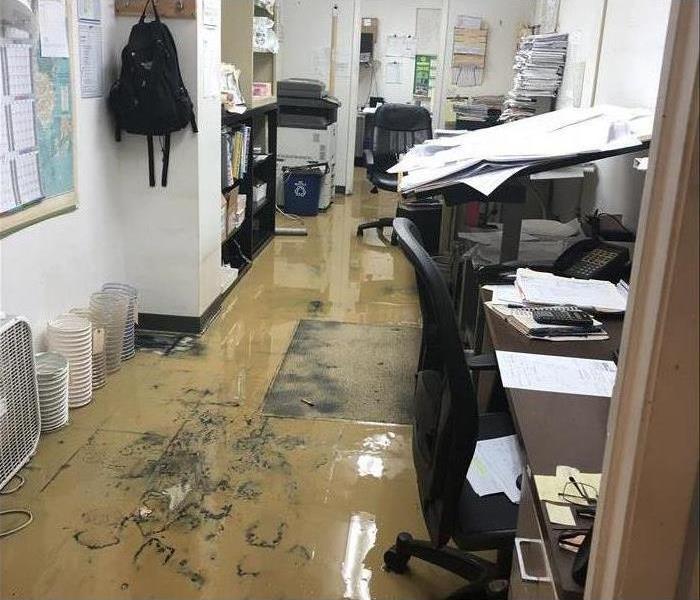 Office space flooded in Hamilton, OH
Office space flooded in Hamilton, OH
When you rent part of a commercial property for your business in Hamilton, OH, the bulk of the responsibility for the building lies with the property owner. You still need renter's insurance, though, to cover you in the event of a storm or other disaster. While repairing the building itself falls to the owner, your coverage compensates you for the losses for which you are responsible.
Equipment Loss
A storm that floods your business can destroy or damage anything in the building. Think about the equipment you need to run your company:
- Computers
- Copiers/printers
- Production machines
Flood restoration specialists can often save your machines, even after a flood, but these services cost money. Your landlord's insurance coverage does not extend to your equipment, so you will need a policy that protects you.
Document Recovery
Ideally, your important records are digitized and have cloud backup. You likely have a few hard copy files, though. When the building where your company is located floods, your files can get damaged. You need renter's insurance to cover the cost of drying them out and saving them, if possible.
Temporary Relocation
Sometimes it takes a few days or even weeks to fix the damage to the building you rent. Rather than shut down your business for that period of time, you may need a temporary place to set up shop. Your insurance coverage may be able to compensate you for the cost of relocating your business while the building is being repaired. Communicate frequently with your landlord to get updates on the progress, and keep your provider informed of the timeline of the restoration process.
Even if you don't own the building where your business operates, you still need insurance to cover costs related to flooding. Renter's insurance is a necessary expense for business owners who rent their office space. The relatively small monthly premium can save you a lot of money in the event of a disaster.
Proactive Cleaning for Your Commercial Space
3/17/2020 (Permalink)
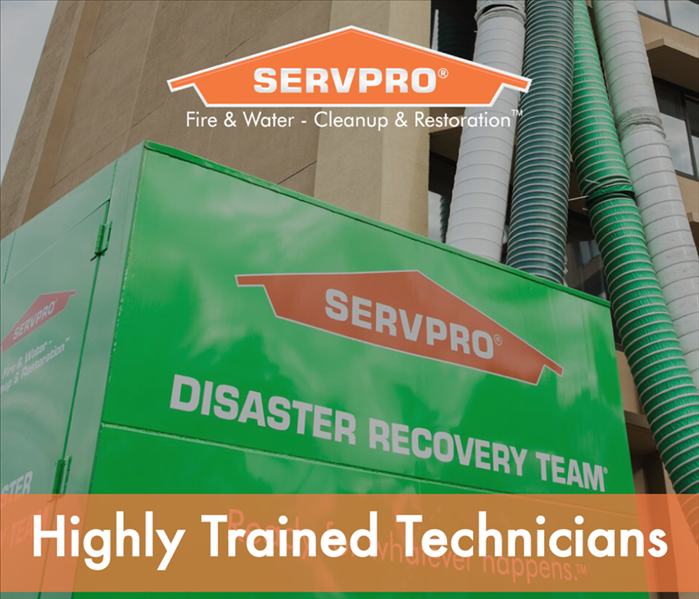 SERVPRO of West Hamilton/Oxford is here to help 24/7, 365!
SERVPRO of West Hamilton/Oxford is here to help 24/7, 365!
SERVPRO is Here to Help during this time of need
During this unprecedented time caused by the global pandemic of coronavirus, this is a reminder to our customers that we are specialists in cleaning services, and we adhere to the highest cleaning and sanitation standards.
Specialized Training
We are prepared to clean and disinfect your home or business, according to protocols set forth by the Centers for Disease Control and Prevention. We have years of experience in dealing with biological contaminants, and we will go beyond the scope of work that regular janitorial staff perform on a daily basis.
The CDC encourages cleaning of high-touch surfaces such as counters, tabletops, doorknobs, light switches, bathroom fixtures, toilets, phones, keyboards, tablets and tables. Other spaces mentioned in the CDC’s guidance for commercial spaces include:
- Kitchen/Food Areas
- Bathrooms
- Schools/Classrooms
- Offices
- Retail Spaces
- Water Fountains
- Shelving/Racks
- Sales Counters
- Carpets and Rugs
- Stair Handrails
- Elevator Cars
- Playground Equipment
- Fitness Equipment
Specialized Products
The CDC recommends usage of a labeled hospital-grade disinfectant with claims against similar pathogens to the coronavirus. Multiple products in the SERVPRO product line carry the EPA-approved emerging pathogens claims. While there is currently no product tested against this particular strain of the coronavirus, we are following all guidelines as provided by the CDC and local authorities.
Call Today for a Proactive Cleaning
If your home or business needs deep cleaning services, call the experts today – SERVPRO of West Hamilton/Oxford is here to help around the clock.
How To Know It Is Time To Change Your Supply Line
2/24/2020 (Permalink)
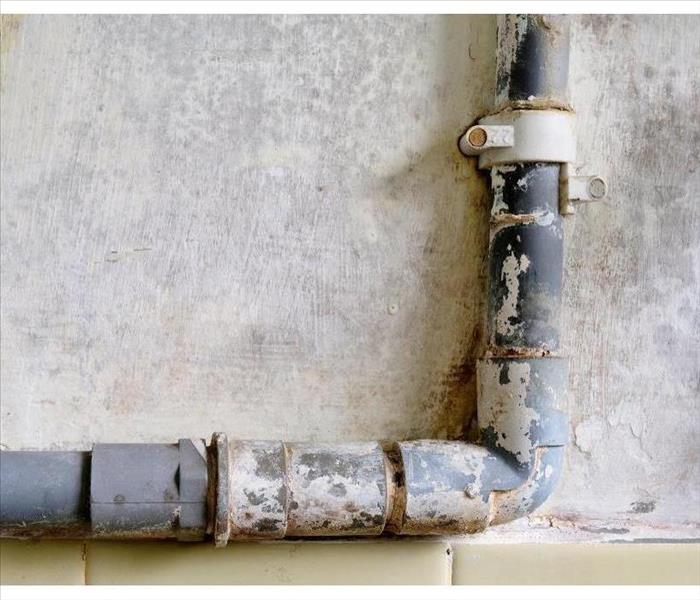 A supply line leak may mean you need to tighten its connection to a pipe
A supply line leak may mean you need to tighten its connection to a pipe
Three Signs To Decide It's Time To Change Your Supply Line
If you are noticing water issues in your home in Morgan Township, OH, they may be due to supply line damage. Checking your supply lines may not be at the top of your maintenance task list, but they can cause a lot of problems if they wear out. There are three signs you need to look for to decide if it's time to change your supply lines.
Visible Damage
You probably don't look behind your toilet very often. Failure to inspect your supply lines, however, can lead to a bathroom leak. During this inspection, it's important to look for visible signs of damage:
- Cracks
- Flaking
- Discoloration
If you see any of these things, you need to replace the supply line that carries water from the pipe to the toilet or appliance. Signs of supply line damage are the clearest indicator that it's time for a new one.
Frequent Leaks
Mystery leaks in your home can be a source of great frustration. According to water restoration experts, if you are seeing frequent leaks in the same area, it may be due to a faulty supply line. A supply line leak may mean you need to tighten its connection to the appliance or pipe. Otherwise, it may indicate that it's time to replace the line altogether.
Expired Warranty
There may be nothing wrong with your supply lines. If you have plastic lines, however, they do wear out eventually. While steel-braided lines should have a lifetime warranty, plastic lines need to be replaced every 5-8 years, depending on the specific manufacturer. If it has been a few years or if you don't know how old the supply lines are, it's a good idea to replace them with new ones. You may be able to stop leaks before they happen.
Supply line damage can lead to significant water loss in your home. With regular inspections and replacement of old lines, you can avoid leaks.
What To Know About Your Smoke Alarm
2/24/2020 (Permalink)
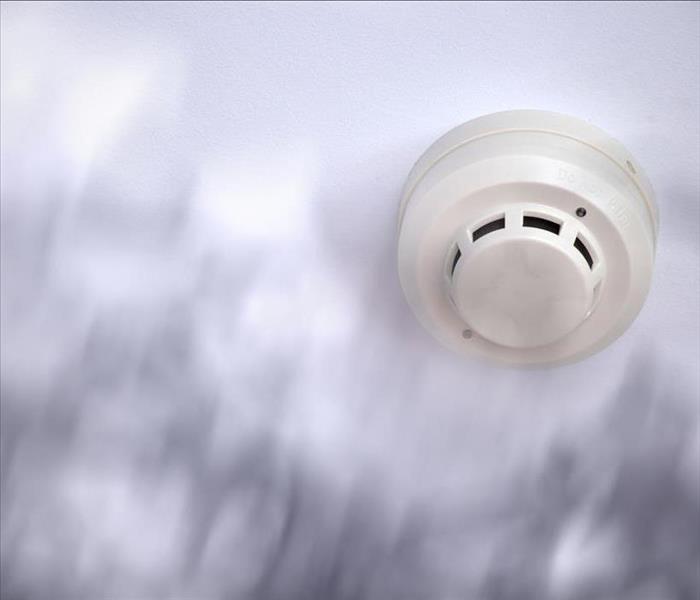 Regularly maintain your smoke alarm
Regularly maintain your smoke alarm
Three Things To Know About Installing Fire Alarms In Your Home
For a home in Hamilton, OH, having a smoke alarm installed is highly recommended by many fire damage restoration professionals to help protect your home. However, these units will need to be properly placed and maintained. Here are three things you should know about installing fire alarms in your home.
1. Alarm Maintenance
It’s important to properly maintain any alarms you may have in your home. Keep them clean and free of dust or cobwebs, and change the batteries at least once a year. It’s also important to test the unit according to the manufacturer's instructions. In many cases, this involves pressing the test button and listening for the appropriate alarm sound.
2. Alarm Lifespan
Another thing that should be noted about a smoke alarm is its operational lifespan. For most alarms, this lifespan is somewhere between eight and ten years. Units older than their recommended usage life should be replaced. If you need to know how long your alarm unit should remain functioning it’s best to consult the manufacturer's instructions.
3. Alarm Placement
When considering the placement of a smoke detector in your home many experts recommend having at least one on each floor. It’s also important to include an alarm in each bedroom as this can help protect your family should a fire occur while someone is asleep. Additionally, an alarm outside the bedrooms in a space such as a halfway can provide an additional measure of protection.
When installing a smoke alarm in your home it’s important to remember that the unit will need to be regularly maintained. It’s also a good idea to test the unit. Replace units over ten years old, and check the batteries in existing units at least once a year. You will also want to ensure that there is a minimum of one alarm per floor as well as one in each bedroom.
Fire Protection: What Renters Can Expect From Their Coverage
2/4/2020 (Permalink)
 Ask your insurance agent if you are covered
Ask your insurance agent if you are covered
Fire Protection: What Renters Can Expect From Their Coverage
What Renters Can Expect From Their Coverage
Many tenants buy renter’s insurance to cover the cost of replacing their personal belongings if they are damaged or destroyed by an accident in the building where they live. Your coverage, however, may pay for much more than just item replacement. It’s important to talk to your agent, so you know just how much you can expect your insurance company to pay if the place you are renting in Oxford, OH , catches fire.
Belongings
Part of the fire restoration process is determining which items can be cleaned and saved and which must be thrown away. Your insurance coverage should pay for:
- Assessment
- Cleaning costs
- Replacement costs
Make sure your policy states that it pays replacement cost rather than the actual cash value of your items. The purpose of insurance is to make you whole again, and replacing lost belongings is a good start.
Liability
If the fire was caused by your negligence, you might be liable for any damages you cause to other people or to the structure itself. Your renter’s insurance probably has a clause that protects you from legal costs. Your policy may cover damage to your neighbor’s belongings or the property itself, as well as cover medical bills of anyone injured in the fire if you bear some responsibility for its starting.
Shelter
Fire restoration experts may work quickly, but there are probably going to be some nights that you are unable to stay in your rented space. Finding a temporary place to live can be expensive. Your insurance policy is likely to cover this as well. You can include your shelter needs as part of the fallout of the fire damage to your home when you file your claim.
Your renter’s insurance does cover the loss of your belongings, but it can also cover other losses. Your insurance agent can help you build a solid policy that takes all potential expenses of the fire into consideration.
How to Reduce Business Interruption Costs Following a Disaster
1/30/2020 (Permalink)
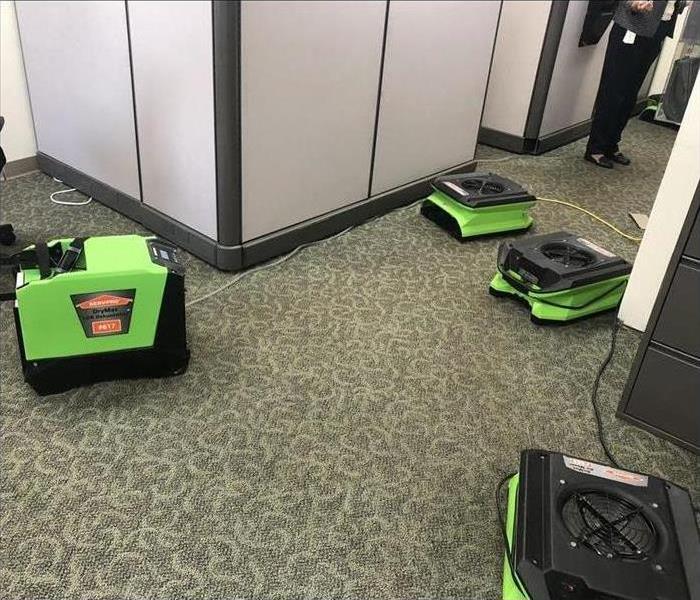 Water damage in Reilly, OH
Water damage in Reilly, OH
Whatever type of work you do, it's important to maintain a productive, efficient workplace. Keeping up with customer demand and providing the rights goods and services will help you stay ahead of the competition in Reilly, OH. A workplace emergency such as a fire, widespread mold growth or flooding can put your business at risk of shutting down for a time. You can't afford this, but there are ways to minimize the interruptions to your operations.
The Consequences of Workplace Disasters
Minor accidents can happen from time to time and not affect how your business functions. Something more serious such as flooding, however, can make it challenging to continue day-to-day work. Water problems or other worrisome issues can have the following effects:
- Damage equipment such as computers, servers and printers
- Ruin important documents
- Make the building unsuitable or unsafe for work
- Damage or destroy the structural integrity of the building
Act Quickly
The most important step to take after something such as large water damage in the office is to start the cleanup and restoration process immediately. As soon as you notice problems in your building, call your commercial property insurance agent and file a claim. Provide as many details as you can about the incident and the damage it has caused. You should then find an experienced disaster recovery company so these professionals can start getting your office back to working order.
How the Pros Will Reduce Your Business Interruption
The cleanup technicians may not be able to salvage everything in your office, but they can minimize the damage. This will translate into lower costs for you and a faster return to work. Whether water came into the facility from a broken pipe or sewer backup, crews will remove it, dry and sanitize the area, and replace or rebuild all materials.
Flooding can lead to devastating damage to your office. Fortunately, the more quickly you can get professional teams to your building, the less time you'll have to be in shutdown mode.
A Big Name for Certifications in the Restoration Business
1/21/2020 (Permalink)
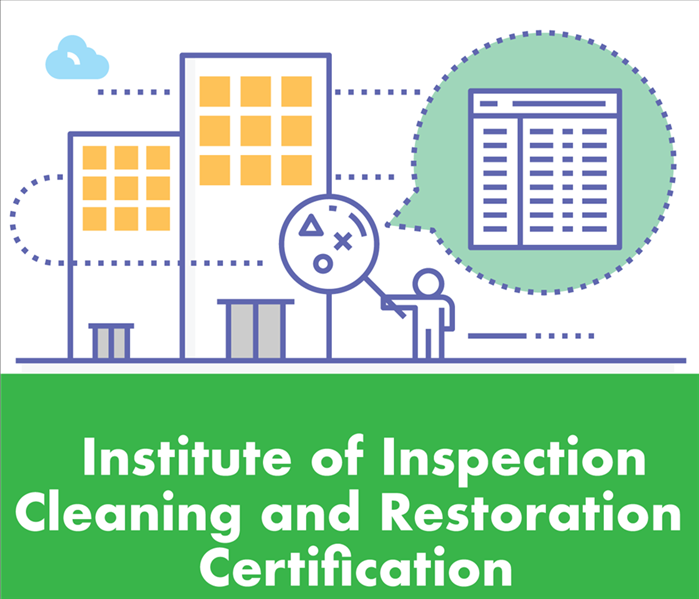 SERVPRO is certified with the IICRC for water, fire, and mold damage
SERVPRO is certified with the IICRC for water, fire, and mold damage
In just about every endeavor, someone needs to take a lead role, otherwise chaos can be the result. That's true for a disaster remediation team responding to flooding or a fire, and that's true for establishing cleanup standards in the restoration industry. The Institute of Inspection Cleaning and Restoration Certification sets the standards for the cleaning, inspection and restoration industries. The IICRC sets these standards to deliver the highest quality in cleanup efforts in Lemon Township, OH, and throughout the nation. SERVPRO franchises honor these standards and work closely with all groups looking to strengthen restoration efforts.
The Role of the IICRC
This non-profit organization is a certification source for the restoration industry. It was founded in 1972 and has since evolved into an organization with a global reach which has trained thousands of technicians. Its core mission is to advance standards and certifications in the restoration fields. Its values include the following:
- Respect for every person they encounter
- Responsibility for meeting obligations in a timely manner
- Integrity for standards of conduct
- Excellence in leadership and service
A mitigation certificate awarded by the organization is a respected badge for technicians in the field. It means they have reached a degree of knowledge and expertise in their area of work. SERVPRO franchises work closely with the organization and are considered partners in many efforts.
The Role of Training and Education
Training and education are key aspects of competence. Any new SERVPRO franchise receives extensive training in the areas of fire restoration, water restoration, carpeting and upholstery cleaning and mold remediation. Continual training is provided through e-training that includes modules, videos and testing. SERVPRO is also an approved IICRC training school for many areas of restoration as well as advanced concepts such as applied structural drying. They also provide courses that teach the emergency mitigation field. These courses can be taken by property managers, insurance agents and adjusters, real estate professionals and other interested parties.
Tips for Preventing Mold in Your Commercial Property
1/6/2020 (Permalink)
 A clogged vent will not rid your bathroom of moisture and you run the risk of having a mold problem.
A clogged vent will not rid your bathroom of moisture and you run the risk of having a mold problem.
Tips on Keeping Your Property as Dry as Possible
Mold damage can be a big problem for your business. If left unchecked, this fungus may force you to spend your business' hard-earned capital on black mold cleanup.
It is impossible to completely eliminate mold from your property. However, there are steps you can take to limit the buildup of this fungus.
Mold thrives in wet areas. Limiting water damage is thus the easiest way to curb mold growth. Below are some tips for keeping your property as dry as possible.
Know the Climate
Certain areas of the country are wetter than others. What works to curb moisture in the dry southern states may not be as successful in the wetter northeast. You should thus research and implement specific strategies for preventing water buildup in Layhigh, OH.
Address Spills Right Away
If your building suffers a flood due to a storm or a leaky pipe, don’t wait to take action. Remove any wet items right away and call water damage specialists who can quickly dry your belongings.
Reduce the Humidity
Humidity is another common source of moisture in a commercial building. You can check the humidity level of your property using a meter from a hardware store. Ideally, you should keep the humidity between 30 and 60 percent. You should also regularly survey the pipes, windows, and walls for condensation, as this is often a sign of excess humidity.
Ventilate
Wetter areas of the building, such as the bathroom and kitchen, must be ventilated properly. You can do this by installing a dehumidifier or air conditioner. Be sure to check and clean these appliances regularly to make sure they don’t produce any additional moisture. Otherwise, you may have to call in mold cleanup professionals.
Mold prevention is all about moisture control. By limiting the wet spots on your property and cleaning up any water damage immediately, you can limit your need for mold remediation services.
3 Tips for Keeping Your Business Safe During a Thunderstorm
1/4/2020 (Permalink)
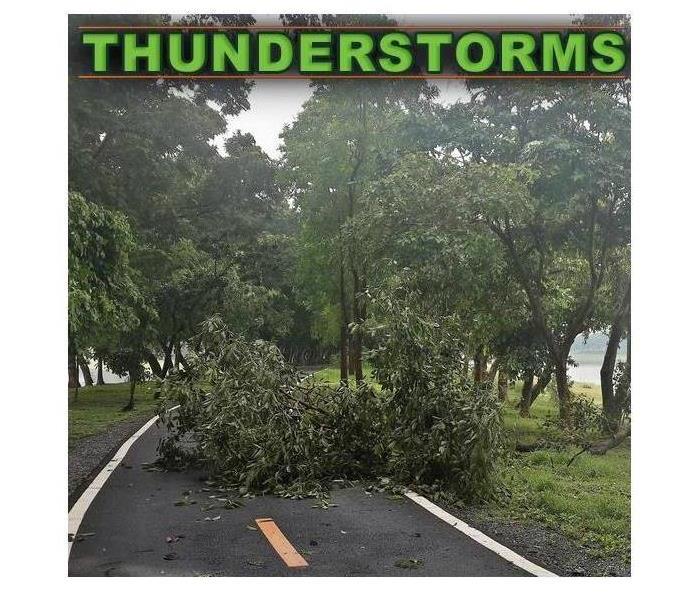 Safeguard your Trenton, OH organization from negative effects of a storm
Safeguard your Trenton, OH organization from negative effects of a storm
3 Tips for Keeping Your Business Safe During a Thunderstorm
Whether a steady rain storm or a full-fledged thunderstorm, severe weather is common in many parts of the world. If you own a business in an area that is susceptible to high winds and other storm damage, you may wish to have a strategy for keeping your business safe. Here are three fool-proof ways to protect your Trenton, OH, business from storm damage.
1. Take Some Pre-Storm Steps
When rain falls, winds blow and lightning strikes, it may be too late to effectively safeguard your organization form the negative effects of a storm. Instead, take some pre-storm steps to properly protect your business. Consider doing the following before storm clouds roll in:
- Trim tree limbs than hang over your building
- Ensure lightning rods are in place and functional
- Clear debris from sidewalks and emergency exits
- Secure damaged windows, doors and other vulnerable parts of your building
2. Keep Employees and Customers Safe
While most of protecting your business from a storm involves pre-storm planning, ensure employees and customers are safe during severe weather. Remember, even a common rain storm can include intense winds, hail and lightning. As such, when severe weather occurs, ask anyone inside your business to do the following:
- Move away from windows, doors and skylights
- Remain inside until weather passes
- Take care when walking or driving in flooded areas
3. Have a Safety Drill or Two
If you are a business owner, you are responsible for the safety of your employees. To be sure your workers are ready for inclement weather in Trenton, OH, hold periodic safety drills. These drills can help your employees form excellent storm-safety habits. If you aren’t sure how to conduct an effective drill, you can use a restoration service to get some ideas.
Protecting your company’s physical and personal assets during a rain storm or other severe weather is often a top priority. With a bit of planning, though, you can be certain your organization is ready.
Four Ways To Protect Your Business After a Fire
12/29/2019 (Permalink)
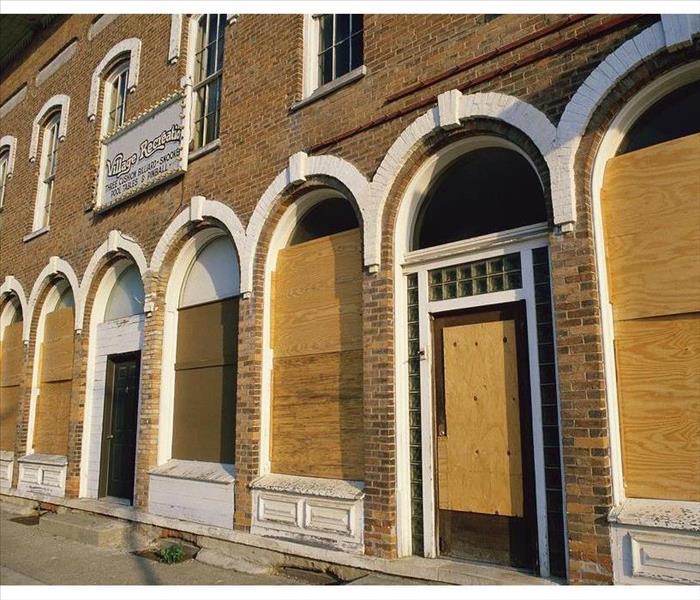 Board up the openings of your building to prevent further damage
Board up the openings of your building to prevent further damage
4 Ways to Secure Your Property After a Business Fire
A fire can leave your Millville, OH, commercial property vulnerable to bad weather, criminals and wildlife. Fortunately, a security fence and other safety measures can protect your business from secondary damage. Additionally, insurance companies want to know that you took adequate precautions to prevent further harm to the property. If they discover you were negligent, they may deny your claim on the secondary damage. The following are four ways you can secure your property after a business fire:
Cover the roof. Depending on how severe the fire was, the emergency workers may have cut holes in the roof for fire and smoke to escape. However, these openings can also let in bad weather and industrious animals. A tarpaulin is an easy and inexpensive covering that you can quickly install over the roof until you can make permanent repairs.
Board up windows and doors. The fire and firefighting efforts may have also damaged your windows and doors. You will want to board up these openings to prevent further damage. Plywood is fairly inexpensive and easy to install.
Install a security fence. Although you have already secured the building itself, it is a good idea to put up a fence to further deter would-be looters. The fence will also prevent people from accidentally wandering onto the property and getting injured. Even if the person was on the property without permission, he or she can still file a lawsuit against your company if they are injured. A fence can protect you from litigation.
Keep an eye on the property. Check in with the property frequently to make sure new problems have not arisen and to discourage trespassers. For some properties, you may even decide to hire a security guard until the restoration is complete.
Although securing your building with tarps, plywood and a security fence can prevent many cases of secondary damage, you may still need help cleaning up the primary damage. Fortunately, an experienced restoration company can help you with all stages of the fire cleanup process.
4 Guidelines for Safe Fire Alarm Usage
12/23/2019 (Permalink)
 Test your smoke alarm monthly
Test your smoke alarm monthly
4 Guidelines for Safe Fire Alarm Usage
Fire safety is something children learn from a young age. Don't play with fire, stop drop and roll, and other common slogans may ring a bell. But for many homeowners, home fire safety comes with some glaring question marks. Do you know how to protect your Ross, OH, residence using best fire alarm practices? Whether you own a home or rent an apartment, proper installation, maintenance and use of your fire alert system can make a life-saving difference. The following four guidelines should be followed to keep your home and family safe from fire danger.
1. Install the Correct Number of Alarms
Whether you live in a studio apartment or a large estate, the National Fire Protection Association provides guidelines for installing smoke detectors in any sized dwelling. No matter the square footage, it is recommended that homes should have smoke alarms in each of the following places:
- Inside each bedroom
- Directly outside of sleeping areas
- Minimum of one on each level, including upstairs and downstairs
If your home is lacking the proper amount of detectors, look for easy-to-install models that can be adhered directly to the ceiling.
2. Replace the Batteries Regularly
Aside from avoiding those ear-piercing chips that come in the middle of the night, regular battery replacement is essential for safe operation of your fire alarm system. Battery replacement should be done one to two times each year to ensure your system is prepared for an incident involving smoke damage.
3. Replace Home Fire Alarms According to Manufacturer Directions
On average, your home fire detector has a life span of 8-10 years. Residents living in older structures should not overlook the fact that their alarms may be past the manufacturer guidelines for safety. If it's time to replace your alarms, don't fear. Most models can be found in the $10-$20 range making them very affordable.
4. Test Alarm Monthly
Finally, monthly testing of your fire alarm will help ensure that you have done your part to prepare for a possible house fire. Don't be caught unaware when your home and family are left with the aftermath of fire damage in Ross, OH.
4 Things You Need To Know About Flooding, Rental Properties, and Insurance
12/18/2019 (Permalink)
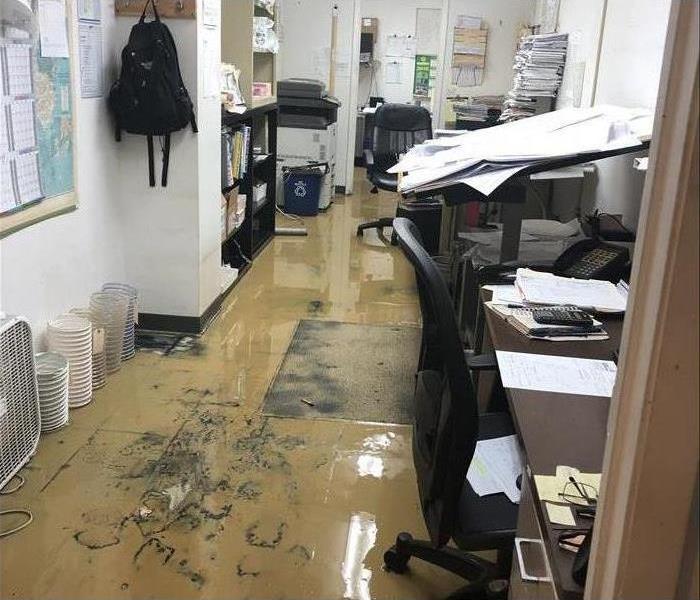 Office flooded in Trenton, OH
Office flooded in Trenton, OH
4 Things You Need To Know About Flooding, Rental Properties, and Insurance
When flood damage affects your building, there are sure to be some difficult emotions, whether you're a tenant or the property owner. It can be especially rough if you're not sure who should be responsible for the damages. Unfortunately, there isn't much time to determine who should pay because damages get worse rapidly as water sits. Renter's insurance may include flood coverage, but only if the separate policy has been added. Here's what else you need to know:
It is the renter's responsibility to get insurance.
Anyone renting space in a commercial building or living as a tenant in a rental space should have renter's insurance. Sometimes, the owner of the property requires insurance coverage before allowing the renter to move it, but it is not the owner's responsibility to make sure tenants are properly covered.
Landlords are responsible for structural elements of the building.
This responsibility includes elements such as flooring, window treatments, and appliances. Basically, anything that is included in the rent is part of the landlord's responsibility. When storm damage has made it impossible for the building to be habitable, the landlord is responsible for repairs to make the space livable.
Landlords are responsible to ensure proper maintenance.
Plumbing and electricity are included in this responsibility. If a toilet, tub, or sink isn't draining properly or is backed up, the landlord may be charged with negligence when items are damaged. However, tenants must prove negligence. This means maintaining a detailed record of any mishaps and how often the landlord was contacted for corrections.
Insurance for renters doesn't cover everything.
Tenants can expect insurance policies to cover the replacement of personal items, temporary relocation costs, and some daily living expenses. However, the policy doesn't cover everything involved in flood damage. It's important to carefully review all policy paperwork to fully understand what's included.
After flood damage occurs in a rental building in Trenton, OH, water cleanup experts are sure to be called for repairs. When all is said and done, however, the cost for those cleanup efforts may be shared by the property owners and the renters. The right commercial property and renter's insurance policies are essential for a full recovery.
Supply Line Maintenance Tips
12/10/2019 (Permalink)
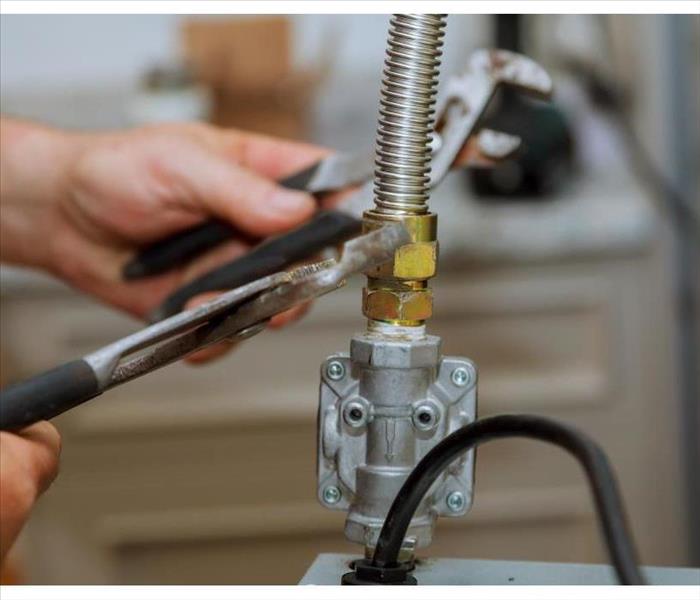 It's important to know the kind of supply line you have
It's important to know the kind of supply line you have
Supply Line Maintenance Tips
When you think of issues that could cause flooding in your home in Hanover Township, OH, supply line damage is probably not at the top of your list. More often than not, flooding is caused by a malfunctioning appliance or sewer backup. A broken supply line, however, can also cause a lot of water damage in a short amount of time. Making sure all your supply lines stay in good working order can help you avoid some leaks.
How To Spot Damage
Inspecting your supply lines on a regular basis can help you head a potential bathroom leak off at the pass. There are several issues to watch for:
- Loose bolts connecting line to wall or appliance
- Visible wear and tear on supply line
- Moisture on the floor near the water supply
If you notice any of these problems, you may need to fix the supply line damage or replace it altogether. Call water restoration specialists if you have an ongoing leak, because you may have water damage even if you can't see it.
When To Replace Lines
Even if you don't see any visible damage, you can still have a supply line leak if they get old and wear out. Supply lines are either made of plastic or steel, and it's important to know the kind of supply lines you have. A plastic supply line needs to be replaced every 5-6 years, even if you don't see any visible damage. A steel braided line, however, often comes with a lifetime warranty. If you upgrade to a new appliance, it's a good idea to replace the supply line as well to ensure proper fit and function.
Every part of your plumbing system must be kept in good working order to avoid potentially costly water damage repairs. Checking for supply line damage as part of your regular maintenance schedule and replacing old or damaged lines are good ways to prevent leaks.
How To Prevent Mold Growth in a Bathroom Without a Fan
11/28/2019 (Permalink)
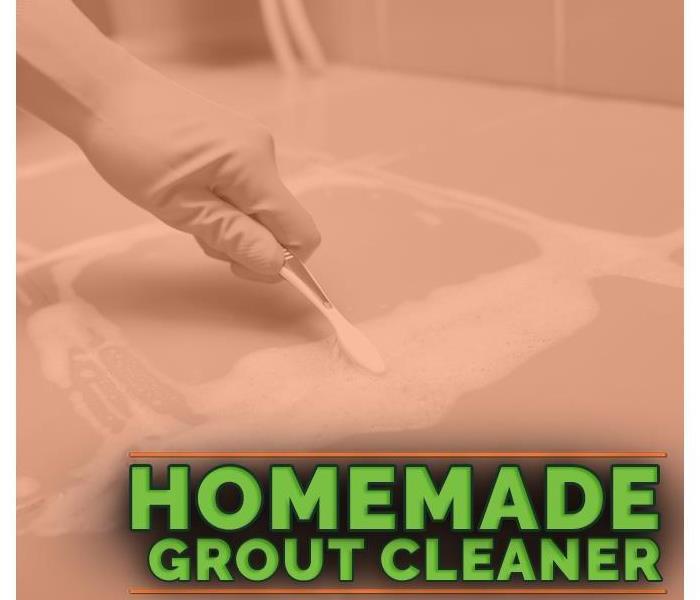 If your bathroom has tile, it’s important to grout it periodically
If your bathroom has tile, it’s important to grout it periodically
Follow These Tips to Prevent Bathroom Mildew
If you have an older bathroom in your Oxford, OH, home, it may not contain a fan or vent. A lack of proper ventilation can unfortunately cause mold to appear in your bathroom if you aren’t careful. However, by remembering to take proper care of your bathroom during and after a shower, you can keep the room sufficiently dry. Follow these tips to prevent bathroom mildew from invading your living space.
Open the Door and Window
Because showering tends to create the most moisture in a bathroom, it’s important to be vigilant about this before you begin your cleansing routine. Always keep the bathroom door and window open while you shower to reduce the amount of condensation in the room. By minimizing as much steam as possible, you can stop paint from peeling and keep mildew at bay.
Use a Dehumidifier
If you don’t have a fan in your bathroom, it’s a good idea to spring for a dehumidifier. This device can help keep the room dry enough to discourage the growth of bathroom mildew. When using a dehumidifier, be sure to do the following:
- Turn it on right before showering
- Leave it on for at least twenty minutes after your shower
- Empty it every couple of days
These steps can ensure that your bathroom dries completely after you take a shower. Emptying out the device on a regular basis also helps it solve your humidity problem efficiently.
Grout the Tile
If your bathroom has tile, it’s important to grout it periodically. Grouting helps to prevent mold from entering the cracks and crevices of your bathroom tile. In addition to grouting, make sure you inspect your tile every now and then to confirm that it’s in good shape.
Bathroom mildew may appear in your home at any time. If you encounter signs of mold damage, call mold remediation experts as soon as possible.
What You Should Know About Smoke Detectors
11/23/2019 (Permalink)
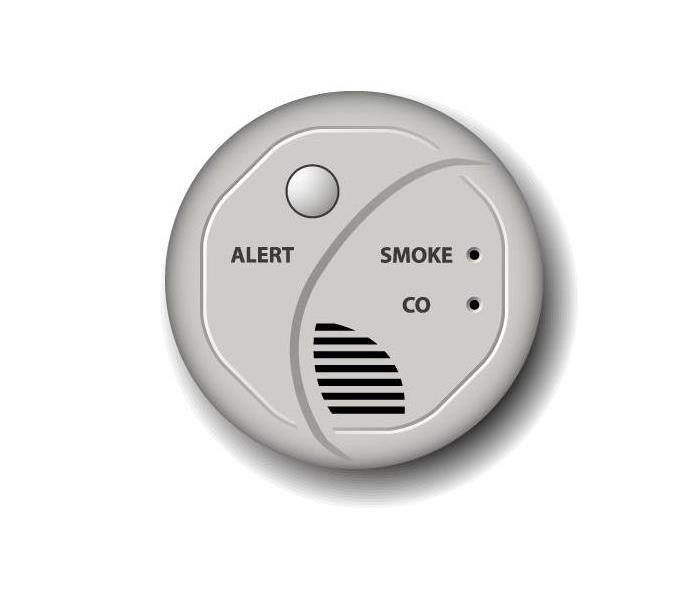 If you have a dual alarm, then you have an alarm that uses both types of detection
If you have a dual alarm, then you have an alarm that uses both types of detection
Things To Keep In Mind About Smoke Alarms
If you have ever had the unfortunate experience of having a house fire in Hamilton, OH, then you likely already know how devastating it can be. It can cause a great deal of damage, and it can even cause a home to be a total loss. While a fire damage repair specialist can help with the fire damage, it is not something no one wants to experience. In case of another house fire, your safety should be your biggest concern. One of the best things you can do to ensure the safety of you and your family is to have a working smoke alarm. Here are some things to keep in mind about smoke alarms.
Where to Place Them
Unless you live in a very small home, you will likely need more than one smoke alarm. It is recommended that you put one:
- In every bedroom
- On every level
- In each living area
This means that most homes will require several alarms.
Different Types
There are different types of smoke alarms. A smoke detector that uses ionization will be better at detecting a fire that spreads quickly, and a photosensitive detector will likely be better at a smoldering fire, or one that can be difficult to detect at first. If you have a dual alarm, then you have an alarm that uses both types of detection.
How Often to Test It
You want to test your smoke detector once a month, if not more frequently. Replace the batteries immediately if the alarm fails the test. Be sure to replace the batteries regularly. Some newer smoke alarms have batteries that can last up to ten years, but older alarms may require annual battery replacement.
These things can help you keep your family safe by ensuring you have a working smoke alarm everywhere you need to. Remember to test them regularly to ensure they are working properly, and replace any alarms or batteries that are no longer working.
3 Things To Do if Your Home Has Been Damaged in a Storm
11/13/2019 (Permalink)
 Use your home's breaker to turn the power off to the whole building
Use your home's breaker to turn the power off to the whole building
What To Do if Your Home Has Been Affected By Storm
If you have had severe weather in Morgan Township, OH, then you may be dealing with water or flood damage in your home. This can be a distressing situation and, if you are feeling overwhelmed, it can be difficult to figure out what you should do next. The following storm tips can help you determine what to do if your home has been affected.
1. Turn Off Your Power
Perhaps one of the most important storm tips to remember is to cut off the power right away if there is flooding in your home. It is unsafe to use electricity in this situation. You might be tempted to simply turn off the lights and unplug your devices, but this can be dangerous since doing so can produce a spark. You should use your home’s breaker to turn the power off to the whole building instead.
2. Contact Your Insurance Company
Any damage that has been done to your home should be reported to your insurance company as soon as possible. The claims process can be lengthy, and your claim can be denied if you wait too long, so it is best to begin sooner rather than later. Make sure to read over your policy to make sure you understand what to expect.
3. Start Cleaning Up
While you wait for your insurance adjuster to inspect the house, you can begin cleaning up the storm damage. If you don’t, it can contribute to mold growth and other problems. This can increase the amount of time and money it takes to make repairs. In some cases, your claim can be denied if mitigation is not done. You may want to take pictures and make a list of damaged areas while you do this since the adjuster can use this information.
Keeping these storm tips in mind can help you better navigate this stressful situation. If your home has been damaged, a cleanup and restoration company can make repairs and salvage many affected belongings. Once they’ve finished, you may not be able to tell your home was damaged at all.
4 Ways Hail Could Damage Your Business
10/24/2019 (Permalink)
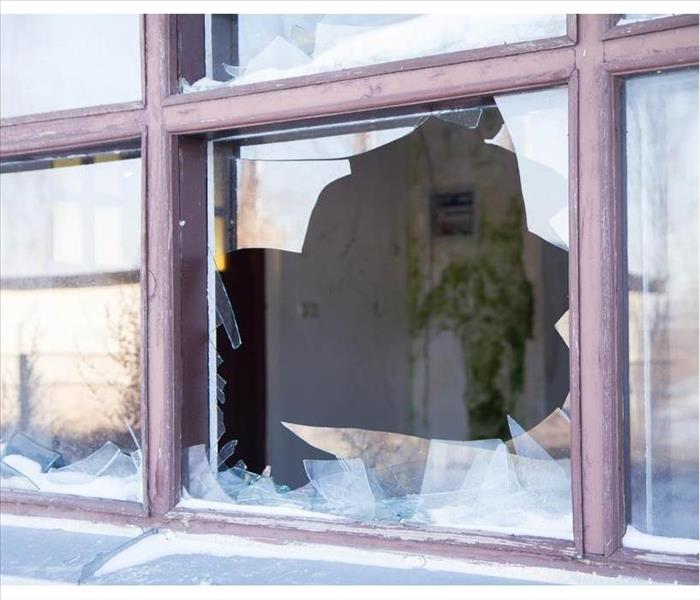 A single broken pane of glass exposes the interior of your business to extensive water damages
A single broken pane of glass exposes the interior of your business to extensive water damages
4 Ways Hail Could Damage Your Business
Hail is more common in some areas of the country than in others, but when hail does hit Reilly, OH, the damage to business property can be serious. Depending on the size of the chunks of ice the type of harm could range from minor roof damage to long-lasting effects inside your buildings.
Damage to the Roof
Of course, the roof is often the first part of the property to be affected by hail damage. Roof damage may include minor dents or dings, or it could include broken and missing shingles. A storm damage cleanup and restoration professional is the best person to identify the extent of roof damage. You don't want to leave your business at risk because you overlooked a spot where shingles are missing.
Broken Windows
A single broken pane of glass exposes the interior of your business to extensive water damages. Hailstones often reach speeds as much as 100 miles an hour. When those hurtling ice stones make contact with your inventory or your equipment, the chance of property damage naturally increases. Of course, there's also the chance that your personnel or customers could be hit by hail, as well.
Property Attached to Your Building
If you have signage, air conditioning units, or any other belongings attached to or set up near your building, large pieces of hail could naturally harm the property. If you have the chance, it's best to move these items inside before the storm gets very bad.
Water Leaks
One of the worst problems caused by hail damage is the long-lasting, hard to recognize type. If water gets into your building, it could soak into the insulation or support the growth of mold in the attic. After the storm passes, you may want to conduct an inspection of your own. If you suspect any damage, contact professionals to complete repairs before extensive property or roof damage takes place.
Methods for Preserving Personal Belongings After a Fire
10/22/2019 (Permalink)
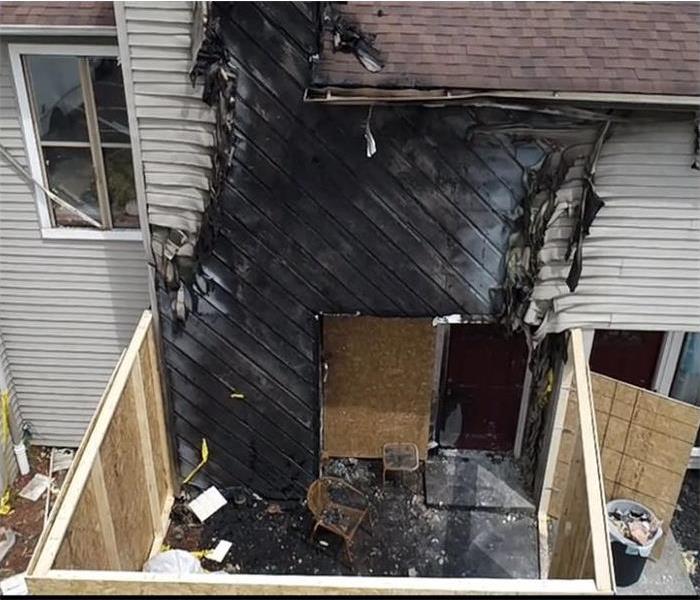 Fire Damaged an Apartment Building in Oxford, OH.
Fire Damaged an Apartment Building in Oxford, OH.
In-home fires can be devastating, and not only can they cause heat damage to a home’s structural integrity, but the smoke and soot that results from a fire can easily affect personal belongings in the home’s interior as well. While unfortunately not everything can be saved from the aftermath of a fire, these methods are available for content cleaning after a fire has occurred:
- Dry-cleaning can be attempted before wet-cleaning to eliminate light residue. While there are many ways to clean damaged items, this is the preferred method for smoke or soot-damaged clothing.
- Foam cleaning should be considered for fabrics that are not colorfast or those that may shrink if wet-cleaned.
- Immersion Cleaning requires dipping contents into a cleaning agent.
- Wet-cleaning can then be used for heavier or moderate residue removal.
An in-home fire is something no one wants to contend with. However, items can be saved afterward if proper content cleaning methods are employed.
First Check Your Bathtub and Shower for Leaks
10/16/2019 (Permalink)
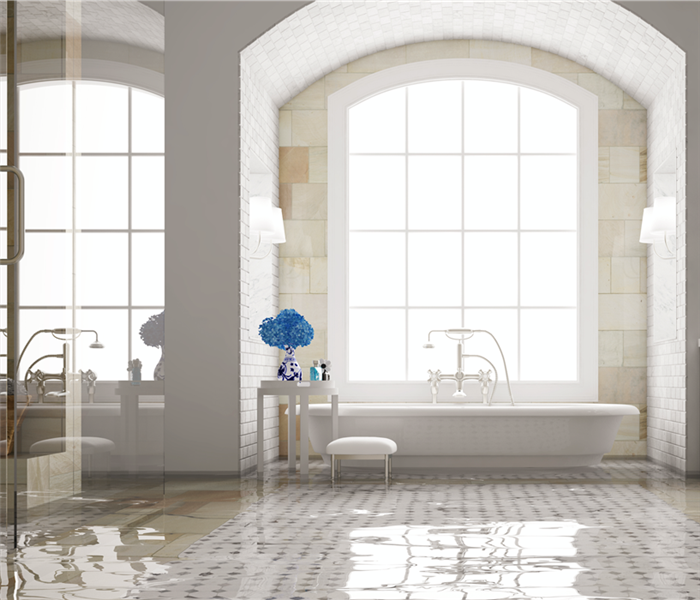 Water damage on bathroom due to leaking bathtub in Lemon Township, OH
Water damage on bathroom due to leaking bathtub in Lemon Township, OH
First Check Your Bathtub and Shower for Leaks
It’s discouraging to see a water-stained ceiling in your home. Realizing that there is a bathroom above that stain makes it worse. Fixing the problem is simple. Finding it is the challenge. Possible sources are a:
- Bathtub leak;
- Toilet leak;
- Supply line leak; or
- Drain leak.
Use the Process of Elimination to Find the Leak
Finding the source of the leak may eventually require tearing out walls or ceilings. Most homeowners prefer not to go that route until there is no other choice. Evaluating the tub and shower allows you to test for a leak without performing any demolition. The simplicity of this approach makes it an excellent first step. This procedure can help identify or exclude them as the sources of the problem.
- Give the ceiling a chance to dry. If possible, discontinue using the shower or tub. If the ceiling doesn’t dry, the problem is unlikely to be a shower or bathtub leak.
- Cover the drain with tape. Only block the holes to the drain. Leave the area where the drain meets the tub or shower open.
- Open the valves. Fill the tub with water to a depth of a couple of inches. Fill the shower base to a depth of an inch but not to the point of overflowing.
- Check the ceiling for added moisture. An increase in the amount of moisture would indicate a leaking shower or tub.
Determine the Cause of the Leak
For unbroken tubs and shower bases, the most likely place for a leak is the point where the metal drain meets the tub or shower. For a tile shower, the problem may be a shower pan leak. Old or poorly installed shower pans can be the source of trouble.
A shower or bathtub leak can cause substantial water damage in your home. It is crucial to remove the moisture and repair the damage before mold becomes a problem. Fortunately, there are local water damage remediation specialists located in the Lemon Township, OH, area. When they finish the cleanup, it will be “Like it never even happened.”
3 Things to Remember About Fire Alarms
10/10/2019 (Permalink)
 Make sure to test your alarm at least once a month
Make sure to test your alarm at least once a month
3 Things to Remember About Fire Alarms
A smoke alarm is an essential part of every building, but you likely don’t give yours a lot of thought. These little devices can help you stay safe and can alert you in time to prevent severe fire damage from occurring in your home. The following are a few pieces of information about them that can be helpful for homeowners in Layhigh, OH.
1. There Are Several Types of Alarms You Can Purchase
When it comes to which fire alarm to put in your home, you have a variety of options. One feature that can vary between models is how the alarm is powered. Traditionally, smoke alarms have used 9-volt alkaline batteries that need to be replaced at least once a year. However, newer alarms sometimes use a lithium battery that lasts for the life of the device. There are even some types that connect to your home’s electric system. You can also choose between photoelectric and ionization alarms which detect different types of fires.
2. The Number of Alarms You Need Depends on the Size of Your Home
Not every house needs the same number of alarms. Generally, you need at least one fire alarm on each floor. You should also have one inside each bedroom and outside of each sleeping area so that you will wake up more quickly if an emergency occurs.
3. Alarms Should Be Tested Regularly
Because your fire alarm is an extremely important device, you should make sure that it is working properly at all times. Make sure to test your alarm at least once a month. You should also change the batteries once or twice a year if your smoke detector uses replaceable batteries. The device itself will need to be replaced at least every ten years.
While your alarm can help give you time to prevent a fire from getting bigger or allow you to get out of the house safely, it cannot keep all damage from happening. If you have fire or smoke damage in your home, a cleanup and restoration service can remove it and perform any necessary repairs to the building.
4 Common Causes of Commercial Water Damage
9/27/2019 (Permalink)
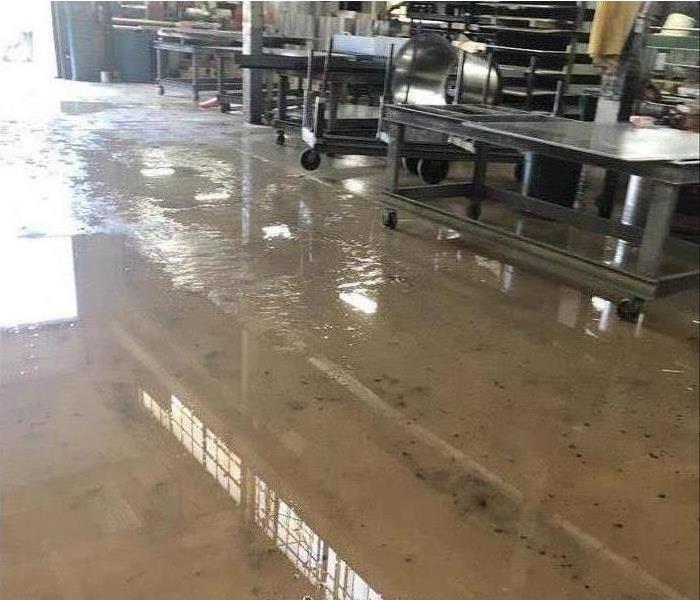 Commercial water damage in Millville, OH
Commercial water damage in Millville, OH
Be Aware of The Most Common Causes of Commercial Water Damage
No business owner hopes to receive the news that their building has experienced water loss due to damaged pipes or some other cause. When dealing with flooding and water damage in your business, the stakes are often high as you may have to close your business in Millville, OH, while a water restoration company works on your building. The best way to avoid any potential water damage issues is by being aware of the most common causes of commercial water damage and taking preventative action.
Problems With Pipes and Plumbing
From leaking pipes to unexpected bursts, plumbing systems can cause extensive water damage if a problem goes undetected. Common reasons for damaged pipes include improper installation, sudden drops in temperature, corrosion, or increased water pressure.
Leaking Roof
Any time your business is hit by a storm, rain, or snow, you should always check your roof for any leaks. If not consistently maintained or damaged by heavy wind, water can make its way into your building’s roof and even leak through the ceiling.
Fire Sprinkler Malfunction
While very helpful in preventing fire damage, fire sprinklers can become an issue if they malfunction and go off when no fire is present. For this reason, it is important to have sprinkler systems inspected and updated at least once a year.
Backed Up Toilet or Sewer System
Backed up sewer systems can be a very big issue, especially if sewage is present and spills into the area. While addressing leaks right away and keeping non-biodegradable items out of toilets can help prevent this unfortunate situation, if an overflow does happen you will need to contact a sewer company right away.
There are many other causes of water damage that can affect your business, but these are some of the most common. While some situations might be unavoidable, following the tips in this guide can help you prevent damaged pipes and other catastrophes.
Keeping Mold Out of the Bathroom
9/19/2019 (Permalink)
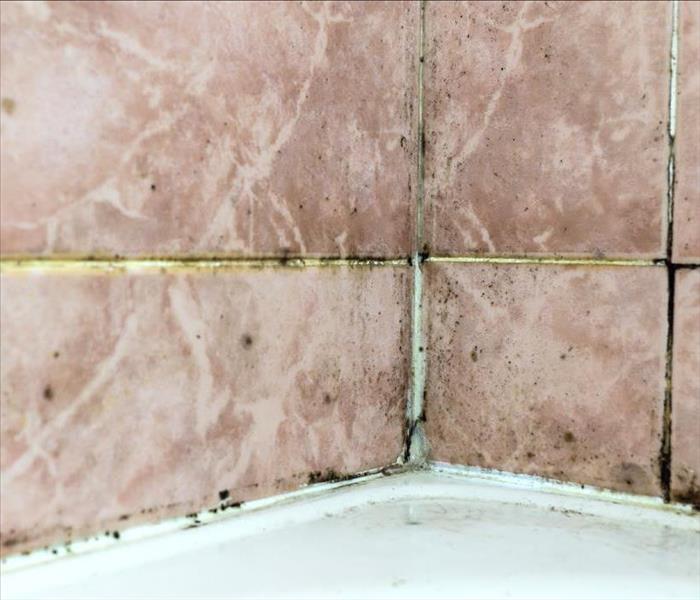 Black mold damage in Ross, OH
Black mold damage in Ross, OH
Simple Ways of Getting Rid of Mildew in Your Bathroom
If you are finding dark spotting in the grout of your tiling in Ross, OH, you most likely have bathroom mildew. Don't panic, there a lots of ways to send it packing, all you need to do is choose what sounds best to you.
Natural Methods
Ingredients easily found in the home can be combined to make an effective mold cleaning solution, especially for tiles and grout. These following three ingredients can be used in multiple ways:
- Baking Soda
- Vinegar
- Lemon Juice
One method is to sprinkle baking soda on the area, then pour white vinegar over it. Let it sit for about 5 minutes to let the reaction loosen the particles or mold, then rinse thoroughly with warm water. You can also combine all three ingredients into a paste- use equal parts vinegar and lemon juice, then add baking soda until the desired consistency is reached. Spread this paste over the affected area and then scrub with a brush, then rinse. This method is better for vertical surfaces, as it does not drip.
Commercial Methods
It's possible to buy bathroom mildew removal products at most grocery and hardware stores. They require a similar process: spray it on, let it sit and scrub it off. They usually contain ingredients like ammonia, bleach or alcohol, so be sure to ventilate the room well when using them. If you are wary of such harsh chemicals, you can use milder powder detergents that are marketed for more general use.
Prevention
Mildew takes months to develop into a stain that you can see. So, if you regularly clean your bathroom before you can see mildew, it won't have a chance to grow. It's also a lot easier to clean often, than to scrub away at mildew for hours. Mold likes damp environments, so adding more ventilation to the room can solve a humidity problem before it occurs.
Bathroom mildew can seem like a big problem, but there are lots of simple ways you can get rid of it yourself with a little sweat equity. You probably won't even need to call a mold remediation specialist.
How Flood Zones Help You Determine Your Risk for Flooding
9/11/2019 (Permalink)
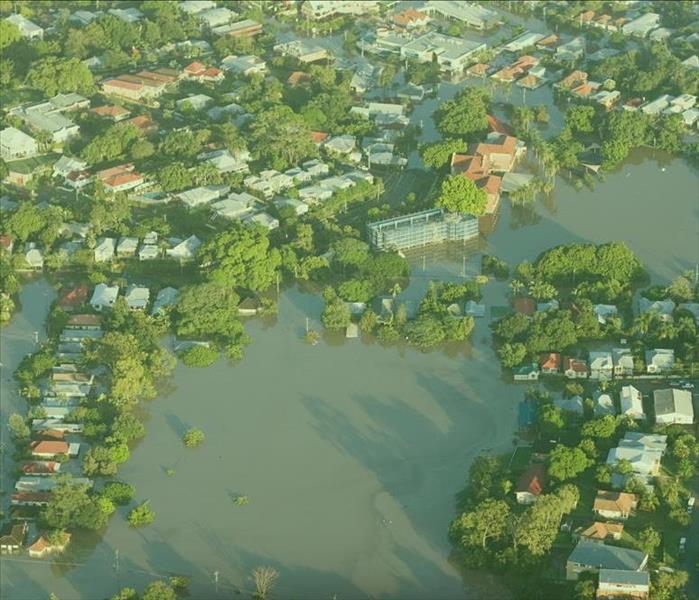 By learning your flood zone, you can take steps to better prepare yourself for this type of event
By learning your flood zone, you can take steps to better prepare yourself for this type of event
When it comes to natural disasters, floods are both common and dangerous. If you own a home in Trenton, OH, it’s important to be aware of your risk for flooding. Follow along below to learn how knowing your flood zone can help you determine this risk.
What Are Flood Zones?
Flood zones are simply areas of land, each with a defined level of risk. Each zone is defined by the Federal Emergency Management Agency (FEMA) and falls into one of the following three overarching categories:
- Special hazard area
- Moderate hazard area
- Minimal hazard area
Within these categories, zones are identified by a letter code. For example, if you’re in a moderate hazard area, you will belong to Zone B or Zone X. You can find definitions for your specific flood zone through FEMA.
Determining Your Zone
Knowing your home’s zone can help you make insurance and property protection decisions. Fortunately, it’s easy to figure out which zone you’re in. The first step is to visit the FEMA Flood Map Service Center website. Here, you can enter your home address to reveal a Flood Insurance Rate Map (FIRM) for your location. Follow the map’s legend to find out your property’s level of risk.
What Are Your Options if You Experience a Flood?
In high-risk areas, a storm with heavy rainfall can easily lead to flood conditions. Luckily, if you experience damage, you have options. If you have flood insurance, check with your agent and begin the process for a claim. You may also want to look for emergency restoration services, which can help you restore your home to its pre-damaged state.
Flooding has the serious potential to damage or destroy your property. As a homeowner, it’s a smart idea to know your risk. By learning your flood zone, you can take steps to better prepare yourself for this type of event.
Replace Your Leaking Toilet in 5 Easy Steps
8/21/2019 (Permalink)
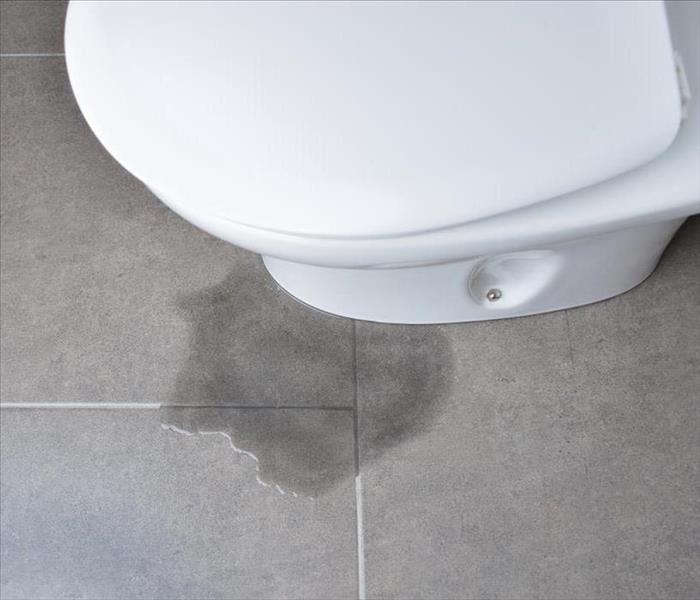 Leaking toilet in a Hanover Township, OH home
Leaking toilet in a Hanover Township, OH home
Have You Found Yourself With a Leaking Toilet?
It may be time to get it replaced. If you’d like to tackle replacing your toilet DIY-style, grab a buddy and read on for these five easy steps.
Prep the Area
The first thing you’ll want to do to is to disconnect the water supply. Once done, drain the water from your toilet. This can be done by flushing the toilet repeatedly and then removing the remaining water with a sponge. Disconnect the water supply line from the bottom of the toilet tank.
Detach Your Old Toilet
Loosen the bolts at the base of your toilet. Using a sharp knife, very carefully pry off the caulk seal around the base of the toilet bowl. You can sway the toilet back and forth to wrench the base from the seal. The toilet can now be removed.
Prepare for Installation
Use a knife to remove the wax ring located at the base of your toilet. You may now install a new wax ring. In some instances, simply replacing this wax ring can solve the issue of a leaking toilet.
Set Your New Toilet
Caulk the bottom of the new bowl and lift it into place, guiding it securely over the hole. Secure the base with bolts. Attach the tank to the bowl.
Check Your Toilet Repair Work
Make sure your toilet is level before reconnecting your water supply. Once the tank has filled with water, give it a couple of test flushes to check for leaks or blockages. Before you call it a day, you may want to check for any water damage, mold or mildew. If you are in need of further remediation, there’s no need to do it on your own, there are experts in Hanover Township, OH, that can help!
Replacing your old, leaking toilet is a manageable task when you’re equipped with the right tools and a proper guide. Rest easy with the knowledge that as a homeowner you can undertake any task with the help of friends and professionals.
Are You Prepared for the Storm?
8/14/2019 (Permalink)
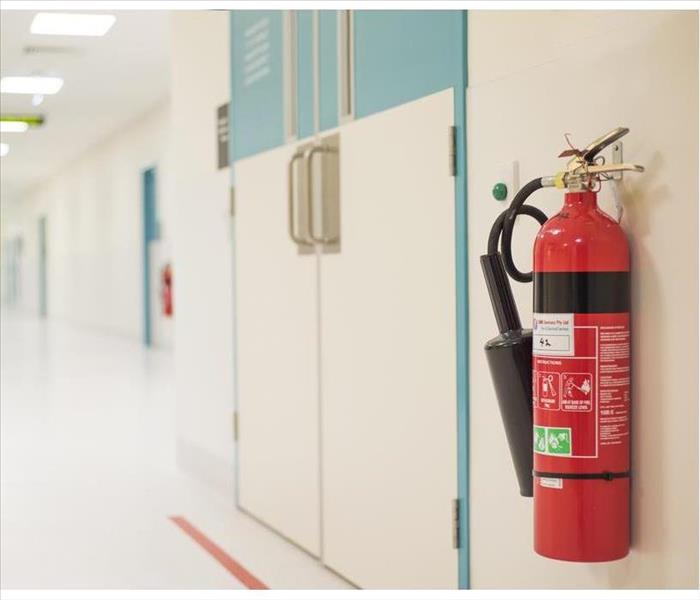 Keep fire extinguishers accessible throughout a property
Keep fire extinguishers accessible throughout a property
Property managers in Oxford, OH have a lot on their plates. While the day-to-day bustle may seem nonstop, time needs to be set aside to ensure your properties and the people in them are ready for anything. Although no building is safe from Mother Nature’s wrath, developing a storm preparedness plan can ensure confident handling of emergency situations.
Develop and Communicate the Plan
Property management often means juggling numerous unique properties. Although each may have its own special requirements, it’s important to develop a general emergency plan. Once that is in place, special needs for each property can be incorporated. This plan needs to be clearly communicated to all tenants and anyone associated with a property.
What Should a Plan Include?
Storm preparedness requires considering all possibilities. A bad storm could result in fires, evacuations, property damage and much more. They key elements of a plan should address the who, what and where of facing whatever may come.
Ensure diagrams are in all buildings that include emergency exits, fir-safe stairwells and other safe spots.
Keep fire extinguishers accessible throughout a property. Include instructions on their proper use.
If a building has an emergency detection system, ensure it is working. If it doesn’t, assign a person and backups to be responsible for calling 911.
Have an established way to contact tenants. This could be through automated voice messages, texts or emails.
Plan for backup communications in case the power goes out.
Plan for Damage
Even with a storm preparedness plan in place, damage can happen. To reduce the risk, keep buildings up to code. Regular maintenance can ensure codes are continually met. In addition to insuring the properties, encourage tenants to obtain renter’s insurance for their own protection.
Once the storm subsides and everyone is safe, that is the time to access the damage. Whether it’s a little or a lot, count on trusted professionals to get your property ready to weather the next one.
Ways to Prevent a Fire From Happening in Your Commercial Building
8/7/2019 (Permalink)
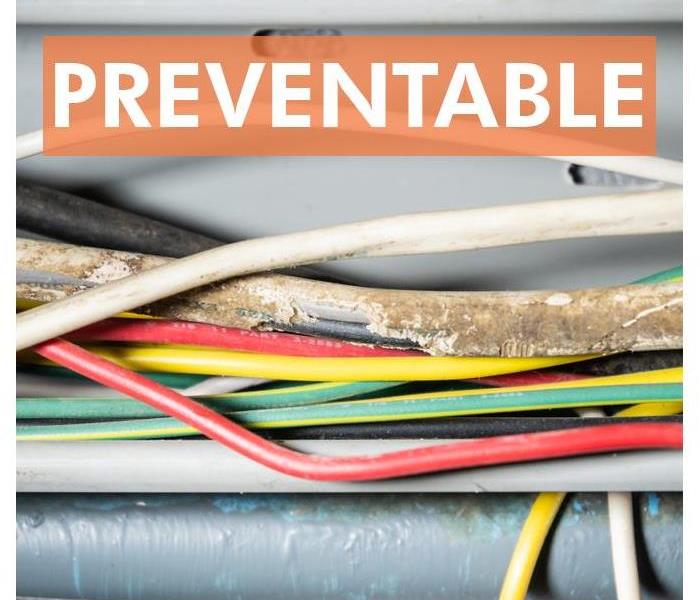 Electrical fires can be prevented
Electrical fires can be prevented
Fire Prevention In Your Commercial Building
No business owner wants to hear that they've had a fire. It can have serious financial consequences and can even lead to a company going bankrupt. Taking the proper precautions is one of the best ways to help with fire prevention in your commercial building in Hamilton, OH. While a fire is never completely avoidable, here are a few things you can do to protect your business.
Have the Right Equipment
Placing fire extinguishers throughout the office is a great way to help stop the flames from spreading further and can help protect your office equipment from excessive damage. Many companies have installed an automatic sprinkler system in the building, which turns on in the event that a fire occurs. If your equipment does suffer fire or water damage, you may need to a hire a fire restoration company to come in and help.
Check Your Wiring
Oftentimes, a business fire is caused by faulty wiring. Many older buildings are not up to code and are therefore more susceptible to electrical fires. Having your wires checked and replaced regularly can go a long way in fire prevention. It is also important to keep appliances at least a few inches away from the wall and to turn off all appliances and electronics each evening before leaving work.
Educate Employees
Employees sometimes do not realize the potential fire hazards around them. Keeping them informed may not only prevent fire damage from happening, but it can also keep them safe in the event that one occurs. Hold meetings regularly to inform employees about ways they can help with fire prevention and to go over what to do if there is a fire in the building.
Having a safety plan is place is one of the best ways to protect your employees and your business. Fire prevention is not something that should be done once and checked off of your list. Make sure to keep your plan up-to-date and talk to your employees regularly about fire safety and what to do in the event that one occurs.
Flooding in West Hamilton, OH
7/24/2019 (Permalink)
When flooding damages your Hamilton, OH, home, it can be difficult to know how to proceed with cleanup efforts. One of the first steps you can take is to prepare for the insurance adjuster’s visit once you have filed the claim. Knowing what you will need to make visit simple for the home adjuster can result in a faster payout and less stress for you as the homeowner.
3 Ways To Prepare for an Insurance Adjuster.
- Know What Paperwork You Will Need
Before you call a flood damage and water cleanup service to help with mitigation, call your insurance agent and ask him or her what kind of paperwork you will need to prepare for the adjuster’s visit. You may be able to download and print some forms from the provider’s website. Being well prepared can make the job simpler for your home adjuster and expedite the filing of your claim.
- Make a List of Losses
Before the adjuster arrives, you may want to make a list of all the items that were damaged or destroyed in the flood. Remember to include when you bought them, a copy of the receipt if available and whether any of them have been previously repaired. The more information you can provide, the easier it will be for your adjuster to help you file your insurance claim.
- Make a Video Record
Thanks to smartphone technology, it is simpler than ever to take photos and recordings of any flood damage to your home. Document stains, cracks and new mold growth that might have resulted from standing water. Make copies of photos and ask where you can send your videos so your adjuster can review them if necessary. Remember to back up your videos in case you need them later.
Being prepared to talk to your insurance home adjuster after a flood damages your Hamilton, OH, residence can give you peace of mind. Working efficiently with this knowledgeable individual might result in a quicker insurance payout so you can get started on repairs right away.
The 4 Main Steps of the Mold Remediation Process
7/22/2019 (Permalink)
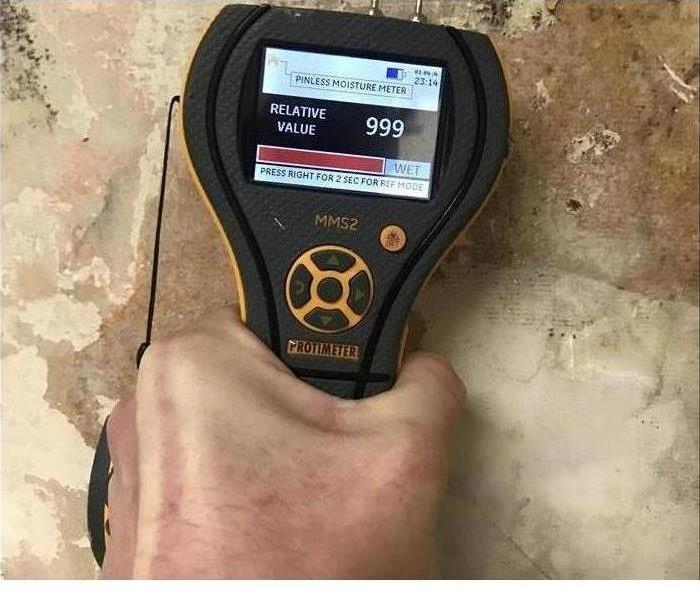 Mold test may be necessary
Mold test may be necessary
Step by Step Mold Cleanup Process
When people in Ross, OH, hear the term mold remediation for the first time, they often believe it is synonymous with mold removal. Unfortunately, it’s not. Mold and its spores are almost everywhere, which is natural. Special factors make them latch on to problem areas and grow in concentrated form. Because of this, remediation focuses on remedying the problem spots as opposed to claiming to remove spores for good. Here is the step-by-step mold cleanup process.
1. Check for Mold
When you call mold remediation specialists, the first thing they will do is check for mold. If you can already see black mold, then mold is definitely present. However, the specialist may need to identify the type of mold, as well as seek out other affected areas. If there is a moldy smell but you have not identified where it is, then a mold test may be necessary.
2. Seal the Area
Black mold spores can spread and lead to cross contamination, so once the problem areas are discovered, professionals may seal this off. It is best to schedule cleaning when the business is closed so as not to disrupt operations.
3. Clean Up the Mold
How professionals clean the area will depend on how bad the mold is and the type of mold. The type of surface will also need to be taken into consideration. For example, tiles can be wiped down with a biocide. However, drywall or wallpaper may need to be removed and replaced.
4. Use a HEPA Vacuum
HEPA vacuums help to clean up any additional spores that professionals may have missed. Remember that not all mold is visible, as these are microscopic organisms. Thus, the vacuum helps to ensure even the mold that cannot be seen with the naked eye is cleaned up from that area.
If the area is routinely damp and dark, then you may also want to consider using a dehumidifier and HEPA filter. These help to make the area less favorable for the growth of black mold.
How To Deal With Mold Damage After Flooding
7/21/2019 (Permalink)
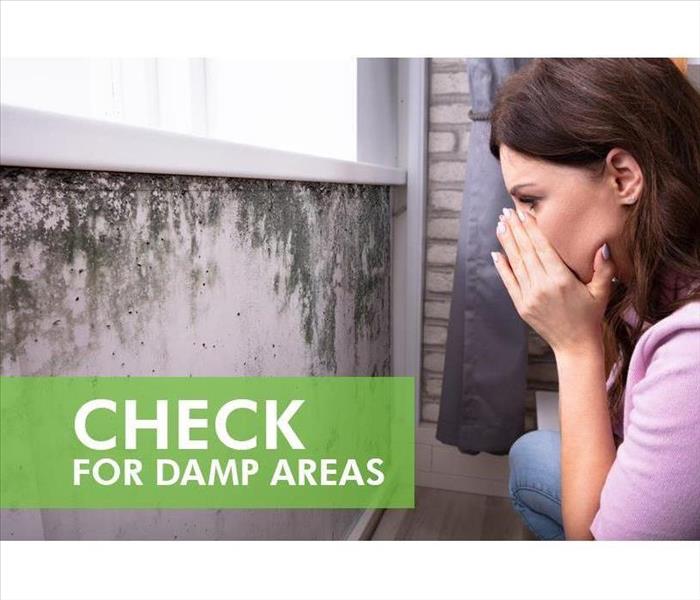 Mold thrive in damp environments and is common in flood-damaged buildings
Mold thrive in damp environments and is common in flood-damaged buildings
When your home in Trenton, OH, is affected by a flood, the excess moisture left behind can quickly lead to mold growth. The presence of mold can have a big impact on the health and safety of your household. Here are some steps you can take to address mold in your home after a flood.
What Should I Do First?
After the flood water has subsided, there is a handful of steps you should take immediately to minimize damage:
- Bring your items out to dry. You can do this by removing items from your house and moving them to an open area unaffected by the flood to give them the opportunity to dry.
- Air out your house. Opening doors and windows as well as strategically placing fans will increase air circulation and speed up the drying process.
- Remove moisture from your home. This will require using specialized equipment such as wet vacs and dehumidifiers to suck the moisture out of carpets and other surfaces to mitigate the growth of mold. Any standing water must be addressed immediately.
How Do I Identify Mold?
Mold thrives in damp environments and is common in flood-damaged buildings. If there is enough moisture present in the area, mold and bacteria are likely to flourish and multiply. Mold is commonly located in walls, carpets, and wood with high moisture levels.
Mold growth can be identified by a discoloration that can encompass a wide variety of colors. It may be orange, white, or greenish brown or black. There is also a characteristic odor that can be described as stale or earthy.
Should I DIY or Hire a Professional?
Acquiring the services of a professional flood restoration company is a good investment, especially considering the specialized equipment and level of expertise needed to address such a scenario. No matter what, whether you decide to DIY or hire a service, addressing mold in your home is a crucial step in ensuring your safety and comfort for years to come.
Mold growth waits for no one. By acting quickly and enlisting the help of qualified, experienced professionals, you can minimize the effect of unwanted water on your home.
How Do I Prevent Water Damage?
7/19/2019 (Permalink)
Experiencing a water loss can be an extremely traumatic experience for you and your family. That is why it is so important to be as prepared as possible. Here are a few things to think about, to be better prepared from a water loss.
Preparing for Water Damage
- Make sure that you are aware of where all of your shut off valves are located. These can be critical in minimizing damages if you have a pipe break in your home.
- Be sure to have all of your emergency contacts in your cell phone. This can include local city utilities, plumbers, electricians and any other service company. SERVPRO of West Hamilton/ Oxford is a 24/7 company so you are welcome to call us at anytime.
Although there are times where we can't prevent the worst in happening to our homes, the more we are prepared the better chance we have of minimizing the damages.
Water Damage From Extinguishing a Fire
7/15/2019 (Permalink)
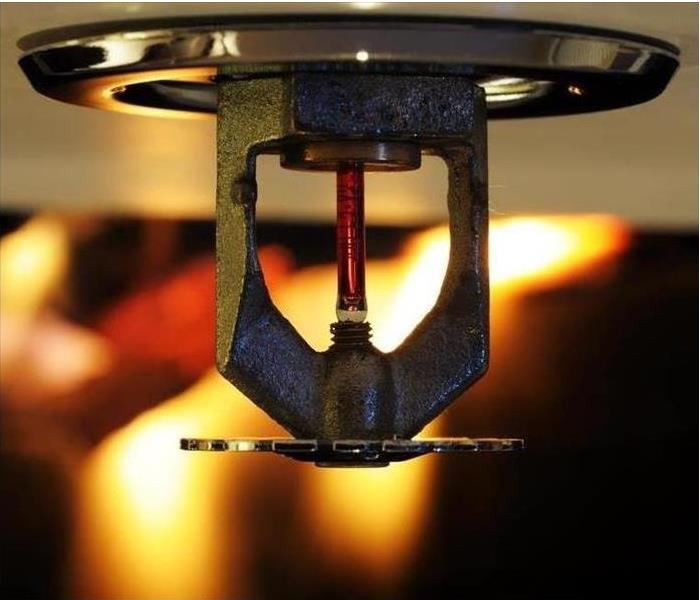 Call professionals for assistance with water removal as soon as possible after the fire has been extinguished.
Call professionals for assistance with water removal as soon as possible after the fire has been extinguished.
Water damage is not the first thing that comes to mind when a fire occurs, but if a fire is extinguished, there is a very high chance that your business could sustain substantial damage from water during the extinguishing process. After the fire hose is rolled up, and the firefighters leave, the effort to save your building’s structure from fire damage may leave your business flooded. For perspective, water usage for fire control is measured in gallons per minute, and it may take around 400gpm to control a fire in a small business. At this rate, water from a fire hose could fill an Olympic sized swimming pool in just over a day, which may seem like a long time, but this same task with a garden hose would take over 110 hours.
A Plan of Action
- The first thing to do when planning for fire damage restoration is to form a plan of action. This includes taking damage from water into account.
- Formulate a plan that details which items were too saturated with water to be restored and areas where water extraction may be required.
- Before reconstruction, find local Hamilton, OH, professionals who can use pumps and vacuuming equipment to evacuate excess water in your building.
- It is also necessary to dry, dehumidify, and sanitize the property after the majority of water has been removed. After this has been done, restoration of the areas affected by the fire can begin.
Restoring Your Business
Being prepared for the abundance of water that accompanies fire extinguishing can help your business get back on its feet sooner. Call professionals for assistance with water removal as soon as possible after the fire has been extinguished to prevent excessive damage from standing water. Proper attention to water removal after suffering fire damage is vital, and forming a plan of action can speed the process of restoring your business to pre-fire condition.
Having a Plan Can Save Your Life
7/15/2019 (Permalink)
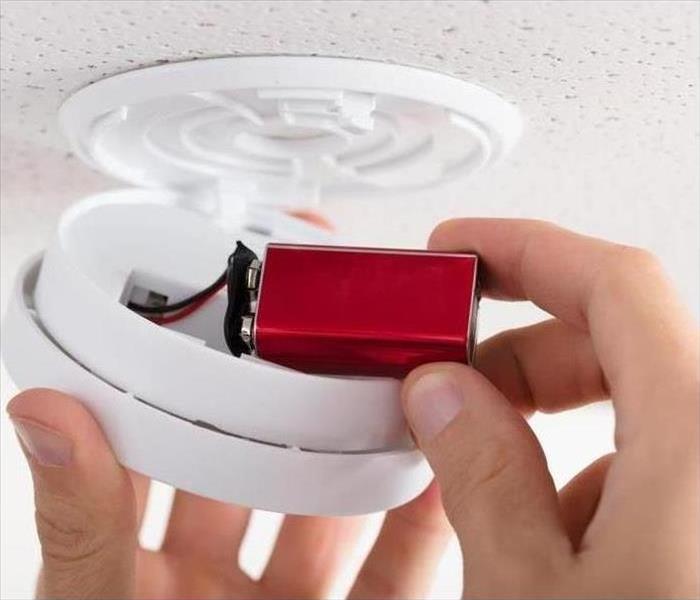 Being prepared can make all the difference in the world in the event of a fire.
Being prepared can make all the difference in the world in the event of a fire.
You might think that the fresh batteries in your smoke detectors are enough to keep you and your family safe in the event of a fire. While working smoke detectors and batteries certainly are a must, without a fire escape plan, how will you and your loved ones know what to do when the smoke detectors go off? If disaster strikes, you need a plan you can set in motion immediately. There’s an old saying that schoolteachers like to use: If you fail to plan, you plan to fail. In the event of an emergency, you don’t want to have to think on your feet; instead, you want to be able to take action – and fast.
According to the American Red Cross, the best way to protect yourself and your family is to create your very own emergency escape plan, and to practice it regularly. Here are the key elements of this kind of plan:
- If your home includes bedrooms above ground level, think about purchasing escape ladders for these rooms. Ladders can be kept close to the window.
- Make sure everyone in your home knows more than one escape route from each room in the house.
- Teach your littlest family members to dial 9-1-1 in case of smoke or fire.
- Choose a meetup spot outside, and let everyone know where it’s located.
- Fire drills are not just for schools – practice your own fire escape plan until you complete the drill in two minutes or less.
- Rehearse your plan using realistic conditions, like practicing in the middle of the night and using a low crawl to help minimize possible smoke.
Comfort in Planning
Being prepared can make all the difference in the world in the event of a fire. However, having a plan won’t stop a fire from starting. If fire does strike your Hamilton, OH, home, you can rely on fire restoration professionals to help you clean up. In the meantime, you can feel confident that the creation and practice of your family’s fire escape plan will reduce the risk of harm to you and your family if you’re the victims of a house fire.
Workplace Escape Plans
5/6/2019 (Permalink)
 The best time to plan your evacuation route is now
The best time to plan your evacuation route is now
Evacuation Plan
A fire drill is only one of the many types of workplace escape training procedure. Any number of disasters can necessitate the evacuation of a building, such as a severe thunderstorm or flood damage. Practice the correct methods so that you can maintain your calm in a serious situation.
1. Employer Responsibilities
OSHA and other agencies have guidelines for which businesses in Hanover Township, OH, much have an emergency action plan (EAP). If your workplace is large enough to require portable fire extinguishers or a fire suppression system, then you are probably responsible for devising an evacuation strategy. However, having marked exits and holding the occasional fire drill is only one element of an EAP. Other components include containing hazardous waste, alerting local authorities, and first aid availability.
2. Employee Knowledge
You can't assume that just because your EAP exists on company records that your employees will reliably be able to actualize it. Be sure to review individual response roles with the relevant staff, such as those who are trained in CPR. Make sure that all medical equipment is readily accessible. If any sensitive equipment needs to be shut down in an emergency, have those responsibilities clearly delegated. Should any flood cleanup be necessary, wait for qualified industry professionals and do not attempt to enter the building.
3. Movement
The panic of a crowd can sometimes be more dangerous than the fire or storm damage that lead to the evacuation. The most critical component of any EAP is the process that moves employees from danger to safety. Hold a flood, storm, or fire drill routinely. Ask your local fire department or police station to review your process and make recommendations. Record evacuation times and set targets for improvement.
Remember, a fire drill is only one part of a holistic action plan comprising all elements of your business. Stay prepared by making sure that the right people have the best available information.
3 Ways Electronic Records Can Assist With the Claims Process
4/29/2019 (Permalink)
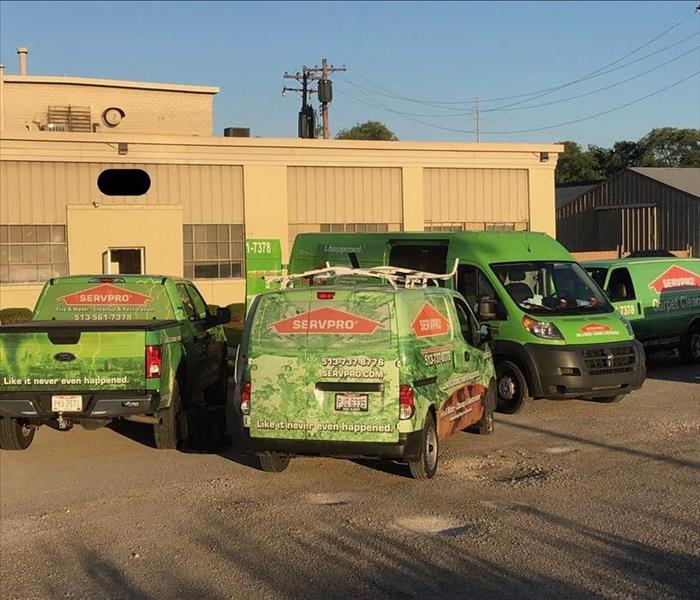 Our team is on standby 24 hours a day, 7 days a week, 365 days a year to respond to your emergency.
Our team is on standby 24 hours a day, 7 days a week, 365 days a year to respond to your emergency.
When your home is damaged, whether it be by a flood, fire or accident, you will likely need to file an insurance claim to cover the cost of repairing the damage and restoring your house. Hiring certified restoration specialists who utilize an electronic claims service can help you file your claim faster and better. The faster you file, the sooner you can be compensated, so this service can save you a lot of worry.
3 ways the Claims Information Center at SERVPRO in Hamilton, OH, can benefit you.
1. Error Reduction
When you have to copy information from one source to another, there is always the chance that you can make an error. One small discrepancy between your claim and the information provided by the repair company can cause your claim to be delayed or even denied. When a preferred vendor such as SERVPRO makes their electronic records available to you and your insurance agent, you don't have to worry about something being written down incorrectly. The fewer hands information has to go through to get to your insurance company, the fewer the mistakes that are likely to be made.
2. Record Retention
Files can easily become disorganized. When records are stored electronically, finding the file needed for an insurance claim is a simpler process. Anyone who can access the records can search for the needed information and find it relatively quickly.
3. Delivery Efficiency
When your home has been damaged, a quick turnaround for getting repairs done and paid for is preferred. Paper-based claim filing can take quite a long time. You wait to get the records from your repair specialists, and then you must wait for those records to reach your insurance company. Electronic records, however, can be accessed and sent immediately, making the time it takes to file your claim shorter.
Getting the money you need from your insurance company is important. When you need to file an insurance claim, SERVPRO of West Hamilton/ Oxford is Here to Help.
The Importance of Quick Storm Services After a Disaster
4/29/2019 (Permalink)
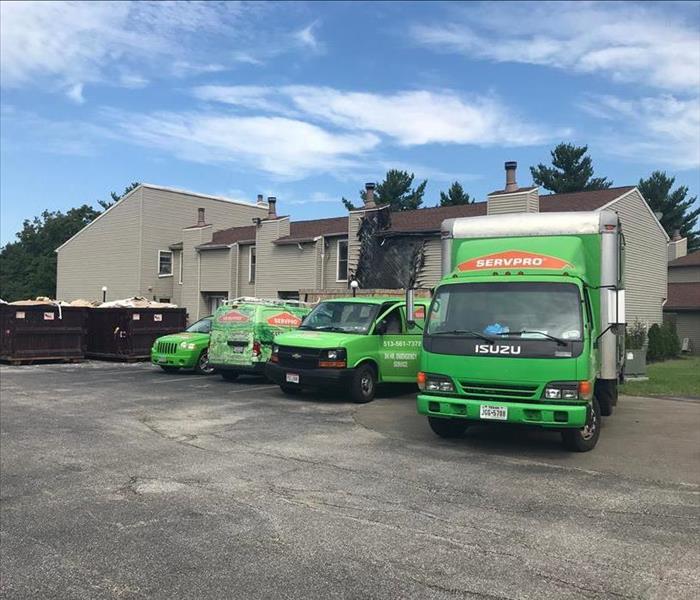 If disaster strikes your home or business, SERVPRO of West Hamilton/Oxford is Here to Help. Our team is on standby 24 hours a day, 7 days a week, 365
If disaster strikes your home or business, SERVPRO of West Hamilton/Oxford is Here to Help. Our team is on standby 24 hours a day, 7 days a week, 365
A storm in Hamilton, OH can be devastating to a home, and working with a company that is experienced in restoring homes affected by storms is important, though some companies work more quickly than others.
Starting the storm restoration process quickly is often wise for a variety of reasons.
1. Quicken the Claims Process
After a storm occurs, one of the first steps homeowners need to take is to begin making a claim to their insurance. After a claim has been filed, homeowners will be able to begin the restoration process. However, the longer it takes to file a claim, the longer the process of restoring the home will likely take. When a restoration company is able to respond in a timely manner, this can help to speed up both the claims and restoration process.
2. Mitigating the Damage
Storms with heavy winds and rain can affect the overall structure of a home. Often, ceilings, roofs, drywall and even the foundation of a home may need to be replaced or restored, and the longer these areas are left alone, the more likely it becomes that the areas will need major fixes. However, if storm restoration begins quickly, this can decrease the likelihood of major structural damage occurring.
3. Restoring Items
While storms are capable of damaging the overall structure of a home, flood damage can also impact personal belongings within a home. When items are left in wet or damp environments, mold growth often occurs, and it’s not always possible to restore items that have mold growth. However, if there is a quick response to a storm, items within the home are more likely to have sustained less damage, therefore making it more likely that they can be restored.
When storm restoration occurs quickly, the claims process is likely to be fast, damage can be prevented and items will more likely be able to be restored. When homeowners need a reliable storm response, contacting storm damage and restoration professionals is often helpful.
Are Storm Shutters Right for You?
4/25/2019 (Permalink)
 With heavy storms a relative rarity, it’s easy to forget about the damage they can cause.
With heavy storms a relative rarity, it’s easy to forget about the damage they can cause.
With heavy storms a relative rarity, it’s easy to forget about the damage they can cause. However, it takes one round of pelting rain and high winds to remind you. One of the simplest ways to protect your property is to install storm shutters. These subtle additions can make all the difference for your Oxford, OH home.
What Are They?
Storm shutters are simply coverings designed to protect your windows from gusts and debris during a storm. Common along hurricane-prone coastal areas, they come in several styles:
- Bahama style - typically propped open with a pole
- Colonial style - often decorative and typical in colonial-style homes
- Accordion style - a seamless version that you can easily pull closed
We know some of the types, but what are their benefits?
They Are Cost-effective
There are plenty of steps you can take to protect your home against storms, such as high-impact windows. However, when it comes to something affordable, it’s hard to do better than window coverings.
They Increase Home Value
This addition is believed to increase your home’s resale value - especially if you live in a storm-prone area. Imagine the relief a potential buyer of your home would feel knowing there are built-in safeguards against the high winds, hail and debris of a storm. An added benefit is that they are attractive and timeless.
They Lower Insurance Costs
Insurance companies are getting increasingly strict about coverage for homes damaged by storms. If you live in a coastal area especially, storm damage seen as preventable might not be covered.
Window coverings are an attractive and affordable addition to your home that also bring the added benefit of protection from high winds in a storm. Whether you’re coastal and face hurricanes or inland and just deal with the occasional storm, any storm cleanup professional will tell you that shutters are one of the easiest and best ways to get your house through the weather intact.
Winter Isn’t Over: Be On the Lookout for Frozen Pipes
4/18/2019 (Permalink)
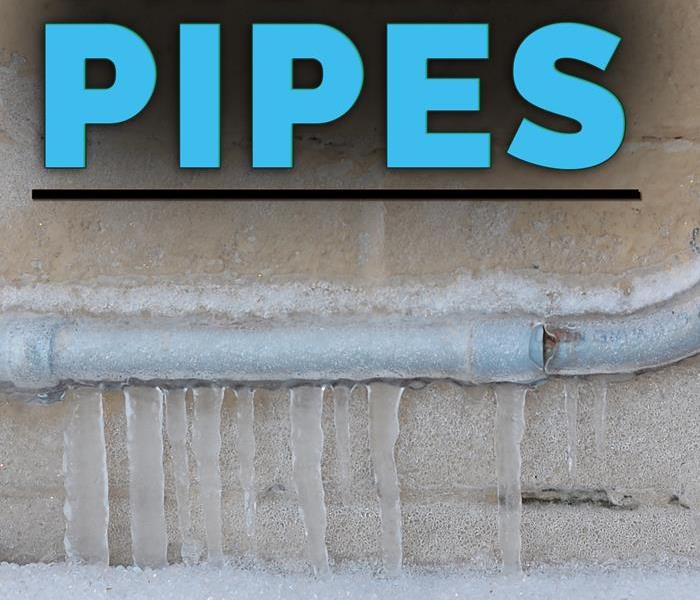 Keep an eye on your exposed lines and watch for frost.
Keep an eye on your exposed lines and watch for frost.
Cold weather is still present in the first few weeks of March. The temperature may go from 40-50 degrees during the day down to 20 degrees at night. Therefore, frozen pipes are still a concern for many businesses, especially those operating out of warehouse-type facilities, and it pays to be aware of the signs of freezing pipes so that you can be proactive rather than reactive to potential water damage.
1. Frost
The first sign of potential problems is the appearance of frost on your water pipes. Frosting may occur on pipes that are located on or near exterior walls. However, it is also possible that it happens on plumbing located in an inadequately heated facility. If pipes are allowed to persist this way, then the pressure of freezing water will likely result in broken pipes and flooding.
2. Odor
Odor is another sign of freezing water lines. As water freezes, it does not allow for proper ventilation which can lead to gases and odd odors coming back up through floor drains and sinks. These smells are a significant sign of pending water damage and disaster.
3. Lack of Water Pressure or No Water
The last sign of frozen lines is the reduction or complete loss of water pressure. If you notice that the faucets in your facility have limited to no flow, then you should call a plumbing specialist in the Hamilton, OH area before a thorough water cleanup is necessary. No water means that there is a blockage, and if your facility has experienced frozen lines in the past, then you are likely dealing with a complete freeze, which can lead to burst pipes and flooding.
Water damage caused by freezing results in more than flooding; it causes damage to the plumbing itself. Unlike a backup where water overflows, freezing creates breaks, cracks and splits, meaning that repairs are extensive and costly.
Don’t let the spring thaw calm your nerves about the winter cold. Keep an eye on your exposed lines and watch for frost. Pay attention to strange odors and call for help if you have a sudden loss of water pressure.
Can You Be Insured for Mold?
4/11/2019 (Permalink)
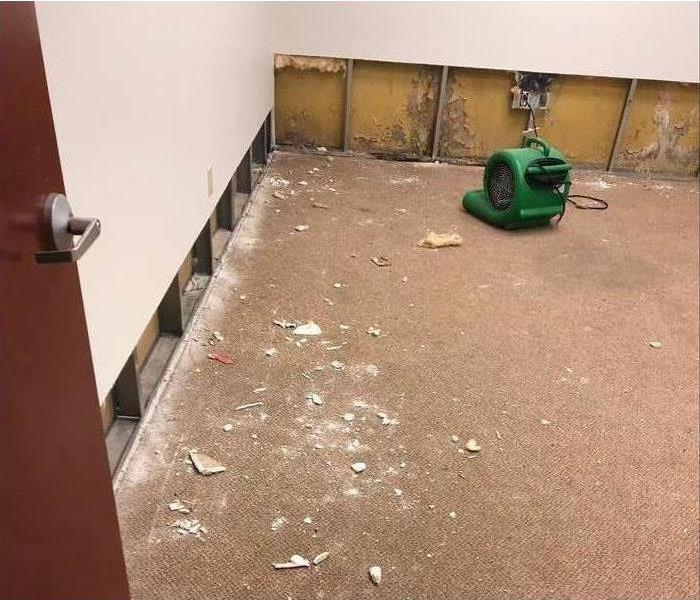 Your commercial property is likely insured for a variety of possible circumstances.
Your commercial property is likely insured for a variety of possible circumstances.
Can You Be Insured For Mold?
Your commercial property in Oxford, OH is likely insured for a variety of possible circumstances. Your liability coverage covers any legal costs that you may have due to incidents that occur in the building. Your flood coverage covers damage done by major flooding. Fungus removal isn't always covered under a property policy, but you may have limited coverage due to an exception. Here is how your insurance coverage likely breaks down when it comes to mold remediation.
Limited Coverage
If you let a problem go unresolved for a long time, your commercial insurance provider is likely to view this as neglect and deny your claim for mold remediation services. If, however, you take action to resolve a leak as soon as you notice it, your policy may cover the following expenses:
- Pretesting for mold growth
- Removal of damaged materials
- Cleanup of damage
- Replacement of unsalvageable items
- Post-testing to confirm complete remediation
Be advised that your policy is unlikely to cover more than $15,000 for fungus removal per year. If the problem is extensive, therefore, you may incur some out-of-pocket expenses to fully mitigate the damage.
Mold Exclusion
When you see a mold exclusion in your coverage, that doesn't automatically mean that you are completely on your own when it comes to paying for remediation. Many companies place these exclusions in their policies to avoid confusion when it comes to legal issues regarding mold and mold cleanup. To fully understand the circumstances under which a mold problem would be covered by your policy, you should discuss it with your insurance agent. Then, if you decide that you do not have adequate coverage, he or she can suggest additional coverage for your commercial package.
The bottom line is that it's important to know if fungus removal is covered by your commercial policy. Your insurance agent can answer any questions you have about your coverage so that you can make the decision that is right for your business.
Storm Services: How Can They Assist Insurance Agents During Times of Disaster?
3/25/2019 (Permalink)
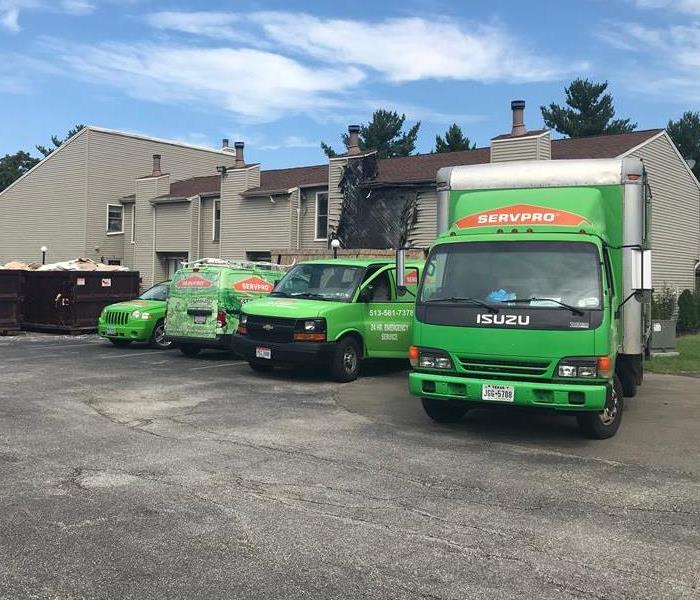 Professional flood technicians can create one comprehensive damage report for each company to make filing claims simpler.
Professional flood technicians can create one comprehensive damage report for each company to make filing claims simpler.
Storm Services: How Can They Assist Insurance Agents During Times Of Disaster?
When powerful storms strike Oxford, OH they can affect a variety of businesses and create an influx of work for insurance agents and claims adjusters. These professionals must inspect each property, help the owner file a claim and ensure it is processed properly. Having a storm restoration company on hand can give these agents the support they need, especially in a large city or after a serious natural disaster.
Assessment of Damages
Storms that contain heavy rains and high winds can cause an array of damages to businesses. Properties may require significant repair and might include the following:
- Broken windows
- Damaged roofing material
- Flooded drywall and carpeting
When storm response teams work in tandem with insurance agents and adjustors, they can streamline the assessment process by reporting which damages will need to be repaired right away. They also help determine the type of restoration service that is needed and the cost of associated with it.
Faster Claims Processing
When multiple businesses in the same area suffer damage due to flooding or high winds, insurance agents may have a difficult time processing claims at a rate that helps owners recover quickly. This can be especially true in the case of flood damage, where the claims process can be extensive. Agents that work with a restoration service may be able to offer a faster turnaround. Professional flood technicians can create one comprehensive damage report for each company to make filing claims simpler.
Less Confusion
Insurance agents that collaborate with a storm restoration service may be able to work with multiple customers in the same area with more efficiency, even when the damage to each property is similar. Detailed reports and repair estimates may help agents avoid confusion in the aftermath of major flooding.
The storm restoration process can be daunting for business owners in Oxford, OH. However, when their insurance agents are supported by knowledgeable storm repair experts, the claims process may not be as difficult for them.
How to Prepare For a Visit From Your Home Adjuster
3/18/2019 (Permalink)
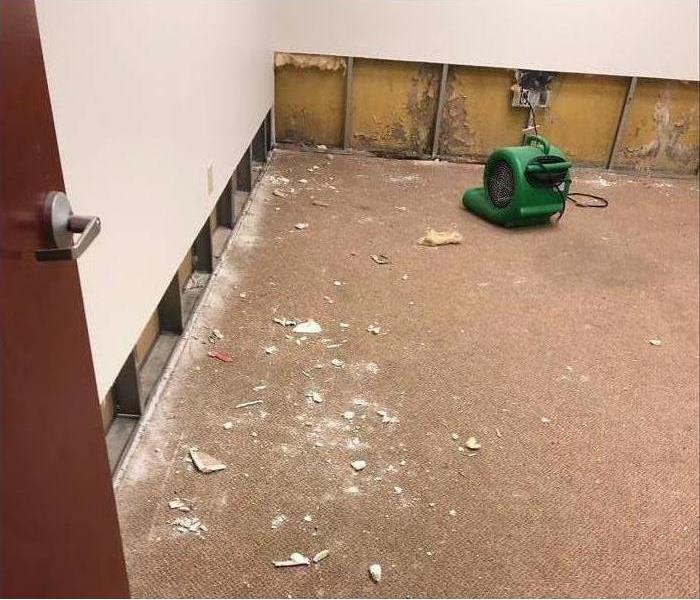 In the event of damage to your home, it is best to contact your insurance company as soon as possible.
In the event of damage to your home, it is best to contact your insurance company as soon as possible.
How To Prepare For A Visit From Your Home Adjuster
In the event of damage to your Oxford, OH home, it is best to contact your insurance company as soon as possible. This helps the process go more quickly and will get you living comfortably in your home again sooner. Before the claim can be approved, you will need to meet with a home adjuster who will help assess the damages. Here are a few things that you can do to prepare for the visit.
1. Keep Track of Damaged Areas that Need to Be Shown to the Adjuster
Before the adjuster arrives, you should examine your home and locate any areas with damage related to the claim. Depending on the cause of the damage, this can include broken or missing roof tiles, cracked or warped walls or flooring or flooded areas. This information can help determine how much it will cost for a damage remediation specialist to make repairs.
2. Make a List of Damaged Belongings
It is likely that the structure of your home is not the only thing that was affected. If there has also been damage to your personal belongings, then you should keep track of that as well. You should create a list of items that have been destroyed or damaged that you will provide to the adjuster. Taking pictures can be helpful as well. Be sure not to throw out any of the damaged items before meeting with the home adjuster.
3. Fill Out Any Necessary Paperwork
When you file an insurance claim, there will likely be quite a bit of paperwork that you need to fill out. You should complete this as soon as possible to get the process finished more quickly. If you have any questions, the adjuster can help.
Because meeting with a home adjuster is an important step in filing a claim, you should make sure that you are prepared. If the visit goes smoothly, it will make the whole process go more easily.
3 Tips for Preventing the Spread of Mold
3/8/2019 (Permalink)
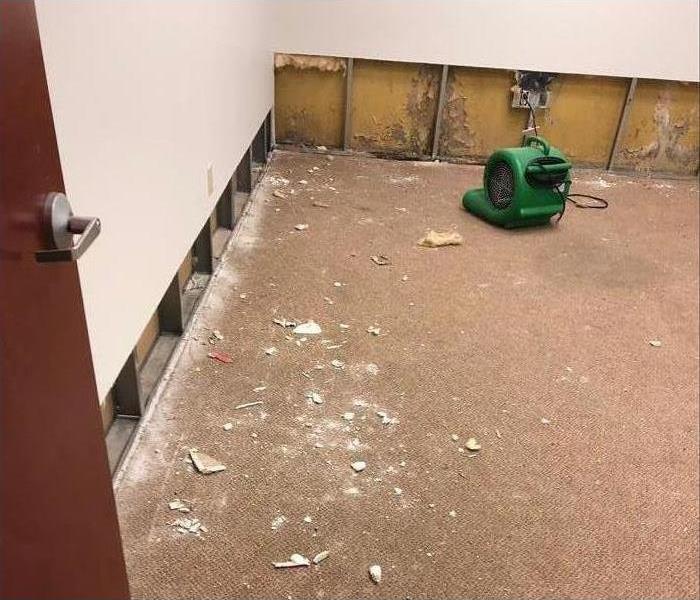 As soon as you know you have a black mold problem, make the call so that the professionals can start work on it.
As soon as you know you have a black mold problem, make the call so that the professionals can start work on it.
3 Tips For Preventing The Spread Of Mold
If you have ever had a mold problem in your home in Oxford, OH you know that it can get out of control in a hurry. Left on its own, this fungus will continue to grow as long as it has air flow, moisture and food. The best way to prevent spreading mold in your home is to deny it access to the elements that exacerbate it. Here are three ways to do that.
1. Enlist Professional Help
A patch of mold that's no bigger than an inch on a countertop can usually be cleaned with detergent. For larger problems, however, you need to call mold remediation experts. These specialists know exactly how to contain mold so that it doesn't get sucked into your HVAC vents and spread further. They also can do a thorough job of drying out the affected area to deprive mold of moisture.
2. Avoid Amateur Troubleshooting
Many homeowners who are concerned about spreading mold think that spot cleaning a problem area before professional help arrives will halt its growth. The truth is, however, that disturbing the mold growth without first blocking off the area the way the experts will do it can actually cause the spread you're hoping to avoid. Mold spores cannot be seen with the naked eye, so it's impossible to see if it's spreading.
3. Don't Delay
Mold growth will get bigger if you let it. It may be tempting to wait for a more convenient time in your schedule to have work done on your home, but this is not an issue that can wait. As soon as you know you have a black mold problem, make the call so that the professionals can start work on it.
Fungus growth is not something you should ignore. The most effective mold remediation is quick, professional attention. Follow these tips to prevent spreading mold.
The Claims Information Center: Helping Streamline the Insurance Process
2/19/2019 (Permalink)
While the insurance claim process in the Hanover Township, OH, area is no cakewalk for homeowners, insurance agents don’t necessarily have it any easier. The job of an agent or an adjuster is to verify the information provided on a claim and to ensure that all information is reliable and accurate. Thankfully, a disaster restoration expert has created a solution for all your claim woes. SERVPRO has created a claims system that will likely reduce research and approval time.
1. What Is the CIC?
The CIC stands for the Claims Information Center, and it is a culmination of claims organized by type, cause and response times. Additionally, the system provides an insurance agent with insight into the performance of the company against other national performers.
2. How Is It Useful?
The CIC allows agents to research a similar insurance claim to the one they are working on and to track its progress. This tool essentially operates as both an encyclopedia and a project manager, allowing insurers both accuracy and dependability.
3. What Is ReportER?
ReportER is SERVPRO’s corporate database and is, through the Management Dashboard, essentially the access point to the CIC. This is the area where agents can research and check on any current projects. The database is routinely updated, providing insurers with accurate and timely information regarding their current outstanding claims.
It is true that the insurance claim process is no cakewalk, and that insurance agents take on the brunt of the work. However, the CIC system allows an agent to research and verify information in a more accurate and reliable way. Through an innovative dashboard design, they are able to access information in the ReportER database and answer questions about project completion and corporate efficiency. Agents can now understand the whole picture by visiting one comprehensive and straightforward site. The Claims Information Center has truly streamlined the insurance process.
Business Insurance: Is Flood Insurance Necessary?
2/11/2019 (Permalink)
 Flood insurance is not necessary for every part of the country.
Flood insurance is not necessary for every part of the country.
Is Flood Insurance Necessary?
Flood insurance is not necessary for every part of the country. The fact is that certain areas are considered high-risk zones, which indicate a higher than average probability of a flood occurring. If your business operates in one of these areas, it may be beneficial to purchase the extended coverages offered by flood policies. However, this always brings up questions of coverages and comparisons between commercial and flood policies that require some explaining.
1. Commercial Policies
Commercial insurance does not typically cover external flood damage, meaning flooding that occurs because of storms and other surges. These policies will only cover damage done by broken pipes or blockages that are directly related to your property.
2. Flood Policies
Flood coverage is typically offered through the federal government’s National Flood Insurance Program. However, some other companies may provide riders to an existing policy, but these are rare for businesses. Flood coverage will only cover the damage done to the building due to flooding; it will likely not include landscaping, vehicles or business interruptions, these are typically only covered partially under the comprehensive option.
3. Requirements
Some businesses will likely be required to have flood insurance, but that is dependent on your zoning and your mortgage lender. Firms in a high-risk flood area are required to have flood coverage, especially when the mortgage is through an insured or federally regulated lender.
4. Coverages
Flood coverage will likely cover all damage within your property that was caused by the flood; for example, flooring, walls, plumbing and electrical outlets. However, a flood remediation specialist in the Hamilton, OH area or your insurance provider can offer more assistance and information on possible coverages.
Flood insurance is not necessarily a requirement for your commercial property, but it may still be a wise purchase. While it is often required in high-risk areas, other areas can still flood, and coverage ensures protection.
How to detect water damage in home?
2/6/2019 (Permalink)
If you think you have water damage in your home, it is important to get in contact with a professional restoration company immediately. SERVPRO provides 24 hours services for emergency services, and can be available to help.
In many cases the water might not be visible. SERVPRO has special equipment and resources that can detect water that might be unseen. Once the water is detected, certain materials can be removed and the extraction and drying can begin to take place.
It is important to document each step of the water damage restoration process. This way you will have adequate records if you have to file a claim with your insurance company. SERVPRO makes sure to keep complete records for you as well as document each step of the project.
Understanding Mold: Bread Mold
1/21/2019 (Permalink)
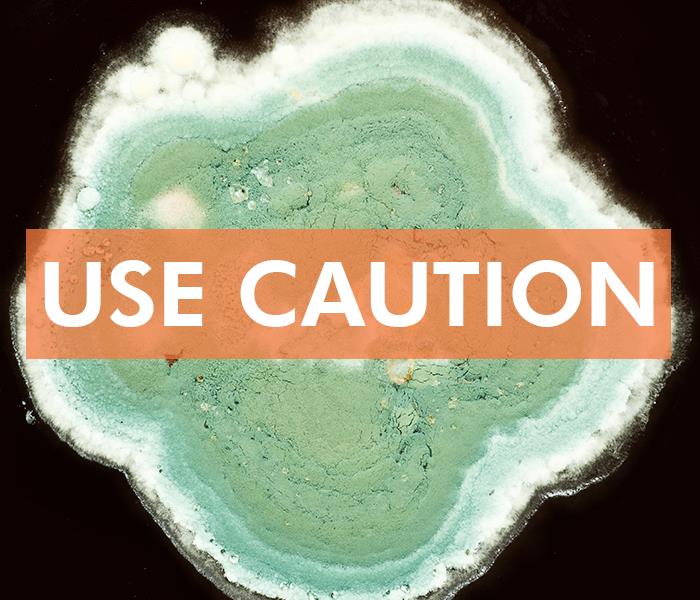 Take precaution with Mold.
Take precaution with Mold.
Bread Mold
Bread mold is a common issue that most homeowners have come across, but it may be something that they do not entirely understand. How many times have you gone to make a sandwich to find that 3-day-old loaf of bread fuzzy and discolored? Mold is not a complex organism, but it can be dangerous.
1. Cause of Mold
The fungus does not discriminate between hot and cold climates. You may find moldy bread in your drawer, or you may even discover fridge mold. The truth is that mold is a living organism that enjoys cool temperatures in dark and damp spaces. While a drawer is not necessarily damp, bread does have enough moisture and nutrients to make this particular organism happy.
2. Avoiding Ingestion
Bread mold has been known to make people sick, and every level of precaution should be made when coming into contact with mold. While it is not necessarily deadly, people can be allergic to mold, and the taste and smell can make you vomit. It is true that some molds are poisonous, but mold on bread is likely harmless to your long-term health.
3. Basic Safety
Mold can create problems if ingested, so you may want to follow basic safety precautions if you have to handle it. First, don’t smell it because it may cause respiratory issues. Second, seal it in a plastic bag or leave it in the bread bag tied off. Third, if the mold came into contact with any surface, clean the area. Finally, check that the mold did not spread.
4. Treating Underlying or Spreading Conditions
While moldy bread is common, it is not always the source of fungus growth. It is possible that a leaky pipe behind your kitchen cabinets has caused the initial fungus which has now spread into your bread drawer. If you suspect that there may be a larger underlying issue, then you may want to contact a mold remediation specialist in the Hamilton, OH, area to clean and restore your home.
Bread mold is a common household problem and one that is typically independent of other issues. However, you should still take precautions to avoid potential illness.
Potential Effects of Water Leaks on Building Materials
1/15/2019 (Permalink)
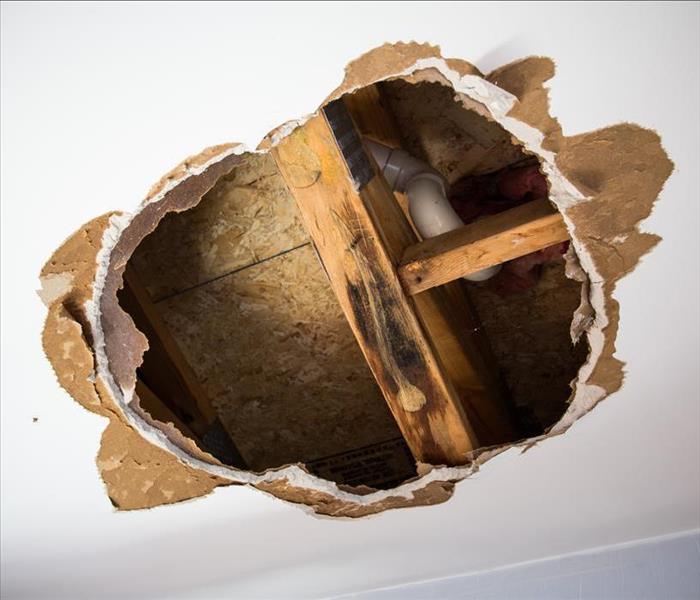 Ceiling damage due to a broken pipe in a Ross, OH home
Ceiling damage due to a broken pipe in a Ross, OH home
A broken pipe in your home in Ross, OH, can cause significant water damage. This is particularly true if you don’t notice the problem when it first occurs or you don’t call for repairs right away. Signs of damage can include swelling wood, water stains and even mold. The longer the excess water is in contact with your house’s walls, support beams, flooring and ceiling materials, the more damage you are likely to see.
Choose Timeliness
If a supply line breaks, a lot of water will probably spill out and start pooling. It doesn’t take long for problems to manifest:
- The first few minutes - water can spread or cause rugs or other textiles to stain floors and walls
- The first few hours - wood frames and drywall start to absorb water and swell
- The first few days - clean water becomes gray water and may start to foster mold growth
As you can see, if you don’t get the problem resolved quickly, swelling wood is only one of the potential effects with which you may have to contend. The sooner water restoration specialists can assess and address the problem, the fewer problems you may end up having.
Minimize Risk
If the walls of your home are merely wet, avoiding additional damage may be as simple as drying them off. If your building materials have taken on water and started to expand, however, technicians must tear out the affected walls and beams and replace them with new, unblemished material. To minimize the risk of this happening, turn off the source of the water and hire someone to perform water pipe repair as soon as possible. Then you can focus on removing water and restoring your structure.
It doesn’t take long for a pipe or supply line break to result in swelling wood beams or saturated drywall. By addressing the leak quickly, you may be able to save your home from further damage.
Fire Remediation: Where Did All the Water Come From?
1/8/2019 (Permalink)
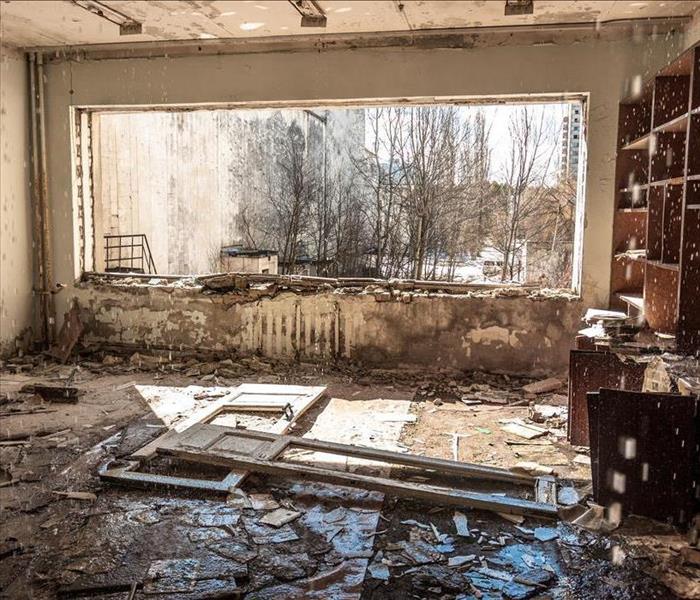 Water damage after a fire in Trenton, OH
Water damage after a fire in Trenton, OH
Fire Remediation
It is odd to consider water cleanup in association with fire remediation, but it is a common pairing. After experiencing a business fire, it can be hard enough dealing with the charred remains of your property, but to also find water damage in areas that weren’t touched by the flames is frustrating and confusing. The fact is, firefighters take many precautions to ensure the safety of others.
1. Putting Out the Blaze
Depending on the size of the fire, firefighters may have multiple hoses aimed at your property within minutes of arrival. These hoses operate at 400 psi and douse the flames in gallons of water per second. Additionally, firefighters will break out windows surrounding the blaze to hit the fire from above and below, causing massive amounts of flooding within your building.
2. Limiting the Damage
In an effort to limit the damage of a fire, firefighters will attempt to contain the fire to the initial area. However, this means that they will likely break through windows and doors of other rooms, flooding these areas with water to prevent the fire from spreading throughout the building but simultaneously expanding the water cleanup in its aftermath.
3. Restricting the Spread
Beyond dousing unaffected rooms, firefighters will soak the exterior of your property to limit the possibility of the fire jumping to surrounding buildings. This means your entire property is being doused, but it is a good thing. The water protects you, your property and your neighbors.
4. Walking Through the Facility
Once the fire is out, emergency services will walk your property looking for embers, using fire extinguishers on any remaining sources of heat. Between the hoses and the extinguishers, the fire cleanup is a massive undertaking requiring the assistance of a disaster restoration specialist in the Trenton, OH, area. These professionals are also experts in smoke cleanup.
While not often considered, water cleanup after a fire can be extensive. The fire hoses alone will contribute to a significant amount of water buildup, but when coupled with extinguishes and other suppression systems, it is likely necessary to hire a remediation specialist.
Broken Pipes: What Will Your Insurer Cover?
12/30/2018 (Permalink)
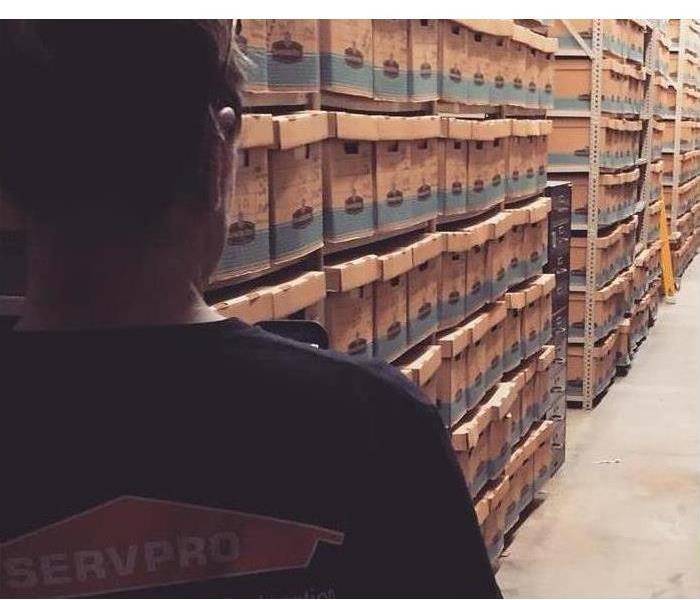 Restoring documents due to water loss in Hamilton, OH
Restoring documents due to water loss in Hamilton, OH
While every insurance coverage policy varies and is conditional, a sudden flood caused by broken pipes will likely be covered. However, that is dependent on the underlying circumstances and conditions that resulted in the pipe failure. In signing the insurance contract, homeowners make a promise to maintain their property, which means that whether you are covered depends on your commitment to that promise.
Sudden and Unexpected Breaks
Most insurers will cover sudden and unexpected breaks, meaning that there was no way to predict the mishap. However, many insurance companies have certain expectations for upkeep. Therefore, it is a good idea that you keep all receipts from inspections and repairs to prove that negligence was not a part of the pipe failure.
Secondary Damage
For flood claims that pass muster, an insurer will likely cover secondary damage as well. Secondary damage refers to any items that were harmed because of the water buildup or broken pipe — for instance, carpets, furnishings, artwork, important documents and any other material or equipment that may have been harmed.
Possible Prevention and Restoration
In addition to covering damage, many insurers will provide funds to fix a broken pipe, restore the damage, and even upgrade elements to prevent a potential disaster in the future. As these are significant expenses, your insurance provider may require you to get several quotes and estimates from emergency restoration companies in the Hamilton, OH, area. These companies are typically one-stop shops for all of your restoration needs, either handling your case entirely in-house or helping to facilitate contracts for renovation efforts.
A flood caused by broken pipes and leading to water damage is a significant problem for homeowners, but homeowner’s policy agreements usually protect them in these instances. As long as the homeowner can disprove negligence, if not already apparent, then an insurer will likely have no issue approving coverage on your insurance claim.
Steps Kids Can Take to Safely Escape a House Fire
12/30/2018 (Permalink)
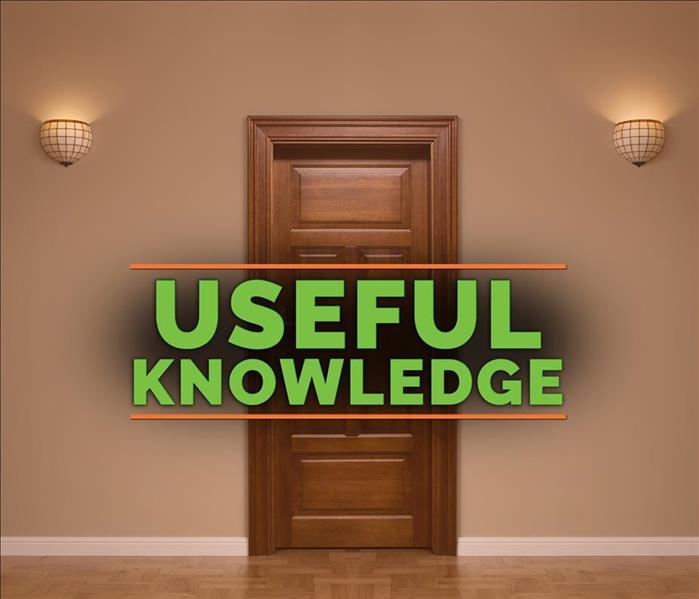 Closing all doors in your home at night can help slow down the spreading of potential fire within your home
Closing all doors in your home at night can help slow down the spreading of potential fire within your home
It’s impossible to put into words the helpless, awful feelings you would feel if your home were to catch on fire. This is an event everyone dreads and hopes they never have to experience. If this terrible situation arises, however, kids’ safety is most critical. This is why it’s vital to teach your children how to quickly and safely get out of your Oxford, OH, home if you detect a fire.
First Steps
At the moment you know there is a fire in your home, you should think of your well-being and of your kids’ safety. Before you do anything, make sure everyone in your house knows about these vital steps:
- Have a predetermined meeting place.
- Call 911.
- Don’t go back into the home for belongings.
Crawl to Safety
One of the most effective escape methods to teach to children if a home fire occurs is the crawl. Smoke will rise, so it’s important to stay low. This will make it easier to breathe and to see where exits are. Teach children to get on all fours with their heads down to the floor. Alternatively, children can put their bellies on the floor and use their forearms and legs to move on the floor like a snake. This method is effective if the heat is especially intense.
Check Doors
Often, a house fire will start when children are sleeping in their rooms or when family members are in another room in the house with the door closed. A proper fire escape in these situations is most likely if children will learn to first press the backs of their hands up against the door. If the door is hot, kids shouldn’t open the door. If the door is not hot, make sure your kids know to slowly open the door a little and examine the area. If it’s safe to proceed, they may crawl out.
To ensure your kids’ safety, make sure they understand these guidelines. You can then have peace of mind everyone is safe and sound by the time firefighter and fire cleanup experts arrive.
How Water Mitigation Works
12/30/2018 (Permalink)
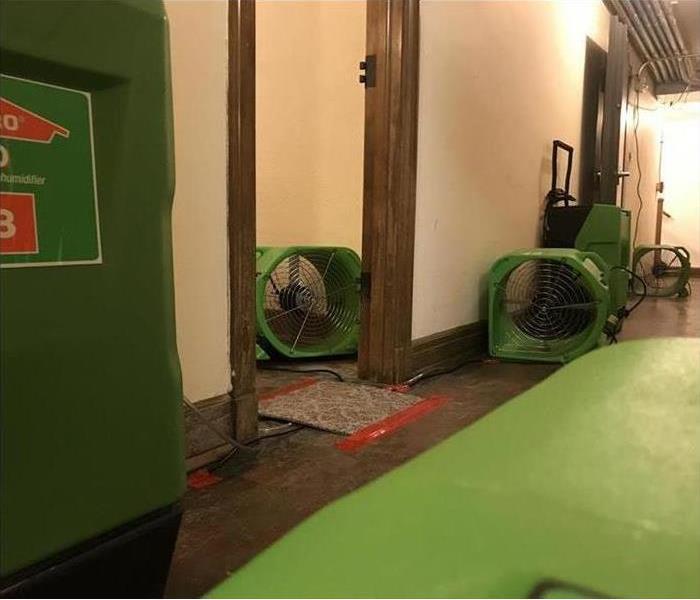 Dehumidifiers and air movers placed to dry out a business in Hanover Township, OH
Dehumidifiers and air movers placed to dry out a business in Hanover Township, OH
Water Mitigation
If there's a water emergency at your Hanover Township, OH, business, whether from a broken pipe, a supply line leaking or a toilet backup, it's a good idea to call a professional water mitigation company. A sewer backup or pipe burst cleanup needs to be handled by these remediation experts, who can quickly diagnose the situation. They can completely take care of the water cleanup and make sure that any threat from pathogens, such as black mold, is eliminated.
Following the steps outlined below, the water mitigation company can efficiently eradicate your problem before it causes even more damage.
1. Inspection and Diagnosis
The water mitigation company can come out to your building right away to complete an inspection and sample the water to see if pathogens might be present. Based on their diagnosis, they then determine which specialized equipment and techniques to use.
2. Removal of Building Contents
Next, they remove any items, such as furniture, business equipment or important documents, taking them to a dry place out of harm's way. The items are then sorted through to see what can be saved. Any salvageable items are completely dried, cleaned, sanitized and deodorized.
3. Water Extraction
As soon as everything has been removed, the extraction of standing water and moisture can begin. Different kinds of specialized equipment and techniques may be used, depending on whether it's a pipe burst cleanup, removal of sewer water, or a supply line cleanup.
4. Dehumidification
Once all excess water is removed, heavy-duty dehumidifiers and air movers are put in place. This ensures that all hidden moisture is removed and that everything is thoroughly dried out.
5. Restoration of the Building
At this point, any necessary cosmetic and structural repairs are made. The process may be as simple as painting and replacing drywall, or may entail the reconstruction of entire rooms of the building, depending on how bad the damage is.
Whether you need sewer backup damage repair, a pipe burst cleanup, or other water damage cleanup, a professional water mitigation company can help you. They can quickly get the problem under control and get your building back to normal.
3 Ways To Slow the Spread of Mold After a Flood at Your Business
11/27/2018 (Permalink)
 Fleet in Trenton,OH ready for mold
Fleet in Trenton,OH ready for mold
Actions to Take Before Service Technicians Arrive
When a flood affects your Trenton, OH, business, there is much to consider when it comes to cleanup efforts. Draining standing water and salvaging important equipment is probably a priority for you; however, once flood waters are removed, you could be facing a major black mold problem as soon as 24 hours later. Calling in service technicians who know how to handle the cleanup is vital, but there are a few actions you can take before they arrive.
1. Turn Off the Air Conditioner
Switching off your building’s air conditioning system can stop the spread of mold spores in two ways. First, a lack of air flow will likely slow the speed at which they move through the air ducts. Secondly, it will be more difficult for the spores to find and travel to moist areas where they can settle and multiply.
2. Open Windows
While it is difficult to stop the spread of black mold when you already have a moisture problem due to a flood or a pipe break, airing out affected rooms and allowing trapped humid air to escape can lower the moisture levels in these areas. Open as many windows as possible and direct electric fans toward the center of the room to push humid air out.
3. Turn Off the Water
It is a good idea to turn off the building’s water until your mold cleanup service arrives and the technicians can survey the damage. This can be especially important if the flood was caused by a burst pipe or water line. The fewer puddles of standing water there are in your building, the lower the risk for mold to form. Be sure you know where the main water shutoff valve is before a water emergency so you can act quickly.
Flooding at your Trenton, OH, business can cause considerable damage. However, when you know how to slow the spread of black mold and other types of fungi in the aftermath, you could help your business recover faster.
Flood Cuts and Their Importance to Water Damage Restoration
11/18/2018 (Permalink)
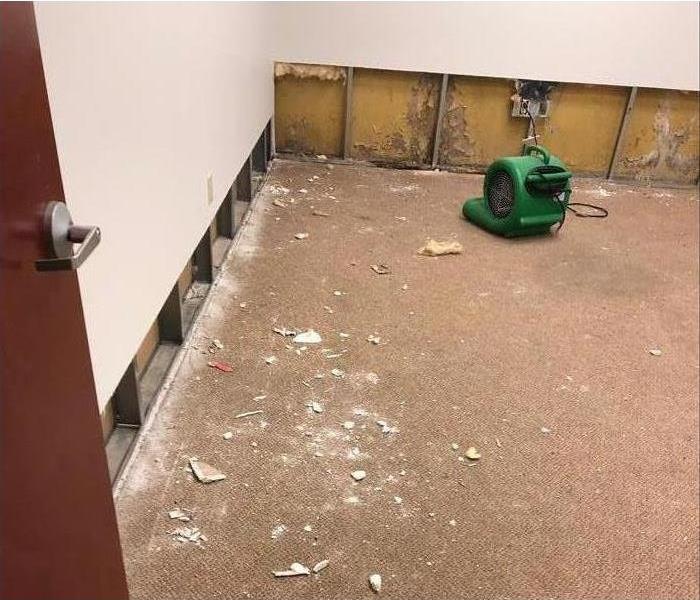 Flood cut in a Township,OH home due to a water loss
Flood cut in a Township,OH home due to a water loss
When flooding impacts your Township, OH, home, the list of repairs can be considerable. From draining away standing water to salvaging furniture and other belongings, there will likely be much to do when it comes to restoration. Repair technicians might recommend performing a flood cut to ensure your home’s interior walls are not damaged, which can prevent costly repairs in the future.
What Is a Flood Cut?
Flood cuts are typically performed when contaminated water enters a room and rises beyond floor level. When flooding affects your home’s walls, it can cause a variety of problems that include:
- Rotted insulation
- Mold growth
- Drywall and wood rot
To prevent these issues, flood technicians cut into the drywall of a flooded room, approximately 12 inches above the flood line. This allows them to inspect the interior wall, drain out water that may have seeped in and remove any wet insulation.
Why Is a Flood Cut Important?
Outdoor flood waters often contain contamination that can include human and animal feces, sewer chemicals and other hazards. A drywall tear out can help flood damage and restoration company workers gauge the severity of the flood and whether components behind the wall will need to be replaced due to the presence of dirty water. In some cases, electrical wiring may have to be removed and replaced, and this type of damage can be difficult to detect without a flood cut.
Is a Cut Necessary for All Floods?
While minor floods may appear harmless, they can still affect your interior walls. Even water that comes from sanitary sources can soak drywall and damage insulation, which must be replaced once it becomes soaked. Ask your flood technicians about whether a flood cut is necessary, no matter the source of the water.
When flooding affects your Township, OH, home, the list of repairs will likely be substantial. Understanding the importance of a flood cut can help you feel more confident about the restoration process and the future condition of your property.
How To Keep Mold Growth at Bay After Residential Flooding
10/4/2018 (Permalink)
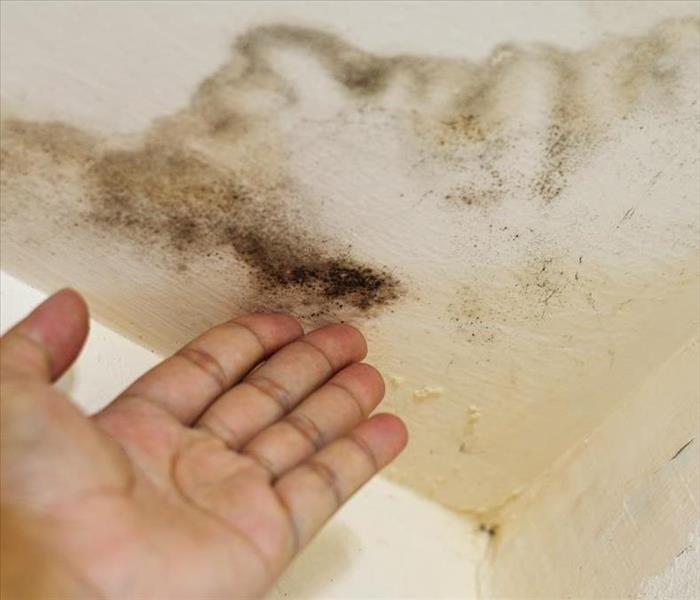 Mold in Hamilton
Mold in Hamilton
Recovering from a flood in Hamilton, OH, can be a stressful experience as you work quickly to salvage and restore the affected parts of your home. While you race to save valuable items, mold can develop across the house and become an even greater problem. Some areas are especially prone to mold growth:
- Wooden furniture and other porous surfaces
- Microwaves, washers, dryers, and other home appliances
- Insulation and drywall
By prioritizing some steps of flood recovery, you can stop mold from becoming a nuisance, make the recovery process much easier to complete, and avoid a lengthy mold removal process altogether.
Remove Standing Water First
Because any area with stagnant water poses an increased risk of mold growth, it is crucial to remove any leftover water from the house as quickly as possible. Ideally, you should clear the house of sitting water within 24 hours of the initial flooding to minimize mold damages and make the rest of your recovery work simpler.
Focus on the Floors
Flood water can easily seep below the surface of your floors and create large areas of mold beneath them if not properly dried. Depending on the type of floor affected, you may be able to save carpets and other porous surfaces if you can treat them quickly enough. A water damage restoration company can help you decide whether a floor needs repair or replacement.
Keep an Eye out for Growth
No matter how well you attend to water damage, your house will remain at a heightened risk for mold growth following a flood. As you settle back into your home, stay watchful for mold, especially in dark, warm places. If left untreated, these small patches of mold can quickly spread spores throughout other parts of the house, putting a damper on your restoration efforts.
If your home sustains water damage after flooding, work quickly to minimize the extent of the destruction. Eliminate standing water, treat flooring materials immediately, and watch for the growth of mold. Contacting a professional for help can make the recovery process easier.
3 Reasons Rain May Lead to Mold Growth
9/24/2018 (Permalink)
Black mold can show up in your Oxford, OH, house seemingly overnight. Have you noticed a connection between rainy days and mold growth? There are a few instances when rain can lead to mold popping up in your home.
- Faulty Roof.
- Bad Foundation.
- Poor Attic Ventilation.
No matter what issue has caused your moisture problem, you need to get to the heart of the issue. Wiping away the surface mold won't help you rid your home of the fungus. Instead, you need to call in a professional mold cleanup crew.
Rain sometimes exacerbates issues with your home. If you notice black mold pop up after every downpour, it could be tied to a bigger issue with your house.
Reasons You May Have Mold
9/24/2018 (Permalink)
If your roof is missing shingles, it may not be able to keep water out of your home like it should. This can lead to water buildup in your attic or drips down your walls, which invites mold spores to make a home.
Cracks in your foundation could be another way excess moisture makes it into your home. During the rain, the falling water goes into the ground and starts to travel. If your foundation isn't properly sealed, the water can find its way into your home.
When the attic does not have proper ventilation, condensation can start to build up in the space. Even condensation is enough of a moisture problem to allow black mold to make a home.
Weather stripping around windows and doors can become cracked and faded over time. When it rains, the water may seep its way into these crevices. Mold may start to build up around your windows and doors because of the trapped moisture.
Heavy rains can lead to too much water for an environment. When this happens, floods can fill your basement or garage. Flooding is a common cause of mold growth.
Restoring Items Constructed From Non-Porous Materials
9/24/2018 (Permalink)
Not all methods can be used for cleaning all materials. Dry-cleaning should not be used for some items. For example, non-porous materials should be cleaned by using an ultrasonic cleaner. An ultrasonic cleaner uses ultrasound and a cleaning agent to clean damaged items. Cleaning with ultrasound can be useful for preserving an abundance of objects such as jewelry, electronic equipment, and vinyl records.
Cleaning Electronic Items
In the event that personal belongings are moved to content storage during post-fire home renovation, it is wise to keep in mind that time is of the essence when cleaning electronics. After smoke or soot has invaded electrical items, acid that is contained in the smoke residue can begin to corrode metal surfaces. While dry-cleaning clothing may be more of a priority after an in-home fire, electronic items will be hazardous to operate prior to a thorough internal and external cleaning. Local Hamilton, OH, professionals may be able to assist in the smoke and soot removal from electronic devices.
If proper content cleaning methods are employed items can be saved after a home fire.
Change of Plans: Keeping Your Cool When Your Flight Is Canceled
9/18/2018 (Permalink)
 Vehicles ready for any storm damage in Oxford, OH
Vehicles ready for any storm damage in Oxford, OH
Sometimes when you make travel plans to go on a trip or visit family, Mother Nature has other plans. A delayed or canceled flight is a more common occurrence during storm season. If you plan to travel during seasons where bad weather is possible, here are some storm tips for staying calm and making the best of your altered schedule.
Make a Plan
Preparing for storms starts before you book your flight. There are some factors to take into consideration when planning your trip:
- Weather forecast, not just for your home in Oxford, OH, but also for the path your flight will take
- List of hotels in the area
- Extra cash or credit available for emergency accommodations
- Cancellation policies on your destination accommodations
If you receive notice of a delayed or canceled flight after you've booked, you can still benefit from planning ahead. Pack light so that you don't have to worry about checked luggage as plans shift. Leave for the airport as if the flight is still on schedule to compensate for other last-minute changes or increased traffic.
Stay in Control
Your smartphone is your best friend when flight plans change at the last minute. You can keep the airline's number and an app for easy hotel booking so that you can skip lines, ask for compensation for your inconvenience and arrange alternate flights and stays from wherever you are. It is also a good idea to keep contact information for a local storm restoration company in your phone just in case you get reports of damaging conditions while you are away from home and need to get on their service waitlist.
Late changes in your schedule caused by a canceled flight can be frustrating, but they don't have to completely derail your plans. By planning ahead and taking measures to make sure you stay as in control of your schedule as possible, you can alleviate some of that stress.
Mold Prevention: It's Easier Than You Think
9/11/2018 (Permalink)
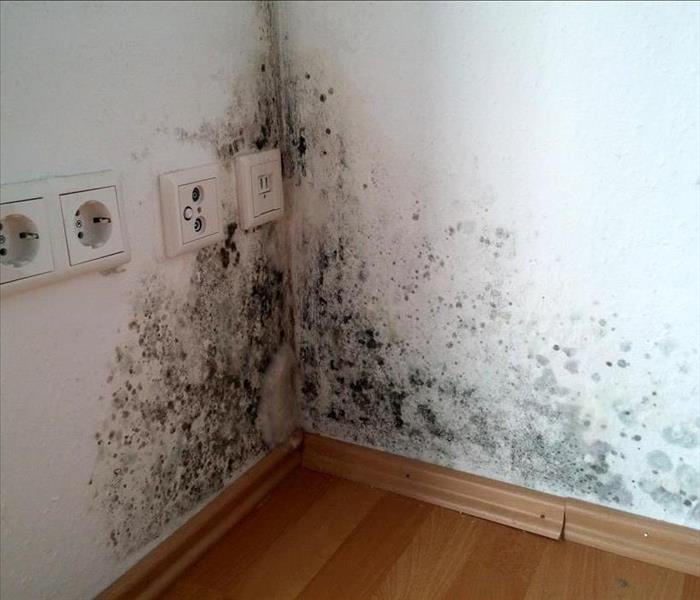 Mold damage in Hamilton, OH
Mold damage in Hamilton, OH
Mold damage can be costly to remediate, and if allowed to spread, it can cause irreversible damage to your home. For this reason, you want to take measures to stop it in its tracks or, better yet, prevent it entirely. There are nine mold prevention steps you can begin doing today to prevent growth and to preserve the integrity of your home:
- Identify problem areas and correct them immediately.
- Dry wet areas as quickly as possible.
- Equip rooms prone to moisture buildup with adequate ventilation.
- Equip your home with mold-resistant products.
- Monitory indoor humidity levels.
- Clean or repair gutters.
- Direct water away from your home.
- Keep mold off household plants.
- Improve airflow in your home.
When you follow these nine steps, you can better keep dreaded house fungus at bay.
Inspection Is Key to Mold Prevention
Mold thrives in moist environments, which is why you need to regularly inspect areas in which there is a lot of moisture. These include bathrooms, laundry rooms, basements and beneath any sinks. If you discover water damage, a leak or another moisture issue, correct it immediately and then dry out the area. This step is crucial in preventing mold.
Home Improvement Helps
You can also prevent mold growth by outfitting your home with all the right equipment. This includes dehumidifiers, adequate ventilation systems and mold-resistant products.
There are improvements you can make to the exterior of your home to keep mold at bay as well. For one, direct water away from your home. This may require regrading your landscape. Make sure your gutters are in good working order and clean year-round. This can help prevent water from sitting on your roof and causing costly damage.
Mold prevention is a necessary evil of homeownership. If you want to preserve the integrity of your Hamilton, OH, home, implement the above measures and work with a mold remediation expert who can provide advice and help as necessary.
Securing a Building After a Fire
8/28/2018 (Permalink)
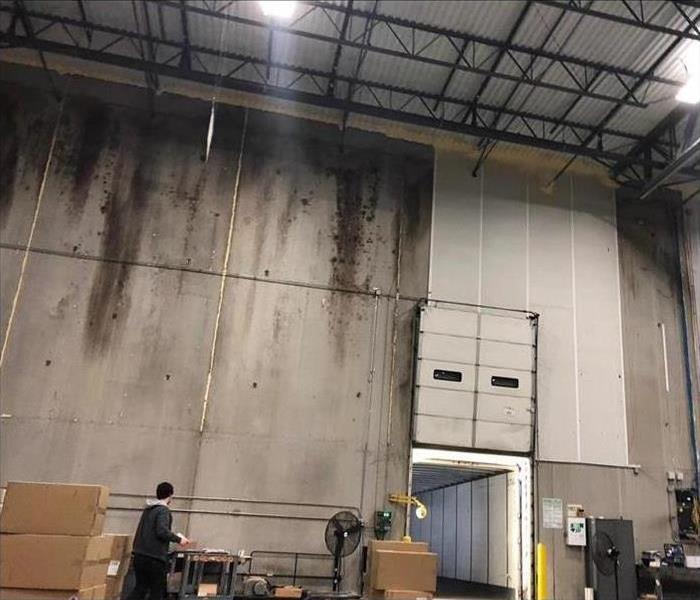 Fire damage on a factory in Ross, OH
Fire damage on a factory in Ross, OH
If you suffer the misfortune of fire damage at your Ross, OH, building, there are collateral concerns that are often an aspect of the disastrous experience. As incomprehensible as it may seem to good-hearted, law-abiding people, there are others who will resort to looting without a thought of the insult they add to your injury. That is why it is important to secure your building in the days, weeks and perhaps months it takes to make your building whole again.
Why and How to Secure Your Damaged Building
In addition to the threat of looters who could carry away valuable property, vandals might seize the opportunity to enact their own brand of criminal mischief. Mother Nature might be tempted to get in on the act as well, sending rain, snow, hail or winds to exacerbate the fire damage. Protect what is salvageable by boarding up:
- any openings in the roof
- missing doors and windows
- holes in walls, floors and ceilings
- bulkheads or other means of access
An unsecured building damaged by fire can become an attractive nuisance, and anyone who enters without your permission could become injured. Moreover, folks with legitimate reasons to be in or near the building such as insurance adjusters and assessment and restoration consultants hired to organize fire cleanup, fire inspectors and others will need to be protected as they work the site. Whether the building is in an urban, suburban or rural area, it is vital to keep out the curious, the criminal and the careless.
Accomplishing the remediation of fire damage to your building may well be more of a marathon than a sprint. A methodical approach is best and begins when everyone is safe, the fire is out, and the firefighters have left the scene. Secure your building with the help of professionals, tap into your well of patience and think positively as the restoration begins.
Homeowner’s Guide To Emergency Roof Repair
7/23/2018 (Permalink)
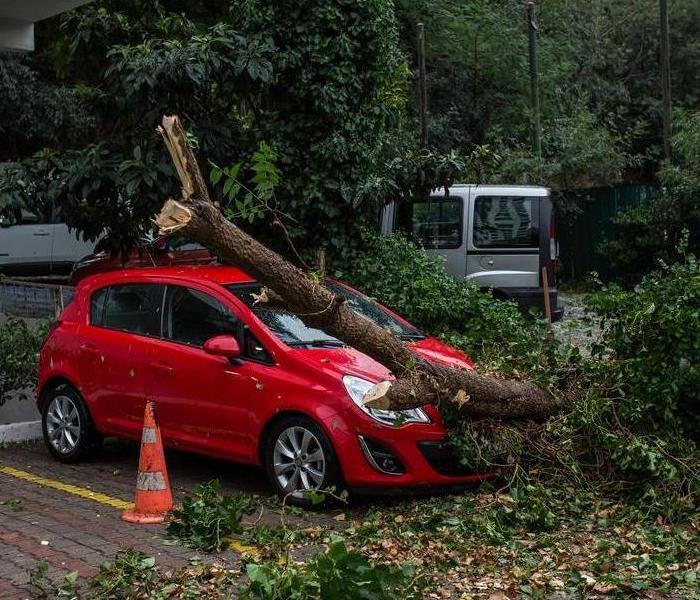 When unexpected storm, hail or wind damage befalls your home in Hamilton, OH, be prepared to act fast.
When unexpected storm, hail or wind damage befalls your home in Hamilton, OH, be prepared to act fast.
High winds, hail, and storms in Hamilton, OH, can cause significant roof damage. As a homeowner, you may know little about roof repair and even less about the process of mitigation. What is mitigation? When it comes to storm and wind damage, mitigation refers to the steps you need to take to stop additional loss from happening to your house before repairs begin.
How To Mitigate Roof Damage
Always prioritize your safety first. If high winds cause a tree to fall on your house, for example, evacuate and seek shelter elsewhere. Observe damage from the ground; do not climb onto the roof to inspect it yourself. Once you are safe, take the following steps to reduce secondary damage to your home:
• Install a tarp on your roof to prevent additional rain, hail and wind damage. The tarp remains on during the inspection and roof repair process. Contact a restoration company that offers emergency, professional roof tarping services. Until the professionals arrive, place buckets under the leaks to prevent further water damage.
• When a tree falls on the house, contact a tree service to remove the tree as soon as possible before the tarp is installed.
• If windows or skylights have broken, tape plastic over the openings until the glass is replaced.
How To Complete Restoration
After you have successfully mitigated the damage, take the necessary steps to complete the repairs:
• Contact a roofing company to repair the damaged areas.
• Address the water damage in your home. Work with a water restoration company to inspect, dry and restore your house and belongings.
• Check with your homeowner’s insurance agent to see if damages are covered under your policy.
When unexpected storm, hail or wind damage befalls your home in Hamilton, OH, be prepared to act fast. Immediately have a restoration company install a tarp to mitigate further problems. Promptly complete the roof repair and address any water damage that occurs inside your home. For more information, visit http://www.SERVPROwesthamiltonoxford.com/.
4 Important Parts of an Emergency Plan
6/19/2018 (Permalink)
As a business owner in Hamilton, OH, you have to know what to do no matter what the situation. This means you often prepare for worst-case scenarios. A business continuity plan can help keep your business running even if there is major storm damage, flooding, mold growth or fire in your commercial building. If you want to make this type of emergency plan for your business, try to include the following parts.
1. Emergency Response Plan: Your continuity plan should go over how you and your employees should respond in an emergency. You may want to think about evacuation routes and meeting places as well as which commercial mitigation team you would call. You may also list contact numbers for your insurance representative.
2. Temporary Business Options: Some disasters may affect your ability to keep your company running. Floods could damage inventory or equipment, which leaves you unable to meet customer needs. Storms could leave your building uninhabitable for a time, which would leave you without a place to work. Your plan should go over how you would address these temporary setbacks.
3. Recovery Strategies: In some cases, you may need to recover sensitive information after disaster strikes. Your business continuity plan could include a section on how you would restore electronics or save important files.
4. Training Plan: Not only do you have to know what to do in the event of an emergency, but your employees also have to know. You may need to conduct regular safety trainings to ensure everyone is familiar with the protocol laid out in your emergency response plan. These trainings can include practice evacuations, fire safety tips and other workplace safety information.
Creating an expansive business continuity plan can help you be better prepared for any disasters that come your way. While this type of plan can cover a lot of scenarios, you still need to be prepared for handling an unforeseen issue. For more information, visit http://www.SERVPROwesthamiltonoxford.com/.
Preparing Your Business for Bad Weather: 3 Storm Protection Tips
6/13/2018 (Permalink)
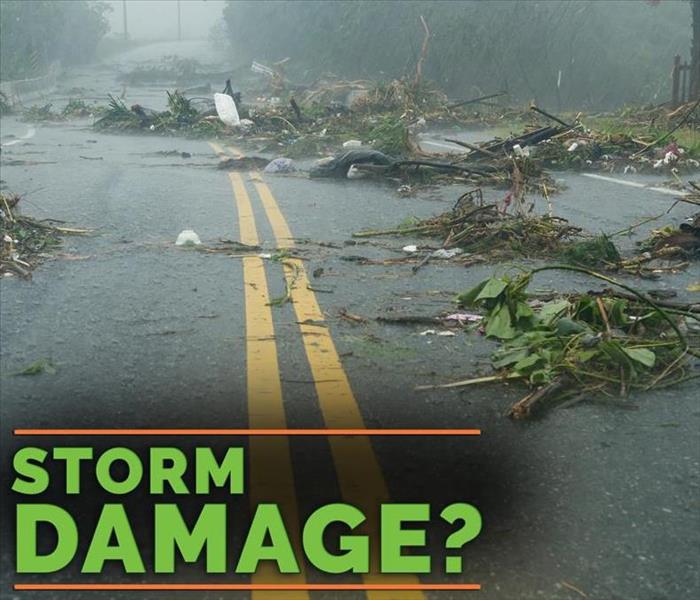 A heavy storm in Hamilton, OH, can have a serious impact on your business.
A heavy storm in Hamilton, OH, can have a serious impact on your business.
When bad weather strikes Hamilton, OH, it can seriously impact your commercial building and business operations. Power outages, cracked plumbing pipes, and roof damage can all occur during a heavy storm, causing hundreds or even thousands of dollars in damage. However, being prepared for bad weather may help protect your business and prevent loss of time, money and inventory. If bad weather is approaching, there are several steps you can take beforehand to ensure your building is equipped to withstand it.
1. Have Your Building Winterized
Having a pipe break in your breakroom or bathroom because of lower temperatures can not only be surprising, it may cause a serious flood. However, preparing your building for cold weather may help prevent this type of disaster. Working with a storm damage and restoration service might help you understand which areas of your property might be vulnerable during cold weather so you can have insulation added where necessary.
2. Be Aware of Weather Conditions
Once temperatures start to plummet, it is wise to track the weather and be aware of any storms that might be approaching the area. If a winter storm is projected to be especially powerful, you can prepare by shoring up your building’s windows with plywood to protect them from high winds and flying debris. Move any outdoor furniture or décor inside and store it away, and roll up your building’s awning to prevent it from tearing.
3. Have a Storm Plan in Place
Preparing your employees for bad weather can help your business teams act quickly in case a storm strikes during operational hours. Have an evacuation plan in place and discuss what protocol each individual should follow in case of a blackout. Being prepared can keep everyone safe when bad weather threatens the area.
A heavy storm in Hamilton, OH, can have a serious impact on your business. However, when you stay vigilant and prepared, you and your employees can act quickly to protect yourselves and your property. For more information, visit http://www.SERVPROwesthamiltonoxford.com/.
Is Indoor Mold Growth Related to Rain?
5/15/2018 (Permalink)
 You can’ t just wipe things down after it rains and hope for the best.
You can’ t just wipe things down after it rains and hope for the best.
It seems strange, but every time it rains you see a fresh spate of mold climbing up your walls or down the back of your toilet. Is the mold caused by the rain? Are you seeing causation without correlation, or is the mold growth actually related to rainy weather in Hamilton, OH?
It’s Not the Rain, It’s What the Rain Causes
If your house was leak-proof and airtight, you’d never have a problem with mold. But if you have a leak or other structural issues, every time it rains your house is suffering water damage. Mold, black mold in particular, thrives where you have a moisture problem. So, in a way, the rain is causing your mold problem, but your real issue is:
• Water from rain storms leaking in through roofs and windows, or even blowing through improperly sealed doors
• Standing water in rain gutters possibly seeping into wood or roof tiles
• Flooding creating standing water that fuels black mold
• Water damage from leaks softening and rotting insulation, drywall, and wood to create a nest for mold to proliferate
• Water damage leading to additional breakage and leaks in interior pipes and fixtures, causing more water damage and compounding the issue
So How Do I Prevent Mold When It Rains?
You can’ t just wipe things down after it rains and hope for the best. For mold cleanup and remediation, you need to act quickly to eliminate the source of the leak and water damage, and get rid of the mold. Black mold removal can be tricky, but it is definitely possible with the right assistance. Once you get rid of mold, the key is to prevent it from coming back by remaining diligent about the conditions that led to mold growth in the first place. You can prevent mold by ensuring any moisture issues are handled quickly and efficiently. For more information, visit http://www.SERVPROwesthamiltonoxford.com/.
Will water damage hardwood floors?
5/4/2018 (Permalink)
If you live in a home with hardwood floors, and have a water loss in your home, you could be looking at severe damage.
Every situation is uniquely different. In some cases if it is detected quickly and there is access to the subfloor through a crawl space, the floors can be dried in place.
However if the floors begin to buckle and pop out, it could be too late to restore in place. In that case the damaged wood, would have to be removed and the subfloor and surrounding area would need to be dried. Once the drying is complete, the floors can be replaced and the floors can be refinished to match.
SERVPRO is able to help from start to finish. If you have any questions, feel free to reach out to us at anytime.
Trauma Scene Cleaning
3/14/2018 (Permalink)
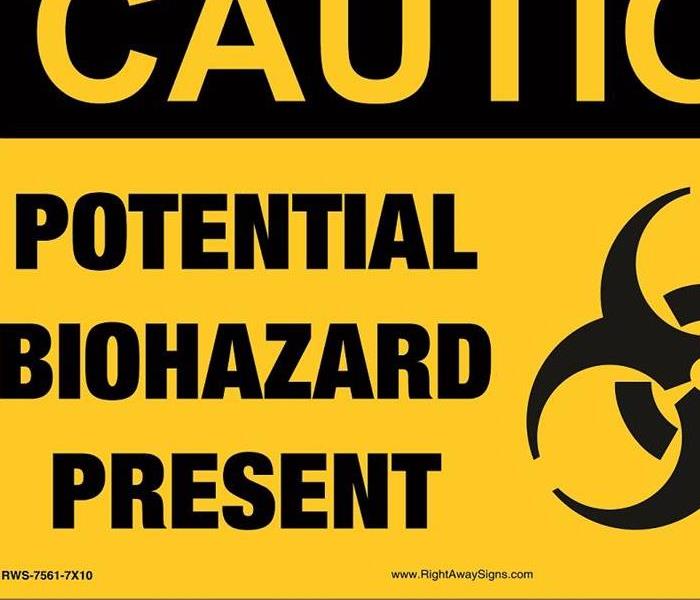 SERVPRO of West Hamilton/Oxford is your areas leader in trauma scene cleanup
SERVPRO of West Hamilton/Oxford is your areas leader in trauma scene cleanup
The management staff at SERVPRO of West Hamilton/Oxford maintain a strict training program to keep up with the industry changes regarding hazardous material cleanup and restoration. The technical side of trauma bio contamination remediation is pretty black and white however the emotional side is where out team truly shines like no other. We pride ourselves on removing any dangers for the property owners while doing so in the most compassionate way possible. We are the industry leaders in insurance claim repair work. Many homeowners don't realize that this type of work is typically covered under their insurance policy. SERVPRO of West Hamilton/Oxford is here to help that process along so you don't have to. SERVPRO being on the job guarantees quality workmanship, a caring crew and professionalism to return home or business to "Like it never even happened."




 24/7 Emergency Service
24/7 Emergency Service





































































































